Warrior Life
El Camino College Spring/Summer 2023
COMMUNITY ROOTS
A multicultural woman brings communities together via Social Justice Center

A STREAM CRIES FOR HELP
Trapped in a grave of cement, Dominguez Channel struggles to survive
SIMPLY THE BEST Filipino food, matcha, pizza and dog parks
THE NAKED TRUTH
Art models bare all
JORDAN TO THE SOUTH BAY
Student government president advocates for immigrants and refugees
TABLE OF CONTENTS
5-9
BREAKING STANDARDS
Military officer recounts her experiences as a Black female overcoming racial misconceptions and live a life of service
10-11
INTERTWINED BY MIRACLES OF NATURE
Dogs in my life: A second opportunity to do things right
12-21
JUSTICE FOR COOKIE
How the murder of Juan Hernandez turned his mom into a powerful leader in the growing movement to heal families and communities
22-25
TAKING THE STAGE
El Camino English Professor converts markers in class to drum sticks for band gigs
26-29
TOP 5 HAUNTED PLACES CLOSE TO ECC
From Downtown L.A. to the South Bay, here’s where you are most likely to encounter a ghost
30-31
LOVE BEYOND BARS
My boyfriend was incarcerated. It felt like I served time too
32-37
FOOD & COMMUNITY CALLING
Chasing after new adventures, a couple stumbles on a place like home
38-39
WHO AM I OUTSIDE OF PLAYING SPORTS?
Switching my dream of professional sports to sports writing
40-41
FILIPINO FOOD GALORE
Here’s some of the best local Filipino restaurants and eateries near El Camino College
42-49
A STREAM CRIES FOR HELP
Trapped in a grave of cement, Dominguez Channel struggles to survive
50-53
MY LIFE AS AN OYSTER
Searching for gender identity
54
THE NOT-SO-SPICY VACA FAMILY SALSA RECIPE
For those who want to indulge in the taste of a pico de gallo salsa, without the heat, try the Vaca family’s not-so-spicy, not-so-secret recipe
55
MATCHA LOVERS LOCAL GUIDE
From lavender to strawberry, there are delicious ways to drink matcha latte
56-61
COMMUNITY ROOTS
A Bolivian and Puerto Rican woman creates strong roots of community wherever she goes
62-63
IT’S BEEN FIVE YEARS AND I STILL LIKE HIM
Nothing has happened between us, but maybe one day
64-65
A PHOTOGRAPHER’S REFLECTION
My mom’s death was devastating for me as a kid. Now I cover the tragedies of others for the news
66-68
MY GREEN MONSTER OCD
How OCD has affected my everyday life
69
GRAB A SLICE
The Top 5 pizza shops to get a slice near El Camino
70-73
FINDING A CAREER THROUGH DANCE, ONE STEP AT A TIME
For Professor Daniel Berney, dance is more than just movement. It’s his passion.
74-75
BREAKING UP WITH A FRIEND AS AN ADULT
Reflecting on the good and bad of a friendship destroyed by insecurity
76-77
THROUGH FASHION
Unveiling student, faculty and staff expression
78-81
FROM JORDAN TO THE SOUTH BAY
Student government president advocates for immigrant and refugee rights
2 | Warrior Life
82-84
HOW I MESSED UP MY MOM’S MEMORIAL
The conversations, skills and wisdom I miss now that she’s gone
85
TOP 5 PUPUSAS IN THE SOUTH BAY
Need a new Central American food in your diet? Here’s where to try one of “las mejores”
86-90
CLASS DISMISSED
After 30 years in education, Humanities Dean Debra Breckheimer will retire from El Camino
91
BRING THE FLOWER POWER
Just in time for graduation season, here are the Top 5 flower shops within 5 miles of El Camino College
92-93
TEXTING DOES NOT EQUAL LOVE
Life lessons from a victim of a texting relationship
94-103
THE NAKED TRUTH
Art models inspire students to portray humanity on all its forms
104-109
A RESTAURANT REBORN
A Japanese restaurant closed down during the pandemic. Now, they’re back with a new Korean take on food
110-113
THE JOURNEYMAN
From playing to coaching and representing wrestling, the story of Tom Hazell
114-117
SNIFFING BUTTS HAS NEVER BEEN BETTER
Bob the Dog reports on the best dog parks close to ECC

118
DIFFERENT COUNTRIES, DIFFERENT ME
How moving to another country affected my personality and my social life
Warrior Life | 3
Warrior Life Staff
Writers Illustrators
Alexis Ramon Ponce
Ash Hallas
Brianna Vaca
Delfino Camacho
Hannah Bui
Jesus “Jesse” Chan
Johan Van Wier
Kim McGill
Ma. Gisela Ordenes
Matheus Trefilio
Nindiya Maheswari
Raphael Richardson
Safia Ahmed
Student Media Advisers
Stefanie Frith
Kate McLaughlin
Photographers
Alexis Ramon Ponce
Anthony Lipari
Ash Hallas
Brianna Vaca
Gary Kohatsu
Greg Fontanilla
Hannah Bui
Jesus “Jesse” Chan
Johan Van Wier
Khoury Williams
Kim McGill
Nindiya Maheswari
Raphael Richardson
Safia Ahmed
Photo Advisers
Chuck Bennett
Nguyet Thomas
Letter from the editor
Ash Hallas
Dylan Elliot
Fumie Coello
Ingrid Barrera
Kae Takazawa
Kim McGill
Patrick Morehead
Zamira Recinos
Editor-in-Chief
Elsa Rosales
Support Staff
Jack Mulkey
Jessica Martinez
The journalism program at El Camino College is truly something special. The support from award-winning advisers and support staff, and the collaboration among award-winning writers, photographers and illustrators makes this newsroom one of the best places to earn your certificate or degree. We hope you join us.
We appreciate all faculty, staff and students who were open to working with us to get this issue published and we hope you enjoy the result. These stories and more can also be read at www.eccunion.com.
Thank you,
Elsa Rosales
Warrior Life is a student-run magazine located at El Camino College, 16007 Crenshaw Blvd., Torrance, CA 90506. El Camino College students interested in being a part of the magazine must enroll in Journalism 9 for fall 2023 or contact Stefanie Frith at sfrith@elcamino.edu for more information.
4 | Warrior Life

Warrior Life | 5
El Camino College Assistant Director of Veterans Services Brenda Threatt relaxes against a cherry blossom tree on the ECC campus in Torrance, Calif. She has been a major in the California State Guard since 2009. (Gary Kohatsu | Warrior Life)
Breaking standards
Story by Safia Ahmed
Photos by Gary Kohatsu, Greg Fontanilla and Safia Ahmed
Entering the military as an older person, she wanted to do something for her country. In 2001, she was given the opportunity to assist the state following the 9/11 terrorist attack. She designed a commemorative license plate in honor of the victims and survivors, which has raised about $15 million in California to support anti-terrorism.
Major Brenda Threatt serves as an assistant director of Veterans Services at El Camino College. She is also a military officer, chaplain and ordained minister at the African Methodist Episcopal Church in Los Angeles. There are very few Black female chaplains, she says.
“It’s easier for people to stereotype than it is to learn about another person and accept them. That’s not just for veterans. It’s how society is with a lot of groups,” Threatt says.
Much of Threatt’s career has been in the veterans’ space. Her role at ECC requires her to manage the center and staff that supports the educational goals of student veterans.
Veterans Services identifies resources that provide veterans with career opportunities, housing and support.
Previously, she worked with homeless veterans in an organization she ran that housed nearly 400 veterans in need of housing.
“The way to prevent homelessness is to give someone the opportunity to have an education and career,” Threatt says. “So in my scheme of working with veterans, this is where you stop veteran homelessness at this stage.”
One of the greatest challenges she has faced at ECC was bridging the gaps between the veterans department and other departments. With Veterans Services, the overall leadership of El Camino has created a space of equity, diversity and inclusion.
“A challenge was helping people to understand and learn who the veteran student is,” Threatt says. “We’re not always going to get it right, but because the leadership is the tuning work, that keeps the
rhythm going.”
Threatt has worked at churches, nonprofit organizations and in city government. She began working as a veteran liaison for then Los Angeles Mayor Antonio Villaraigosa in 2008 and was asked to join the California State Guard as a chaplain.
“I started speaking on the things that civilians and people can do to support their communities,” she says.
One of the primary roles of a chaplain is to provide casualty notifications.
“It’s when a soldier dies and we notify the family it was a casualty,” Threatt says. “When a military person dies, the department of defense has four hours after the confirmation of death to notify their next of kin.”
Another big job Threatt has as a chaplain is suicide prevention.
“I would go to hospitals if there was an attempted suicide, to minister to the victim,” she says. “I still do suicide prevention training. People always look at ministry people differently, especially in the military. Getting soldiers to understand that you can be trusted and that you are not judging them, and I think that’s just with people in general. They think clergy is like we’re flying around pointing fingers.”
Her role in that field requires her to provide
6 | Warrior Life
Military officer recounts her experiences as a Black female overcoming racial misconceptions and lives a life of service
“Every single moment we have to give, we have to be thinking about what we can do this day to have a good day and to help someone else have a good day.”
- Major Brenda Threatt
Soldier Readiness Processing, which prepares and certifies soldiers to go to combat,” Threatt says. “I am one of the persons that will interview them to make sure they are emotionally able to withstand combat. A psychologist will interview them along with a legal team to make sure all their papers are in order.”
Lawrence Moreno, overseer of the Veterans Services office, is a 67-year-old worker who has been involved with ECC for several years in the Student Development Office. He started the discount program at ECC.
“Now it’s called the ASO (Associated Students Organization) discount sticker,” Moreno says. “I started that from scratch because we didn’t have anything like that here.”
He has been assisting with overseeing their student veteran workers and is also in charge of the Veterans Pantry, a subsidiary of the Warrior Pantry. Both pantries provide students with nutritious
food and necessities to help them thrive in class without distractions created by food insecurity.
“I met Brenda originally when I was working at the Student Development Office and I used to also assist with the Warrior Pantry, and Brenda was doing a collaboration with the Warrior Pantry for the veterans and the community,” Moreno says. “She was helping the homeless because Brenda has a really big heart, so she’s always seeing how she can promote relationships with the community and El Camino and the veterans, and that’s where I met her at first and realized she was just a go-getter.”
Threatt has seen students suffering from homelessness and wants to provide help. She wants to find funding, housing resources and partners, and help in providing housing for students that need them.
“I wanted the opportunity to work at the other end of homelessness, which was prevention and education, and I believe that God directs our

Warrior Life | 7
Major Brenda Threatt is the assistant director of Veterans Services at El Camino College. She is also a member of the National Association of Black Military Women. Before landing at ECC in 2019, Threatt served as executive director of the U.S. VETS of Long Beach. (Gary Kohatsu | Warrior Life)
paths,” Threatt says.
Student Services Specialist and School Certifying Official Nina Bailey first met Threatt through the hiring process for the Veterans Center at El Camino College.
“I have been in education for about 30 years and I would rate Brenda, of all my administrators, top five,” Bailey says. “The veterans program at El Camino helps students transition back into a normal environment after serving in the military. Brenda brings resources from off-campus to assist and supplement what the college can’t provide.”
According to Moreno, Threatt is the leader and heart of the office.
“If we lose her it’s like losing the captain of a ship because she’s so great in knowing how to motivate,” Moreno says.
Threatt says the importance of staying involved in these services allows for the world to flourish.
“We are created to take care of one another,” she says. “Communities don’t happen without people, government or business. Nothing happens without people. We have to take care of the well-being of people.”
One of her mottos correlates with a quote from Anne Frank: “How wonderful it is that nobody needs to wait a single moment before starting to
improve the world.”
“Every single moment we have to give, we have to be thinking about what we can do this day to have a good day and to help someone else have a good day,” Threatt says.
In October 2022, Threatt completed her Doctor of Public Administration studies at California Baptist University in Riverside, Calif.
She is a chaplain for the county probation department and volunteers with the Montford Point Marines, a nonprofit veteran organization that honors the first African Americans to serve in the United States Marine Corps.
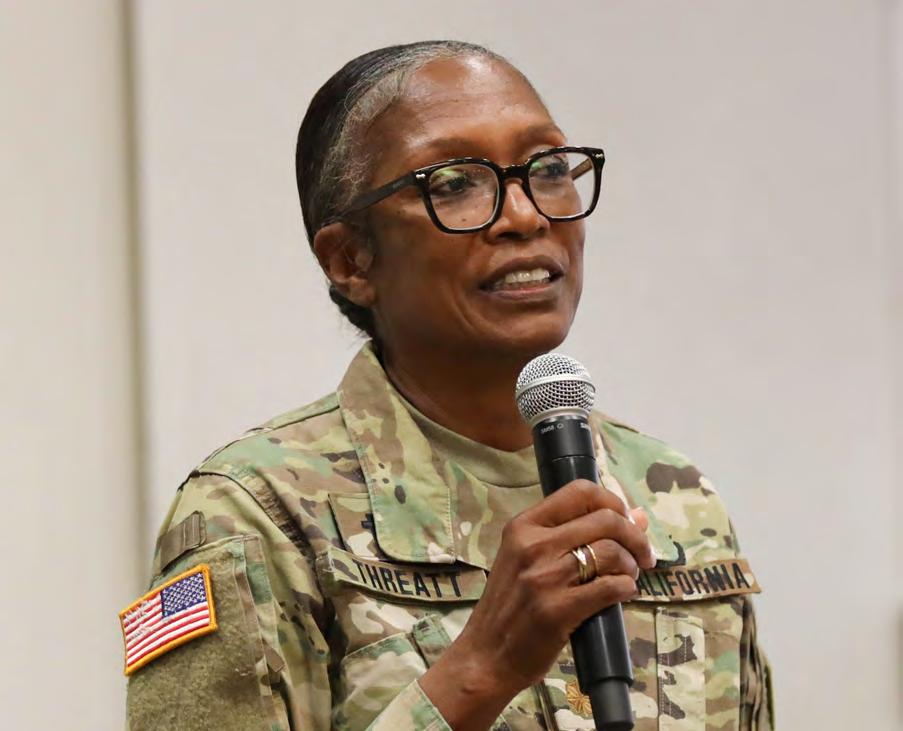
“My life has been one of service,” Threatt says.
She is the mother of two children, a son and daughter, and has two granddaughters. In her free time, she enjoys sewing and playing with her grandchildren. Threatt also enjoys cooking and is known for her famous fried chicken and likes making intriguing salads.
“People in the military could be a model for civilians,” Threatt says. “When you go into the military, it doesn’t matter what color your skin is. Everybody has that uniform, everybody is an American and everybody takes the same oath, and that oath is to protect and defend the constitution of the United States.”
8 | Warrior Life
Major Brenda Threatt speaks at a Veterans Day event on Thursday, Nov. 10, 2022, at El Camino College’s East Dining Room. Threatt is a chaplain in the California National Guard and the assistant director of Veterans Services at ECC. (Greg Fontanilla | Warrior Life)
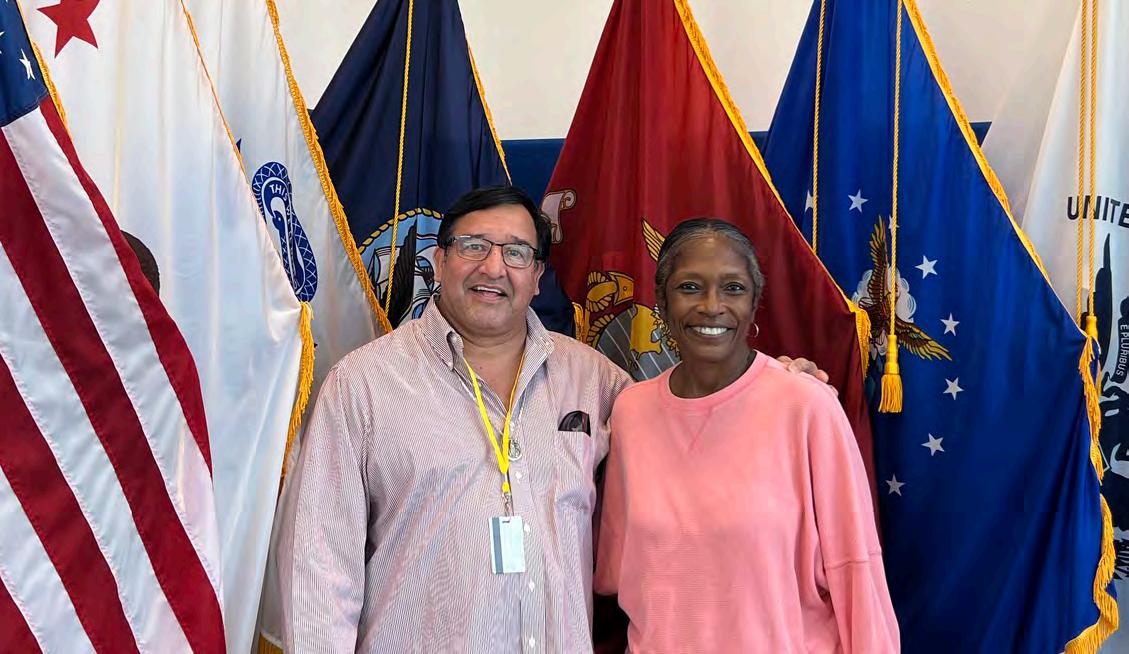
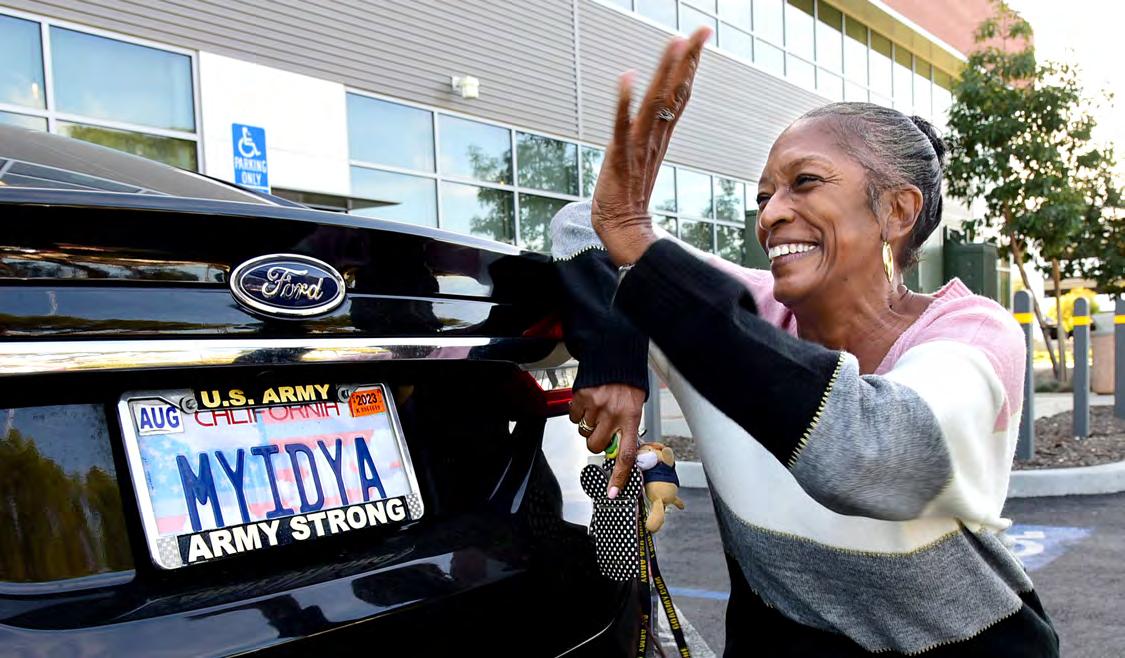 (Top) El Camino College Assistant Director of Veterans Services Brenda Threatt acknowleges a fellow worker at ECC on an afternoon in Novemver 2022. She has a special California Department of Motor Vehicles license plate for having created a 9/11 commemorative license plate in 2001, that has generated $15 million in funds for victims and families of terrorist attacks. (Gary Kohatsu | Warrior Life)
(Top) El Camino College Assistant Director of Veterans Services Brenda Threatt acknowleges a fellow worker at ECC on an afternoon in Novemver 2022. She has a special California Department of Motor Vehicles license plate for having created a 9/11 commemorative license plate in 2001, that has generated $15 million in funds for victims and families of terrorist attacks. (Gary Kohatsu | Warrior Life)
Warrior Life | 9
(Bottom) Lawrence Moreno, overseer of the Veterans Services Resource Center, and El Camino College Assistant Director of Veterans Services Brenda Threatt stand with the flags of the United States armed services inside Veterans Services at ECC on Monday, April 11, 2022. (Safia Ahmed | Warrior Life)
Intertwined by Miracles of nature
Dogs in my life: A second opportunity to do things right
Story and photo by Alexis Ramon Ponce
“Pets belong outside!” she yelled. “They never have to be on our sofa or in bed. Never!”
I had an extremely strict grandma; a great lady, yet strict about animals and their interrelation with humans. The way she taught us to treat animals wasn’t exactly the right way. I discovered that many years later.
Here is where the saying “A dog is man’s best friend” –which has been said many times – makes a presence, but this time for me it has real meaning.
It is especially important to understand that not only dogs, but also any kind of pet might be a great presence in our lives, and they can demonstrate to us in some way the meaning of the words company, support and love.
In 2010, on a sunny day on the island of Oahu in Hawaii, two Chihuahuas came into our lives. My husband and I named them Kiko and Shandy. These hairy twins showed me things in life that I couldn’t learn in school. They came to change our lives forever.
How did they arrive? I’m sure it wasn’t a coincidence. We were going to the movies and on our way, for some reason – maybe destiny – we felt an attraction to go inside a pet store to take a look only.
Immediately, when we were inside that place, we were attracted to a couple of 2-month-old puppies, brother and sister. The connection was immediate. They adopted us at that magical instant and we could not say no.
From that moment on, we started to look for information about the breed, all about Chihuahuas. I
want to start by saying that the correct name of the breed is “Chihuahueño” or Chihuahuan, meaning originally from the state of Chihuahua in Mexico.
According to the American Kennel Club, Chihuahuas are the smallest dog breed in the world. In contrast to their little size is their huge ego, attitude and loud bark.
We found out that Kiko and Shandy’s ancestors are from a breed that was raised for the Mexican royalty in civilizations like the Aztecs and the Toltecs. The ancestor dog was an extinct breed known as the Techichi and it was the alpha; the genesis of the Chihuahua.
Chihuahuas have compact bodies. Nevertheless, they come in different shapes, with weights that range from 2-20 pounds. They have short or long hair. However, they all have something in common. They have big ears, huge, bulging eyes and for sure, a truly short temper.
In the beginning, when I started interacting with my puppies, I used to walk with them in open green areas surrounded by forest.
They are territorial little things and super protective of their pack.
Walking with my lively, full-of-energy pack was a new experience. Every day was a different adventure. Building great memories was the most important thing of all, creating bonds that last forever.
In Hawaii, it is quite common to find hens or roosters and their little ones living free in the wilderness. It was those poultry that immediately caught the attention of
10 | Warrior Life
my Chihuahuas, especially Kiko who, on occasion, ran after them until the chickens went to the top of a tree looking for shelter.
As it was explained in the beginning of this story, as a Latin man, I was raised in a rich, colorful culture that has a special meaning for the word family. Even so, the connection to pets is different to the way people in the United States treat their furry friends.
In my case, I used to see animals as an inferior breed. They always slept outside and never came inside the house. It was unthinkable to see them sleeping on the family couch.
Nonetheless, my little twins changed that vision, my past feelings for pets. I changed from the inside out. In my mind, the words equality, dignity and love started to have great meaning. I never imagined I would not only share a space in our house with them, but share a part of my soul.
Through the years, my husband and I discovered that our very brave, Napoleonic complex-suffering doggies, who acted like lions trapped in tiny bodies, were misunderstood creatures.
As a result of the love they gave us all the time, we filled every space of their lives as well, with love and
compassion. Of course, in the end they gave us more than that.
After 10 years, the moment came to say goodbye. Shandy, along with Kiko, crossed the Rainbow Bridge. Our little Yoda left a year after them, leaving behind a legacy of understanding, respect and love; a great teaching of life that is above all kinds of prejudice.
Now we have a whole new generation of brave Chihuahuas, three to be exact: Camila, Seamus and Tiffany Lulu, every one of them with different personalities – or should I say doggienalities?

Seamus hates baths and getting his nails clipped.
Camila loves eating, but hates other people and all other dogs.
For Tiffany Lulu, our puppy who recently turned a year old, the day is all about playing. She plays with the expensive toys bought in the pet shop, but her favorite toy is a tube sock. She also plays with her favorite living toy, Seamus.
Tiffany Lulu has been known to chew her way through shoes as well. Her youthful vigor has energized her brother and sister, as well as her two dads.
We can’t imagine life before our lives became so intertwined by these miracles of nature.
Warrior Life | 11
Chihuahuas (L-R) Kiko, Yoda and Shandy are memorialized in this painting by Mary Dibble. The Chihuahuas gave unconditional love. They were the light of their owners’ lives and changed their lives forever.
In Culver City, Calif. on Nov. 20, 2022, Yajaira Hernandez and her oldest son, Joseph Hernandez, visit the site where the remains of Juan Hernandez were laid to rest at Holy Cross Cemetery.
 Story and photos by Kim McGill
Story and photos by Kim McGill
On Sept. 22, 2020, 21-year-old El Camino College student Juan Hernandez – known to his family and close friends as “Cookie” – left the apartment where he lived nearly his whole life with his parents and brothers on Adams Boulevard in South Central Los Angeles to drive to his job at VIP Collective Marijuana Dispensary at 8113 S. Western Ave.
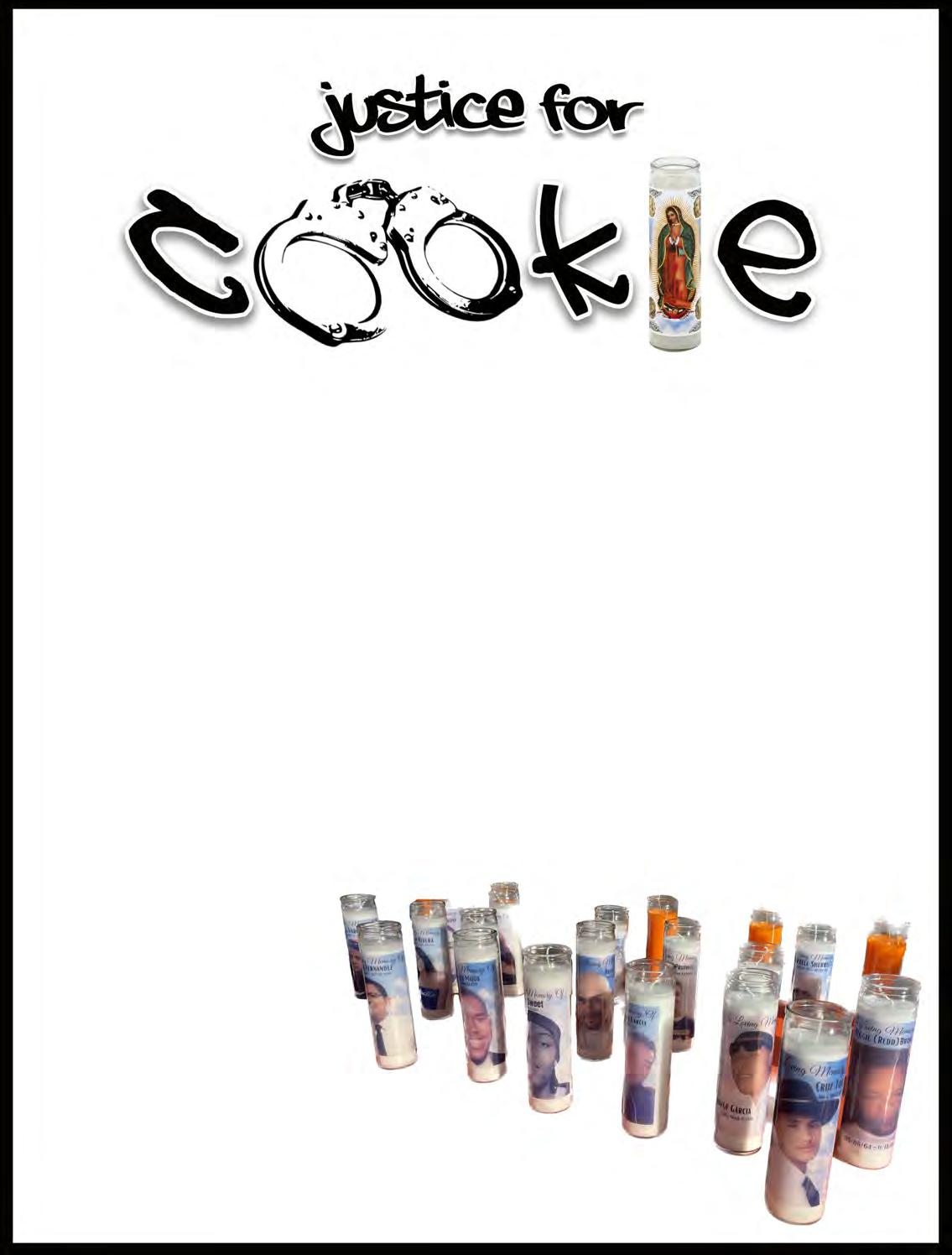
He never came home.
This is not only a story about a missing young person. It’s also a story about a woman who pushed one of the nation’s largest police departments to find her son, and in the process transformed from a mother to a witness, an investigator, a healer and eventually, a warrior.
The witness
On Feb. 28, 2022, Yajaira Hernandez stood outside Department 41 at Clara Shortridge Foltz Criminal Justice Center in Downtown Los Angeles. Known on the streets and by those who work there as Criminal Court Building or CCB, the massive concrete structure is the largest courthouse in the U.S., with 61 courtrooms and 101 holding cells.
Everyone, no matter how powerful, seems small and insignificant amid the worn marble and tacky wood paneling of its hallways and departments. Thousands of people come and go each day. While things slowed dramatically during COVID lockdowns, Yajaira Hernandez was still among more than two dozen people waiting for their cases to be called.
Her lower face was covered in a black disposable mask – a reality of life under the pandemic – and her brown eyes peered
out from behind black rimmed glasses that perched on top of the mask’s upper edge. Her light brown hair was combed neatly to the side, and blonde highlights brushed against her shoulders. She was dressed in a dark jacket and black and white plaid blouse.
She came to court alone, unlike most of the people leaning on others for support or quietly talking. “I come here so my family doesn’t have to. I want to save them from any more pain,” she says.
Around her neck, she wore a silver chain and heart-shaped charm decorated with a photo of Juan Hernandez, her middle son.
The resemblance between Yajaira Hernandez and her son was uncanny – the same features, same eyes, both wearing glasses – except that in the photo Juan Hernandez was smiling and his mother’s eyes expressed both a fierce determination and a deep sorrow.
Officially, she was in court as a witness for the prosecution in the preliminary
How the murder of Juan Hernandez turned his mom into a powerful leader in the growing movement to heal families and communities
hearing of The People versus Ethan Kedar Astaphan. Astaphan is one of three defendants charged for the killing of Juan Hernandez.
Unofficially, she was there to ensure that the County of Los Angeles would effectively present the evidence she pushed the LAPD to collect.
Juan Hernandez’s murder had happened nearly 18 months earlier, but the LAPD and L.A. County District Attorney’s Office had not communicated much to Yajaira Hernandez about the case.
She was afraid of what she would hear in court, but also anxious to learn about her son’s last hours, including why and how he was killed.
Her disappointment was obvious when she was told to leave the courtroom. With the exception of the law enforcement officers who lead the investigation, all other witnesses are barred from preliminary hearings and trials in order to protect the integrity of their testimony.
It’s only through reporting by the The Union studentproduced newspaper at El Camino College that Yajaira Hernandez learned that her son was allegedly murdered by VIP’s owner – Weijia Peng - and store manager Astaphan, that they dragged Juan Hernandez, possibly unconscious and alive, from the dispensary into the back of an SUV, that while Peng’s girlfriend Sonita Heng drove east to San Bernardino County, Peng and Astaphan injected Juan Hernandez with a lethal dose of ketamine, then dumped his body off a dirt road in a desolate section of the Mojave Desert, that – as daylight broke – they arrived back at the dispensary to remove evidence and clean the location where Juan Hernandez struggled on the floor while being choked, and that later in the day they burned his belongings on an Orange County beach.
The weight of this information caused her shoulders to slump, and her eyes to shift downward, but she did not shed a single tear.
On May 3, 2022, Yajaira Hernandez was back at court. She
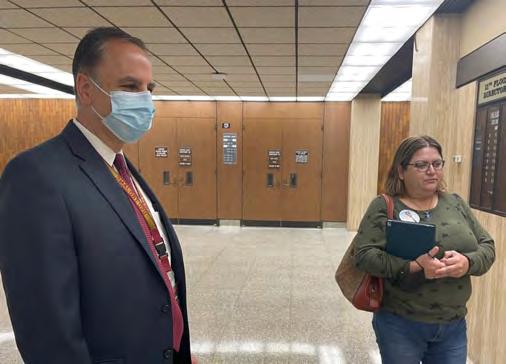
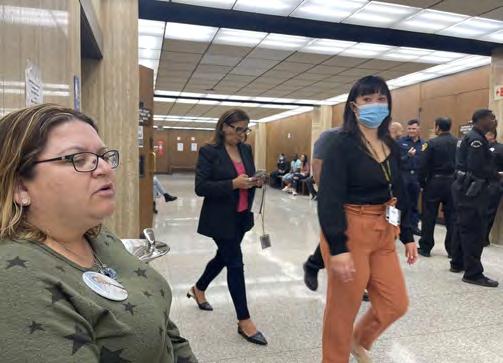
was wearing an olive-green sweater with black stars. A large button with Juan Hernandez’s photo was attached just below her left shoulder. She looked tired and her voice was low and somber.
She’s frustrated that the process is so slow.
“People don’t realize that this process is draining. Having to be strong for everyone is exhausting, emotionally and spiritually,” she says. “I wish this system was built differently.”
The prosecutor on the case, Los Angeles County Assistant District Attorney Habib Balian, told her that she doesn’t have to come to every court date. But she feels she needs to be there as much as possible to represent her son.
There are still many months left in the proceedings.
Peng, who was extradited from Turkey where he fled not long after Juan Hernandez’s disappearance, did not appear in court until Nov. 21, 2022 for his arraignment.
Pre-trial hearings were regularly held in December and during the first five months of 2023 to give both Astaphan’s and Peng’s attorneys time to review evidence and prepare a defense. A trial could start in the summer or fall of 2023, but that’s what the D.A.’s office said last spring.
Nothing is certain.
Peng, now 34, remains in custody on $20 million bail and Astaphan, now 29, is detained on $10 million bail. Heng, now 23, is out of custody on a plea agreement that includes her testimony as a state witness against Astaphan and Peng.
Life has moved on for most involved in the case, but not for Yajaira Hernandez, who struggles to heal from the murder of her son.
On Jan. 9, 2023, Astapahan’s defense attorney, L.A. County public defender Larson Hahm, informed the court that Astaphan was married in December, and with permission from the judge, he took a photo of Astaphan in order to process a new I.D.
On April 4, 2023, Balian said that LAPD Detective Daniel Jaramillo – one of two detectives who investigated the case –
Los Angeles County Assistant District Attorney Habib Balian (left) and Yajaira Hernandez wait for the elevator after court on May 3, 2022. Balian told Warrior Life that the persistence of Yajaira Hernandez was the key factor in forcing an
investigation.
Without her pushing the system, Juan Hernandez would still be missing. Kim McGill | Warrior Life
Yajaira Hernandez at Clara Shortridge Foltz Criminal Justice Center in L.A. on May 3, 2022. Kim McGill | Warrior Life
“I’m going to live with this pain forever. We should be able to lay my son to rest, pray for his soul and move on. Instead, we’re praying - and fighting - for justice.”
14 | Warrior Life
- Yajaira Hernandez
was promoted to serve as assistant to LAPD Chief Michael Moore.
Balian also joked about looking forward to his own retirement.
Yajaira Hernandez says that for many family members of people who disappear or are murdered, progress and joy is frozen in time.
“I’m going to live with this pain forever,” she says. “We should be able to lay my son to rest, pray for his soul and move on. Instead, we’re praying - and fighting - for justice.”
The investigator
“I knew immediately that something was wrong,” says Yajaira Hernandez about the morning of Sept. 23, 2020.
She woke up at 5 a.m. She always checked her boys’ rooms first.
Her youngest son, Gabriel Hernandez, was still sleeping. When she looked into Juan Hernandez’s room, his bed was still made, and she says an ominous sensation overtook her.
She rushed outside and found that her car was also missing.
“Juan had never not come home. He never ran away. He was never late without a call or text. And I knew he would never take off with my car,” Yajaira Hernandez says.
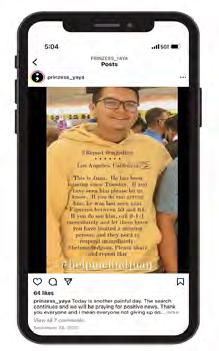
He knew how much she depended on her car to get to work.
She checked her phone. She had no missed calls. No texts. Her son didn’t respond to any of her attempts to reach him.


She then called her sister Stephanie Pineda and her boys’ stepfather Mike Burka and asked them to come over.
She called other family members and friends to see if anyone had heard from him. No one had.
His best friend said that they were supposed to meet up, but Juan Hernandez never showed.
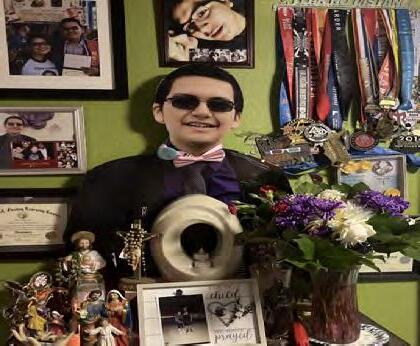
Yajaira Hernandez called the dealership where she bought her car and asked them to track it. They said only the police could do that.
She was becoming frantic. She began to
run through possible scenarios. Maybe he’s stranded somewhere without a phone charger. No, he can charge his phone in the car. Maybe he’s been robbed and hurt. Maybe he smoked some weed that was laced with a dangerous substance and he is sick or sleeping it off. Maybe he’s in trouble and afraid to come home.
Yajaira Hernandez made a bargain with her son in her head. “I kept thinking, just come home. No matter what has happened, we can deal with it.”
Pineda and Burka drove to VIP Collective. They spoke with a security guard they described as a tall, slim, Black male.
The Union confirmed through the physical description, court testimony and evidence presented at a later court hearing that the person they spoke to was Jalen Commissiong who another employee, Daniel Romero, referred to as “T.”
According to Daniel, Jalen worked as VIP’s security guard six to seven days a week from 8 a.m. until closing at 10 p.m.
“Juan left yesterday and we haven’t seen him,” Commissiong says to them.
While her family was at VIP, Yajaira Hernandez called the Southwest Division of the LAPD.
They refused to take a missing person report. They told her that her son was an adult and had a right to disappear without checking in with his family. The officers said they had to wait at least 48 hours.
At noon, Yajaira Hernandez, Pineda and Burka drove to the LAPD’s Southwest Division on Martin Luther King Boulevard. Again, they said they wanted to report Juan Hernandez as missing.
The LAPD still refused to investigate it as a missing person case. Young people take off from home without calling their mom all the time, the police said.

Yajaira Hernandez says that the LAPD’s indifference both angered and terrified her. But she was a tough mom who had raised three boys and she was convinced that something horrible had happened to her son.
“Then I want to report my car missing,” she
An altar for Juan Hernandez, built just after his disappearance, remains at the front door of his family’s home in South Central L.A. Kim McGill | Warrior Life
Warrior Life | 15
The disappearance and murder of Juan Hernandez and its impact are documented through Instagram posts and a text for ransom. Kim McGill | Warrior LIfe
told the police and she pushed them to take the report. “I wanted LAPD to help me. I wasn’t going to sit there and do nothing.”
At about 3:30 p.m., Yajaira Hernandez, Pineda and Burka went back to the dispensary. All three went inside and spoke to Commissiong. “We closed at 10 and he [Juan Hernandez] left,” Commissiong told them.
Yajaira Hernandez kept questioning him. Commissiong said he couldn’t remember which way Juan Hernandez went, if he was walking or driving, or who else was there when he left.
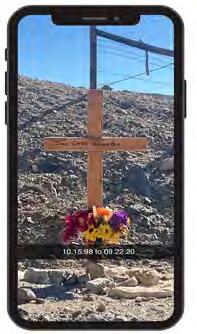
Yajaira Hernandez then said she needed to speak to E., referring to the store manager Astaphan. “Call him or give me his number.”
According to Yajaira Hernandez, Commissiong told them the store didn’t “want any trouble” or want “anything to do with the police.”
She felt that Commissiong was holding back. She thought he was being evasive, refusing to answer questions and becoming increasingly short and aggressive.
“He was rude. You would have thought they [VIP] would be worried,” Yajaira Hernandez says.
Juan Hernandez never missed work, but no one at the dispensary seemed concerned that he wasn’t there. Astaphan sometimes drove her son home from work, yet he hadn’t called to ask about him.
“I knew something was wrong,” she says. “They were being very sketchy.”
Yajaira Hernandez went to a nearby liquor store with her son’s photo. The staff immediately recognized him and said that he came in every day for snacks. They offered to post a missing person flier once one was created and promised to ask customers if anyone knew anything. She says this is the kind of response she would have expected from VIP unless they were hiding something.
When she returned to the dispensary, Commissiong didn’t want to let her in.
By the time they arrived back home, Yajaira Hernandez was in full detective mode. “I felt I had to do the work that the LAPD was refusing to do,” she says.
Juan Hernandez’s older brother Joseph Hernandez posted a message on Instagram and Facebook. Yajaira Hernandez shared it with all the school and community groups their family was a part of – the PTA, robotics club, a neighborhood academic enrichment program run by USC, and the running groups Juan Hernandez and his mom had been a part


of since he was 14.
“We had a great response from family and friends,” Yajaira Hernandez says. People started to share the post and asked what else they could do to help.

Yajaira Hernandez’s phone number was included on the post and, within 24 hours, she started getting ransom demands.
They terrified her.
One text said they were torturing her son in Tijuana. One person threatened that they had to get the money within 30 minutes or they would cut off a finger. Another gave her 24 hours to pay or they would kill him. She panicked that her son got involved in something dangerous like trafficking for a cartel.
“I begged Juan not to work at the smoke shop because it was unlicensed,” she says.
But he told his mom that he felt responsible for helping with rent and bills. At the start of the pandemic, he was laid off from his job selling timeshares. The nation was shut down and there weren’t many jobs.
Within 48 hours of his disappearance, Yajaira Hernandez had gotten four calls and five texts, all from different people claiming they kidnapped him. They asked for between $5,000 and $10,000.
“We didn’t have the money to pay anyone,” she says. “We live paycheck to paycheck. When I asked people to put Juan on the phone or send me a recording, no one did.”
Yajaira Hernandez says she ended every call and text the same way. “If you do have my son let him know I love him.”
At the same time, dozens of supporters were calling the LAPD to file a missing person report, and the pressure worked. Yajaira Hernandez finally heard from an officer who told her that her son’s disappearance sounded like “foul play.” He promised he would push the missing person unit to investigate.
“That was the first time I felt heard by the LAPD,” she says.
A friend connected Yajaira Hernandez to a retired detective. He told her to tell the LAPD about the ransom demands.
The LAPD immediately said she shouldn’t have posted anything on social media. She shouldn’t have put her number on any flier. “That made me feel like crap,” she says. “Like maybe I put my son in this position.”
But in the end, it was the ransom threats that moved an investigation forward.
In less than 24 hours, LAPD’s Robbery and Homicide Division contacted her. “It was not
16 | Warrior Life
The first post of a cat meme reflects Yajaira Hernandez’s typical lighthearted messages that ended with the killing of her son. Kim McGill | Warrior LIfe
missing persons or homicide that called,” Yajaira Hernandez says. “The LAPD cared more about the extortion for money than Juan’s disappearance.”
Five days after her son’s disappearance, Yajaira Hernandez met with LAPD robbery detectives Jaramillo and Jennifer Hammer. She showed them the ransom threats, but she also shared her suspicions about the dispensary. She didn’t hear back from them until two weeks later. They said they were investigating.
“By then we were doing our own thing,” she says. She and her sons continued to post messages to social media urging people to share any information they had.
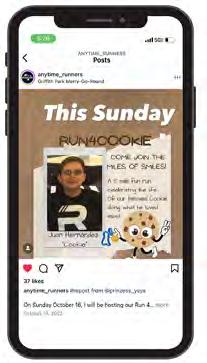
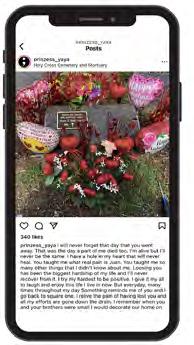
Before her son went missing, Yajaira Hernandez posted a few times a month on Instagram – a comical message about falling off the toilet during an earthquake, photos from a birthday dinner with a friend, a onechip challenge and lots of cat memes. She had been on Instagram since 2012 and had a small following of friends and family. Her posts rarely generated more than twenty likes.

After her son’s disappearance, she posted several desperate messages on Instagram and Facebook every day urging people to “#helpmefindJuan.” She started getting thousands of views on videos, and hundreds of likes on regular posts.
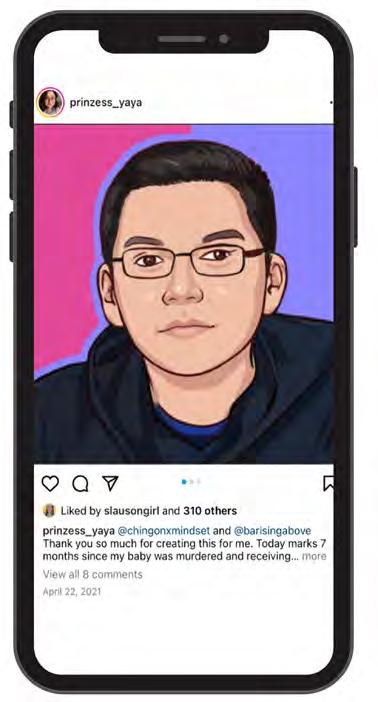
“I know I may be overwhelming everyone with my posts,” she wrote on Sept. 25, 2020. “Unfortunately, this is all I can do to spread the word on my baby boy.”
On Sept. 27, 2020, Telemundo broadcast a story about the search as well as a follow-up story covering a vigil the family organized on Sept. 28.
The family also made 10,000 flyers.
From Sept. 23 to Nov. 18, 2020, hundreds of people came out every day to search the streets, parks and tent encampments.
They followed up on every tip from downtown L.A. to San Pedro. They attached flyers to thousands of light poles and talked to everyone they saw. They organized a rally at LAPD headquarters.
“I’m very grateful for the community” Yajaira Hernandez says, and she credits everyone’s actions as “making the difference” in getting the LAPD to investigate. “I wouldn’t have been able to do this alone.”
L.A. City Councilmember Herb Wesson donated an additional 30,000 flyers. Lamar Advertising Company only charged $900 for 13 billboards that were up for six weeks - a fraction of the usual cost. A Go Fund Me
raised thousands of dollars for gas, flyers, shirts and posters.
Nearly two months after Juan Hernandez’s disappearance, Jaramillo met with Hernandez. He told her that the LAPD had worked with the San Bernardino Sheriff’s Department to uncover her son’s remains in the desert.
Hammer later testified at Astaphan’s preliminary hearing that the LAPD used cell tower data to track the movement of Astaphan’s and Peng’s phones, eventually leading them to the body.

“Part of me was relieved that Juan was found. But knowing he was dead shattered my world,” Yajaira Hernandez says.
The LAPD told her that they had arrested Astaphan and Heng. They were still looking for Peng.
“I asked if I could see Juan, but they preferred not.” His body was badly decomposed and also impacted by animals scavenging, the LAPD told her. It was another month before his body was released and cremated.
She and her sons chose a spot for his remains in the garden at Holy Cross Cemetery in Culver City.
Juan Hernandez was one of more than 500,000 people reported missing in the United States in 2020.
According to federal statistics, Los Angeles has the highest number of missing person cases when compared with other U.S. cities. LAPD missing person investigations can be requested and tracked online, although only a fraction of the people reported missing are included.
The California Department of Justice (DOJ) releases annual information on missing persons as reported by law enforcement, and the state’s active missing person cases average about 20,000 on any given day. The Federal Bureau of Investigations (FBI) shares similar data for cases it is investigating across the nation.
This is a fraction of the people who actually disappear that no one notices, or who aren’t reported missing.
California state DOJ policy states that “there is NO waiting period for reporting a person missing. All California police and sheriffs› departments must accept any report, including a report by telephone, of a missing person, including runaways, without delay and will give priority to the handling of the report.”
However, the DOJ only collects data on
Warrior Life | 17
people reported missing by local law enforcement, and while detailed data and resources exist for missing children, the state has little data on people over the age of 18.
Each year, L.A. County buries in a mass grave the cremated remains of over 1,500 people whose identities are either unknown and/or whose bodies are unclaimed by family. The county holds individuals’ remains for three years to allow family members and loved ones a chance to claim them. In December 2022, L.A. buried the remains of 1,624 people who died in 2019.
“The LAPD made me feel like my son was nobody, like he wasn’t valuable enough to look for. This added so much to the pain and anxiety I was going through,” Yajaira Hernandez says. “We do the heavy work and they [police] come and sweep up after us.”
Jaramillo and Balian both told Warrior Life that the persistence of Yajaira Hernandez was the key factor in forcing the start of an investigation and moving it forward. Had she given up hope or been too intimidated to push the system, Juan Hernandez would still be missing.
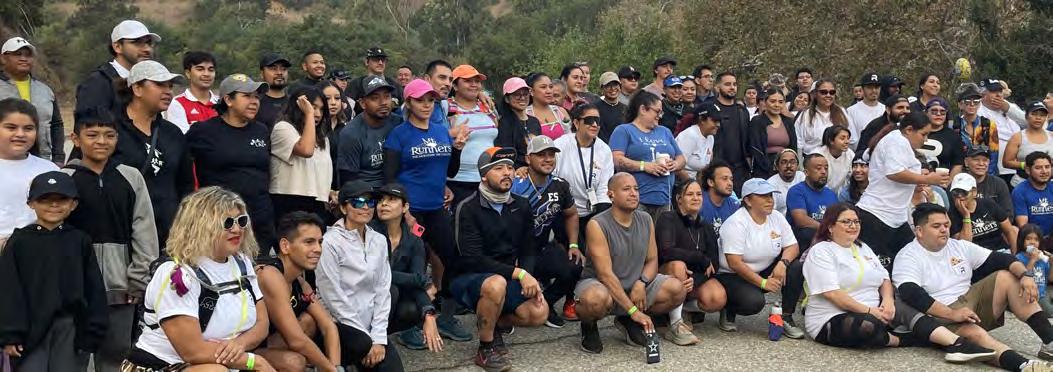
The healer
As a young mom, Yajaira Hernandez, now 43, married Jose Hernandez, the father of her youngest son, Gabriel Hernandez. He adopted Juan and Joseph and the boys were given the Hernandez name.
Yajaira Hernandez went to school full-time and worked
part-time. She earned an associate’s degree in liberal arts. She started working at the L.A. County Department of Public Social Services (DPSS).
She and her husband separated, but remained good friends.
She was active in her sons’ lives, involving them in sports, science and robotics camps and programs that contributed to their academics.
The Hernandez home just before the end-of-the year holidays in 2022, reflects the love that Yajaira Hernandez has for Tim Burton’s Nightmare Before Christmas, including a tree decorated with ornaments depicting all the characters. Inspirational sayings cover the walls of each room such as “Family, where life begins.”
On her right arm is a tattoo with her three sons. Juan Hernandez has a halo and “Til’ I see you again,” written above his head.
After her son’s murder, Yajaira Hernandez took a leave of absence from work. “I can’t really say my job was supportive, but thankfully, I had a job when I came back,” she says.
On Dec. 21, 2020 the remains of Juan Hernandez were buried at Holy Cross Cemetery in Culver City. Yajaira Hernandez was back at work on Jan. 4, 2021.
The mortuary had only two dates available - Dec. 19 which is her mom’s birthday or her own birthday on Dec. 21.
“Life never really stops knocking you down,” Yajaira Hernandez says.
Since her son’s murder, the changes in her life are numerous. “I sleep about two to three hours a night. I’m either overeating or not eating anything,” she says. “I get dressed and go to work to set an example for my sons, but a lot of times I want to quit. I’m constantly praying and watching videos of my son. One moment I’m okay and another I’m breaking down in tears. There’s a piece missing inside me.”
She thinks often of all the moments in her son’s life that she will never experience – his graduation from college, his wedding, the birth of his children.
“Everything we do as a family – every dinner, every conversation, every joke – I think about how much Cookie would have loved it,” she says.
To help herself heal, she began to heal the community.
 More than 100 people came out to “Run for Cookie” in Griffith Park on Oct. 16, 2022 to celebrate what would have been Juan Hernandez’s 24th birthday on Oct. 15. Kim McGill | Warrior Life
More than 100 people came out to “Run for Cookie” in Griffith Park on Oct. 16, 2022 to celebrate what would have been Juan Hernandez’s 24th birthday on Oct. 15. Kim McGill | Warrior Life
On April 30, 2022 Yajaira Hernandez joined families impacted by violence at a candlelight vigil in South Central LA.

“I’m here to feel supported and support others,” she says. “Some people are alone, and they turn to alcohol, drugs, the streets to deal with the pain. These are the consequences for the families left behind.”
Speaking to ABC 7 news and Warrior Life at the vigil, Yajaira Hernandez explained that community healing events are essential for her own and others’ healing. “With other survivors, I’m open and honest. I don’t have to hide my pain. I don’t have to hide my emotions. I don’t have to fake a smile for my family or other loved ones. This is for me. This is part of my journey.”
Oya Sherrills works at a healing center for families in Watts. She was at the vigil to honor her brother Terrell Sherrills whose murder remains unsolved. “L.A. needs resources for victims and survivors of crime,” she says. “Families need access to a lot more of the court and police records, as well as opportunities to tell our stories and shift the narrative. We are shut out by law enforcement and the courts.”
Sherrills says family members need healing services but also “healing conditions.”
“It’s really difficult managing grief,” Sherrills says about the struggles surviving family members endure.
“You lose your job, don’t have a place to rest your head, don’t have access to substance abuse treatment and mental health when you self-medicate after tragedy strikes.” she adds.
To celebrate what would have been Juan Hernandez’s 24th birthday, his family worked with Anytime Runners and Rundalay to organize a five-mile “Run for Cookie” in Griffith Park on Oct. 16, 2022. Yajaira Hernandez and her son used to run with the two groups.
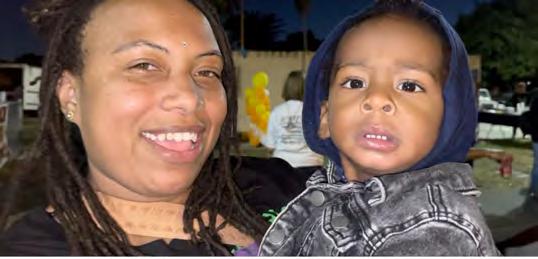
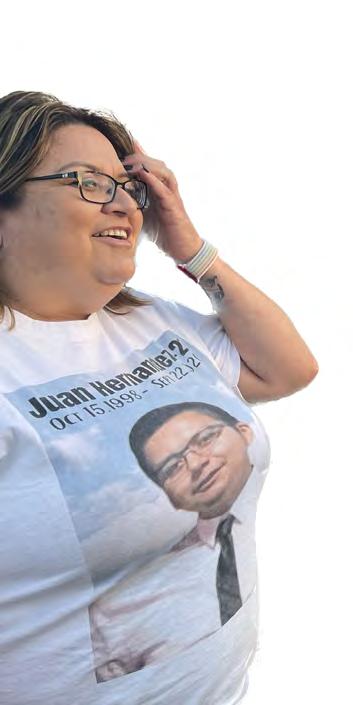
“My biggest motivator is supporting my mom,” Joseph Hernandez says. As a toddler, he struggled to pronounce his little brother’s middle nameCarlos. It came out “Cookie,” and the nickname stuck. “Every year, my mom tries to figure out how to cope with Juan’s birthday,” he adds.
“It’s a hard day. This year she thought about having a community event with something that she did with Juan, because their relationship was always through running.”
Rundalay founder Francisco Montes said he saw Juan Hernandez grow up.
“Even at a young age, Juan stepped up when we needed someone to pace a group,” Montes says. “It was amazing to see a 17-year-old lead 30 people without fear. He impacted a lot of people,” he adds, holding back tears.
The run raised more than $1,000 to support families of homicide victims in L.A.
The warrior
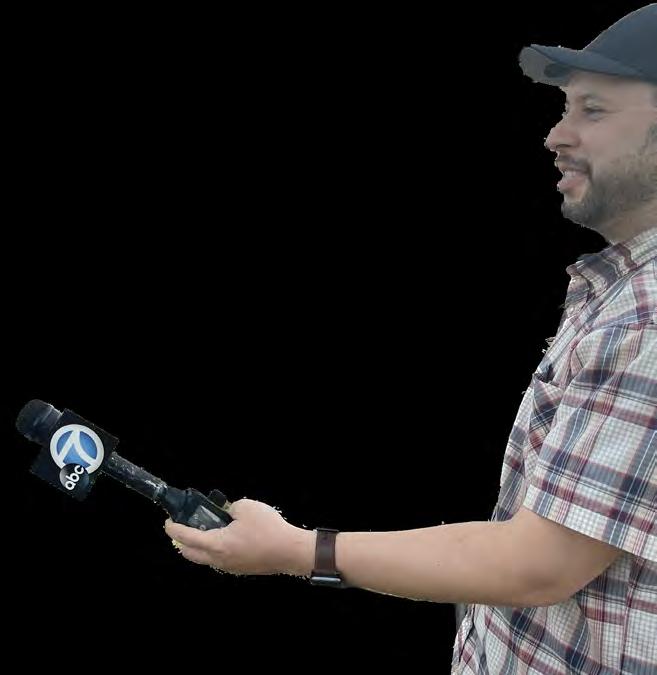
Just past sunrise on April 26, 2022, Yajaira Hernandez arrived at Fred Robert Park on Honduras just south of Vernon Avenue on the east side of South Central Los Angeles.
She leaned against a cement table covered in graffiti scratched into the paint.
“We’ve had enough,” Yajaira Hernandez says. “All this hate, all this violence needs to stop. If I can help out one family, then my son didn’t die in vain.”
Slowly other people pulled up – mostly mothers and grandmothers – all there because their family members had been murdered in the streets, violent relationships or by law enforcement. They came to travel to Sacramento for the annual Survivors Speak conference and advocacy day at the California state capitol.
Before boarding the charter bus for the long ride to Sacramento, Yajaira Hernandez spoke to NBC 4 news and Warrior Life.
“Some days are good. Most days are bad,” she says. “When I’m around other victims’ families, I can speak without any regrets, without any shame, without feeling like I’m a burden to them. It’s like a safe space.”
Phillip Lester, who coordinates violence prevention programs for youth in Los Angeles, was also in Sacramento. When he was 14, Lester was shot
Oya Sherrills and her son attended the candlelight vigil on April 30, 2022. Kim McGill | Warrior Life
Yajaira Hernandez (far left) joins families impacted by violence at a candlelight vigil in South Central L.A. on April 30, 2022. “I’m here to feel supported and support others,” she says.

“I fought for Juan when he was alive, and when he was murdered, I did everything possible to find him and bring him home.”
- Yajaira Hernandez
Yajaira Hernandez at the Survivors Speak Conference and Advocacy Day at the State Capitol, Sacramento, Calif., April 24-26, 2022.
20 | Warrior Life
Kim McGill | Warrior Life
twice, and was then shot again at 15.
“I got no services or counseling,” Lester says.
“I was ejected [from the hospital] right back into the streets.”
As he stood on the Capitol steps before entering the building to speak with legislators,

Lester also described how survivors go on living in the same homes and neighborhoods where their loved one was murdered without any access to counseling or peer support, let alone the ability to move.
“People need help after a traumatic situation,” Lester says. “Money must be allocated toward survivors of crime, and to the establishment of Trauma Recovery Centers run by folks like me in the communities where we come from.”
Since Survivors Speaks, Yajaira Hernandez has begun to speak out more often to the media, public officials and to the community about what’s needed to prevent violence and to help survivors seek justice.
Since Survivors Speaks, Yajaira Hernandez has begun to speak out more often to the media, public officials and to the community about what’s needed to prevent violence and to help survivors seek justice.

“Every time I share Juan’s story I’m keeping his memory alive,” she says. “I hope that other families gain some courage, knowledge and resources from our experience.”
On Sept. 23, 2022 she spoke to more than 100 community residents at Los Angeles Trade Tech College about how to push the police to fully investigate a case and report back regularly on the progress.
“I didn’t know anything about LAPD policies,” says Yajaira Hernandez to the audience. She encourages them not to give up no matter how badly they are ignored or dismissed.
“If we don’t fight for our loved ones, no one will. The system won’t do it for us,” she adds.
Reflecting on the past two years, Yajaira Hernandez says she carries a lot of pain, but no regrets. She pauses, bows her head for a moment, takes a deep breath and looks up.
“Like all my kids, I fought for Juan when he was alive,” she says. “And, when he was murdered, I did everything possible to find him and bring him home.”
Yajaira Hernandez (left of podium) and other families fill the steps of the California state capitol at the Survivors Speak Advocacy Day in Sacramento, Calif. on April 26, 2022. Kim McGill | Warrior Life
Warrior Life | 21
Phillip Lester stands on the steps of the California state capitol before going inside to meet with legislators at the Survivors Speak Advocacy Day in Sacramento, Calif. on April 26, 2022. Kim McGill | Warrior Life

22 | Warrior Life
El Camino College English Professor Chris Page relaxes before his punk rock band tudors performs in January 2023 at The Sardine, a bar in San Pedro. This would be tudors first paid gig since the 2020 pandemic lockdowns.
Taking the Stage: Christopher Page
El Camino’s English professor converts markers in class to drum sticks for band gigs
Story by Jesus “Jesse” Chan
Photos by Gary Kohatsu
In a dimly lit room, a drum set lies. As the hush descends, a door opens, and Christopher Page enters, drumsticks in hand. He’s ready. Page spent his childhood in Long Beach reading books, skateboarding in places he wasn’t supposed to, and creating a garage band with his pals. Growing up with an engineer father and an early childhood development mother, Page was often given the freedom to pursue many of his hobbies.
Early on, buckets and pots were used for more than just storage and cooking. Instead, as a youngster sitting in his garage on sweltering summer days, he transformed them into drums. He enjoyed headbanging to Motley Crue, Guns N’ Roses, and Twisted Sister, but his parents were never fans of the music he listened to.The El Camino College English professor and musician, now a drummer for the Los Angeles-based rock band tudors, attributes much of his love of music and writing to his creative youth.
While brushing his slick black hair back, squinting his blue eyes, and crossing his legs. Page recalls certain hobbies that he still pursues and likes that would not have been possible if it had not been for his curiosity as a child Painting, writing, and building were just the beginning of what would become a lifetime of discovery.
Page, on the other hand, jokes that he is not very skilled at such activities.
“My parents were like, ‘Hey, don’t bother me. And do what you want.’ So, you know, that led to me exploring a lot of different things,” Page says. “I found I was interested in a lot of different arts. I’m not good at them, though.”
He chuckles as he reclines on his chair in his ECC office, which is brightly lighted by the wide
window behind his desk. Page is naturally drawn to the arts, which is why other interests have never captured his full attention.
During his childhood, he participated in sports such as soccer, football, hockey, and skating, but only skateboarding piqued his interest. Page tried multiple times to convince his parents to buy him a skateboard, but to no avail. The solution? He built his own.
“I loved [skateboarding] the second I saw it, and for a long time, my parents would not buy me one, so I had to find broken ones, or like I would use rollerblade wheels on my friend’s old deck,” Page says.
Aside from skateboarding, Page’s curiosity wandered so far that books eventually captured his attention. Like his love of music and skateboarding, the inventiveness behind books such as “Lord of the Rings” and “Catch-22,” two of his favorites, only fueled his passion for creative literature.
“‘The Fellowship of the Ring,’ I think I was 11, and I brought that on a family vacation. I read the entire thing in two days,” Page says. “I was so captivated by the world and how it was written. That it was like it could transport you.”
Page enrolled in Cypress College shortly after graduating from Cypress High School. However, like many kids fresh out of high school, he was unclear about what he wanted to do and dropped out. Page worked as a manager at a video store, a clerk at a local library, a furniture mover, and a graphic designer on the side.
But those jobs turned into obligations that frustrated him and prompted him to return to college. A pledge made to himself to better his life and return to education represented an opportunity
Warrior Life | 23

 (Above) (L-R) Guitarist Marcus Clayton, drummer Christopher Page and vocalist/bassist David Diaz perform as tudors at The Sardine in San Pedro early in 2023. The performance marked tudors’ first live gig since the 2020 COVID-19 lockdown of businesses.
(Above) (L-R) Guitarist Marcus Clayton, drummer Christopher Page and vocalist/bassist David Diaz perform as tudors at The Sardine in San Pedro early in 2023. The performance marked tudors’ first live gig since the 2020 COVID-19 lockdown of businesses.
24 | Warrior Life
(Left) Drummer Christopher Page had three main passions as a youth: skateboarding, reading and music. He has managed to retain two interests, as a full-time English professor at El Camino College and a part-time musician for tudors, a punk rock band.
to leave professions he did not enjoy behind. As a result, some students may find themselves in one of his English classes at ECC. Page chose El Camino to teach because it reminded him of his days at Cypress College. Page’s desire to attend college was influenced by two factors: student accomplishment at ECC and how far students go to represent their college.

“I love all the things students create here at [El Camino], for example, the newspaper blew me away when I first arrived. The fact that students here in the forensics club did so well on the national stage and students in the general taking center stage when I came for the interview, seeing student work on the wall, really blew me away,” Page says.
After school, however, Page is often introduced onstage with fellow band members, vocalist/ bassist David Diaz and guitarist Marcus Clayton, as tudors. Page enjoys playing music for audiences of 25 or hundreds, even if it means not selling out most venues where he performs.
“I knew the first time I started rehearsing in a garage that I was like, this is what I want to do. This is it,” Page says.
After spending time in bands such as the Mini Golf All-Stars, Confront, Blank Mind, Kryptonite Condoms, and Virginia Wolf. Page formed the band with Diaz and Clayton after bonding over their love of bands like the Descendents.
“I met him at a tutoring center. Chris intimidated me when I first met him because I just thought he was really smart and good at his job,” Diaz says. “I remember wearing a Converge t-shirt, and he was like, ‘You like Converge, too? Cool,’ and I was like, “This dude likes the same music I like. That’s cool.” For Clayton, the band has been an opportunity to be himself and have fun.
“Generally speaking, it’s a nice outlet for all three of us to be loud and ourselves because of work or the stresses of life. We typically can’t play, but it’s always a nice little release,” Clayton says.
Page, Diaz, and Clayton have shared many unforgettable times, but nothing has stopped them from playing together. Diaz recalls one specific memory that makes playing together worthwhile.
“If I remember correctly, Chris forgot the legs to his drum set because he’d always move his drum set from this rehearsal space we were in,” Diaz says. “He had to set his drums up facing the wall, but it was still tight, which is still a super cool memory for us as a band.”
Page is humble, frequently admitting that he does not believe he is a capable drummer. However, his goal is to continue live gigs and, maybe, produce some new albums with his band.
“Honestly, I’m just going to keep going until I can’t anymore. Until my arms fall off,” Page says.
Warrior Life | 25
English Professor Christopher Page is a full-time instructor at El Camino College and in his spare time, a drummer in the punk rock band, Tudors. As a youth, Christopher developed his passion for music, skateboarding and reading novels, including “Lord of the Rings.”
Known originally as the Point Fermin Landslide, Sunken City in San Pedro is all that remains of a neighborhood that slid into the sea over two decades beginning in 1929. The cliffs are treacherous and the ground unstable. Many have tumbled to their deaths.
 Kim McGill | Warrior Life
Kim McGill | Warrior Life
26 | Warrior Life
TOP 5 HAUNTED PLACES CLOSE TO ECC
From downtown L.A. to the South Bay, here’s where you are most likely to encounter a ghost
Story, photos and illustrations by
Kim McGill
1 2
The Pico House, location of the 1871 Chinese Massacre, one of the deadliest mass lynchings in U.S. history
The Pico House at 424 N. Main St. in Los Angeles, 90012 is the site where several vicious attacks occurred just outside the hotel’s entrance during the 1871 Chinese Massacre. Guests and staff have reported angry encounters with the ghosts of those who were killed. At the time, Don Pio de Jesus Pico - the last Governor of California under Mexican rule - was a wealthy rancher. The Pico House, built just one year before the massacre, was considered L.A.’s first luxury hotel. But, by his death in 1894, Pico was broke. Historians attribute his downfall to lawsuits, gambling, extravagant spending and womanizing. Could it be that Pico was cursed by the spirits that haunt his hotel?

By 1871, Los Angeles had a thriving Chinese community between Main and Los Angeles Streets along “Calle de Negro” or “N----Alley.” The street got its derogatory name from first Spanish and then American elites who forced Chinese and California’s indigenous Tongva people to live there. When a white saloon owner was accidentally killed in a shootout between rival Huiguan organizations, a mob of 500 white and Mexican men led by law enforcement and elected officials attacked the community, lynched at least 18 Chinese boys and men, and burned Chinatown to the ground. Some attacks occurred just outside the Pico House. Only eight people were convicted and even those convictions were overturned on appeal. Vigilante violence was common in L.A. The region had the highest lynching rate in the U.S. between 1848 and the 1880s. Newspaper editorials regularly claimed that Chinese people were immoral and inferior, and officials pushed the U.S. to pass the Chinese Exclusion Act in 1882. L.A.’s Chinatown was rebuilt decades later several blocks north by attaching fake “Chinese-themed” movie sets to the buildings. You can still see where set decorations cover the original structures.
Terminal Island where the U.S. destroyed the Japanese American community of Fish Harbor
Terminal Island, centered within the huge ports of L.A. and Long Beach, is reached by driving to the southernmost points of the 110 and 710 Freeways. From 1900 - 1942, at least 3,000 Japanese Americans lived here in the community of Fish Harbor. After the 1941 bombing of Pearl Harbor, the U.S. government forced more than 300,000 Japanese Americans into incarceration camps, confiscating their land and property. Fish Harbor was erased.
to
claim they have seen
A monument – featuring a Torii gate, the traditional entrance
a Japanese Shinto shrine that marks the transition from the everyday world to the sacred – is all that marks the spot. Dock workers
and heard the ghosts of former residents searching the streets for their homes and neighbors.
Warrior Life | 27
The Drum Barracks
The Drum Barracks located at 1052 N. Banning Blvd. in Wilmington, 90744 is Los Angeles County’s only remaining Civil War era military facility. The Union Army fort was in a dangerous location as L.A. County was the only region west of Texas that sided with the Confederacy and was a major supplier of the South’s war campaign. Conditions at the barracks were also harsh given its far isolation from other Union troops and frigid Pacific Ocean winds sweeping across the South Bay. L.A. City Department
of Parks and Recreation operates the site as a museum. Both staff and visitors say they have seen the spirits of Union soldiers roaming the hallways, sitting in chairs or lounging on the front porch. A favorite is Fred who asks if anyone has seen his love, Maria. Reports also include lights turning on and off and the smell of cigar smoke.
Point Vicente Lighthouse 4

On a cliff overlooking the Pacific is the Point Vicente Lighthouse located at 31550 Palos Verdes Dr. W., Rancho Palos Verdes, 90275. Before the lighthouse was built in 1926, a woman was known to walk the cliffs looking for her lover who was lost at sea. Many people claim that she can still be seen at night floating along the lighthouse gallery searching the waves.
3 5
Sunken City
Where San Pedro meets the sea next to Point Fermin Park near Cabrillo Beach you will find the Sunken City. It’s defined by the rubble of a street and concrete foundations from a neighborhood that slowly slid into the ocean over two decades beginning in 1929. Since then, curiosity has drawn thousands here including graffiti writers who see the spot as a street art mecca. But the cliffs are treacherous and the ground unstable. Many have tumbled to their deaths. Others have died by suicide. Some say you can hear their mournful cries warning others to stay away. You also face large fines and arrest if you go beyond the fencing. Some views – and the best way in – are on the far-left corner of Point Fermin Park facing the sea at 807 W. Paseo Del Mar, San Pedro, 90731.
28 | Warrior Life
These ghosts also deserve attention
The Cecil Hotel, 640 S. Main St., Los Angeles, 90014, where a strange glow emanates from the building. Is it the sun or a restless spirit? Redondo Union High School, One Sea Hawk Way, Redondo Beach, 90277 and Zamperini Stadium, 2125 Lincoln Ave., Torrance, 90501 Kim McGill | Warrior Life
The Cecil Hotel would have been in the top five had it not been for the international attention it’s already gotten with the Netflix series on Elisa Lam who mysteriously drowned in the rooftop water tower. The Cecil is arguably the world’s creepiest hotel with numerous murders, suicides and overdoses, two serial killers among its residents, and a wellearned reputation for being haunted. There are also reports that two high schools close to ECC have ghosts. Look for Jake at Redondo High, a student there during World War II. He had a crush on a girl whose jealous boyfriend returned from the war and beat Jake to death. Neighbors say an unknown woman and her two children were murdered after leaving a Torrance High School football game at Zamperini Stadium and that their ghosts are still seen walking home.

Warrior Life | 29
BARS | |
Love Beyond |
My boyfriend was incarcerated. It felt like I served time too.
Story by Nindiya Maheswari Illustration by Ingrid Barrera
Summer 2021. I sat for eight hours on an overnight bus traveling from San Francisco’s Caltrain Station to Union Station in Los Angeles.
I was finally able to visit my boyfriend who was incarcerated at Twin Towers Correctional Facility in Los Angeles. It had been over six months since I last saw him.
It was still dark when I arrived at Union Station at 6 a.m. I walked to Denny’s to get some crispy bacon and eggs.
My visitation was scheduled for 9 a.m. I applied face powder, pink blush and cinnamon colored lipstick at the breakfast table. I wanted to look nice for him.
The weekend is always special because it’s the only time we are allowed to visit incarcerated loved ones. We wake up super early and line up outside the facilities ahead of our visiting time.
According to a 2018 report by FWD.us, 6.5 million adults in the U.S. have an immediate family member currently in jail or prison.
A deputy checked my identification at the security gate and let me in. While in the waiting room, I saw a woman come a minute late to her visit and beg to be let in.
Her bus was late and she traveled 100 miles to see her husband. The deputy had no mercy. He turned her away.
Feeling powerless, I could not say anything or make a scene because there would be repercussions. We could be blacklisted and lose our visitation privileges in the future.
I had to pick my battles. I did not travel for eight hours by bus from San Francisco to L.A. only to be sent home without seeing my boyfriend.
Soon they called my name and I took an elevator to the third floor. As I got out, I saw my boyfriend
sitting behind a glass wall. I ran to him and cried. I saw one of his hands was handcuffed to the booth.
I did not know that we would be separated by the glass wall. I thought I could hold his hands or hug him.
We talked through a phone. He was right in front of me, but his voice sounded so far away.
Laughing together, we put our hands against the glass wall. The visitation was only for 30 minutes.
I did not get to tell all the stuff I’ve been waiting to tell him – how I loved my new job, how I had five boba shops within walking distance from my new apartment.
When visiting time was over, they cut the phone line. The deputy came, handcuffed both of my boyfriend’s hands and took him away.
I got on the elevator with two women I had chatted with in the waiting room. We looked into each other’s eyes and smiled.
We did not say anything but I felt like that was a code. We had to be strong. We would get through this. Together.
I went home to San Francisco the same day. Sixteen hours on a bus for 30 minutes of visitation.
My friends and family figured it was just love. But it’s more than that.
Being there for my boyfriend was my form of resistance to the unjust criminal justice system.
Throughout my visitations, I noticed that the majority of visitors are women. Children and women are heavily impacted by incarceration. It affects family relationships, emotional and economic well-being.
Supporting incarcerated loved ones is not easy nor cheap. Phone calls and commissary in jail and prison are expensive.
I was spending $200 for phone calls per month through a company called Global Telephone Link.
|
30 | Warrior Life
Items sold inside jail and prison are double or triple the regular price.
I spent $100 monthly to buy him 10 cups of Top Ramen, one honey bun, a bag of hot chicharrones and a couple of pouches of tuna.
Last year, Gov. Gavin Newsom signed a bill that made phone calls free in California prisons. That was too late for me. If it was free, I could have talked to him every single day. I would have not felt so lonely. He was my best friend.
I felt like I was being punished too. I couldn’t really talk about it to my friends or family because of the stigma. The isolation became unbearable and took a toll on my mental health. I saw a therapist every week so that I had someone to talk to.

During these tough times, I found healing through making documentaries around the impact of mass incarceration to families. I cried while filming and editing, but felt relief. I released my emotions: anger, sadness, powerlessness, loneliness.
After completing my bachelor’s degree in television production at CSU Northridge, I was hired by a non-profit organization that advocates for communities impacted by incarceration to be their in-house filmmaker.
Not only did I find my dream job but I also found my community and support. I got paid to do things that I love. Things that mattered to me.
My boyfriend eventually came home in December 2021. He was incarcerated for a year as a result of an unhealthy coping method of his
depression and charged with a DUI.
Prior to his incarceration, he suffered from severe depression, anxiety and generational trauma. Jail didn’t make him a better person though. It only added more trauma.
Even after he was released, I felt like I was still being punished. An armed parole officer came to our Torrance apartment once a month and collected his urine for a drug test. He had a key to our front gate so he could knock on our door anytime, unannounced.
The officer had the power to send my boyfriend back to jail for any parole violations. A traffic stop because of a broken tail light could land him back in Twin Towers Correctional Facility.
My heart was beating so fast and I sweated every time I saw a police car while driving with him. I said to myself, “please not today.”.
In December 2022, my boyfriend was released from parole one year early for good behavior. When I heard this news, I felt like a heavy rock was lifted from both of my shoulders. Now I am free, too.
Author’s note: if you or someone you know is impacted by incarceration, contact ECC FIRST (Formerly Incarcerated Reentry Student Thriving) program by email at first@elcamino.edu
Warrior Life | 31
food
& community calling
Chasing after new adventures, a couple stumbles on a place like home
Rickety heavy wheels screeched by on the surgical floor, echoing through the sterile corridors.
With a sense of excitement, she attempts to enlighten her 14-year-old son about her role as an attending physician at the teaching hospital when a patient with exposed stomach organs from a severe accident is rolled in.
“I think I’m gonna pass out,” Julius Obembe stammered, his face turning pale.
And as fast as Obembe’s decision to take on a tour at the hospital where his mother worked, he’s ushered out of the room on a gurney even quicker.
Faced with organs on his first day touring the hospital was enough to bring his parents’ dreams of him becoming a doctor down to earth.
Obembe, having graduated high school at 16 in Lagos, Nigeria, and not planning to go to a university, was sure he’d be pulled into the medical world if he didn’t take matters into his own hands.
He felt a need to expand on his knowledge and experience.
But it was more than just his intense hunger for knowledge that propelled him into the restaurant business and later to owning Torrance’s Sausalido Cafe — it was his rebellious nature, in defiance of his parents’ expectations of a career path.
Now Obembe, 61, and his wife Lucy Liampetchakul, 54, are hard at work running their mom-and-pop restaurant.
Sausalido Cafe is the place to relax and recharge after a difficult day for many El Camino students, employees and the local community. This PanAsian cafe offers an Associated Students Organization (ASO) benefit pass. The cafe is just a couple minutes from El Camino College, at Redondo
Beach Boulevard and Prairie Avenue in Torrance.
Obembe’s way of getting to this point was his determination to gain knowledge and experience, traveling from the bustling city of Lagos, Nigeria, to the serene South Bay at 18. He made the 16-hour journey in hopes of finding his calling.
What awaited him was schooling at California State Dominguez Hills, a path that was made more rewarding by his accomplishments in Nigeria.
He completed the West African Senior School Certificate exam to confirm his graduation from High School at 16. When the results were posted, he, along with some of his classmates did not find their results listed. The delayed results caused him and his 15 classmates to wait anxiously for four long months.
Obembe passed but made up his mind not to continue his education in Nigeria. Instead, he decided to go to a California university. His parents did not warmly receive this decision, as his mother urged him to attend the prestigious 2-year college, Albert Academy, in Freetown, Sierra Leone, where his mother grew up.
“I took the offer to study there with the end outcome being I would be allowed to come to Los Angeles, California,” Obembe says.
While attending the Albert Academy, Obembe applied to several universities including California State Dominguez Hills. At the start of his second year at the college, he received an acceptance letter from California State Dominguez Hills but his parents advised him to complete the school year.
Regardless of his parents’ guidance, he took a break from school. Obembe’s father suggested a job opportunity at a friend’s architectural firm in Lagos, Nigeria. Despite this, Obembe remained
Story by Hannah Bui
Photos by Raphael Richardson
32 | Warrior Life
committed to completing his education in California but that didn’t stop him from working in the meantime.
Starting a new role as a draftsman at his father’s friend’s firm at 17, Obembe found himself in a spacious and lavish office. Drawing plans for houses became his temporary refuge, where Obembe would draft the front view, side view, elevated view, top view, and floor plans and grew to appreciate the position.
Earning a monthly income of $1,500 and an additional $500 bonus for promising designs that encouraged clients to request more work only added to the joys of his job.
“I was like wow. If I saved up my salary, I could buy my own ticket and pay my tuition at Cal State,” he says.
After saving money to do as he planned, the American Embassy sent him a letter to issue his Visa. Days later, his father took him to the travel agency and the American Embassy to get his Visa. That day, his dad told him “you leave tomorrow.”
Obembe was off to California at 18.
That year, he began his academic journey at California State Dominguez Hills, completing his studies at the age of 21.
While Obembe’s education began in an effort to become an English professor, Liampetchakul was occupied with earning a Bachelor of Science in Business Administration at the same university.
After graduating, Obembe landed a teaching position at a Catholic school, which he held for two years before venturing into the public sector. At the age of 23, he started working for the County of Los Angeles as an Appraiser Assistant, a career which he later left to join the City of Los Angeles as a Tax Collector until age 29.
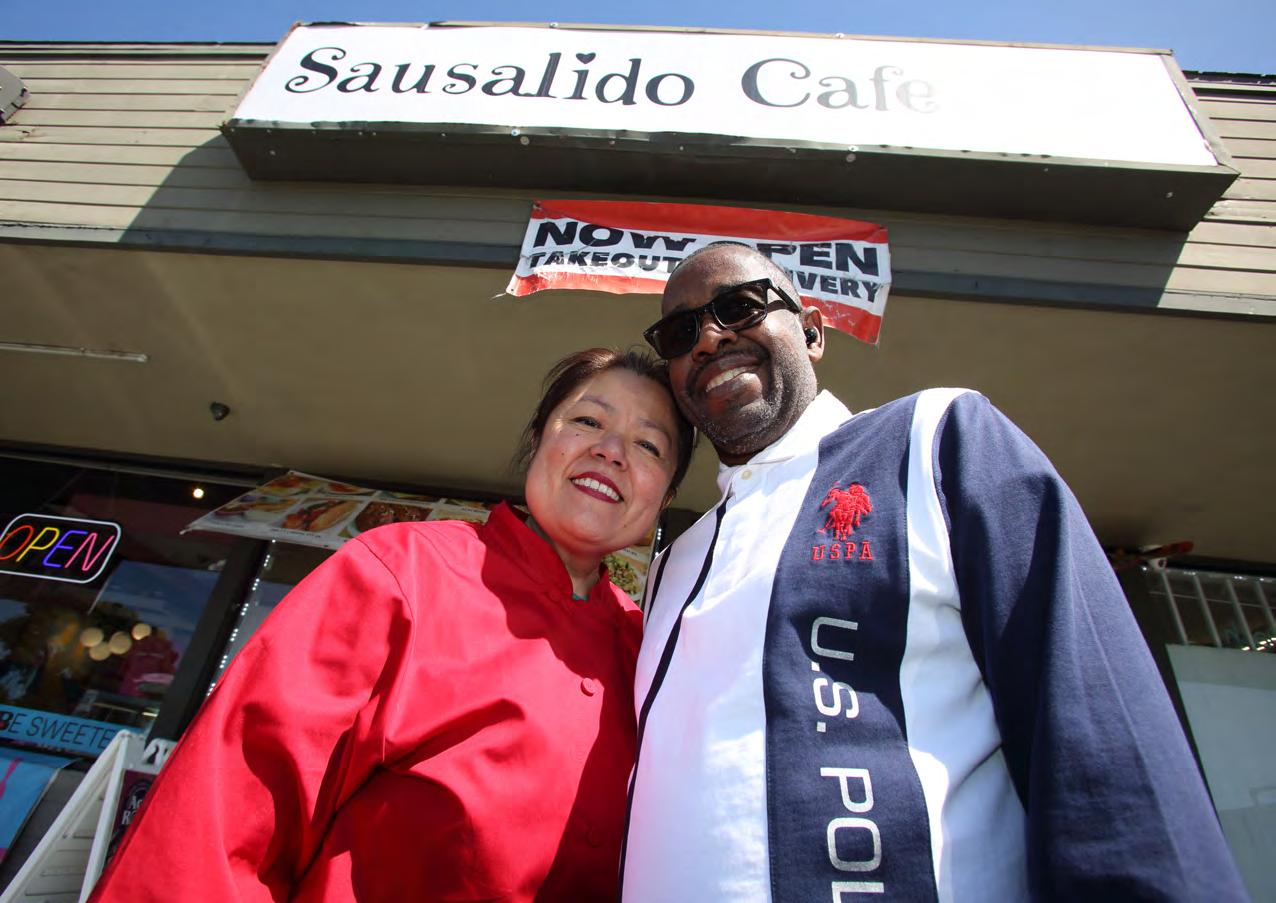
Obembe’s brother, Sam Obembe, friends with Liampetchakul introduced Liampetchakul and Obembe to each other, her 23 and him 29. Having each other in the same friend circles meant being in close proximity. Despite being near one another, they avoided each other.
“He hated me because he thought I was stuck up because I never said hi to him,” Liampetchakul recalls. “I was very shy, I did say hi to him, he just didn’t hear me.”
Their lives continued on separate paths, Between their busy schedules and respective relationships keeping them apart. It wasn’t until they both attended a financial seminar hosted by the World Financial Group for educational purposes
Warrior Life | 33
Julius Obembe and Lucy Liampetchakul opened Sausalido Cafe in April 2019 and worked in the restaurant industry for 19 years.
that their paths crossed again.
More than nine years after their first meeting, at 32 and 39, they would date.
The draw between them was undeniable, and as their relationship blossomed, they discovered shared humor, kindness, and admired each other’s intelligence.
“He also agreed with everything I said. What woman doesn’t want that?” she says.
Now they have five kids, Jermaine, Kevin, Tiffany, Denzel and Dylan aged 19 to 35. All are local except Denzel who resides in Atlanta.
Obembe and Liampetchakul’s road to opening Sausalido Cafe wasn’t a conventional one. Neither Obembe nor Liampetchakul was particularly trained in the culinary arts.
Despite growing up surrounded by restaurants, with her mom working at one and eventually owning her own, and her aunt and uncle partnering in another, the culinary field rarely crossed Liampetchakul’s mind. In fact, she was displeased by the idea. Even when working at a pizza establishment from the age of 16 until her early 20s, and later as a UPS implementation manager focused on customer service, her intrigue in the culinary world remained stagnant.

A friend offered to sell their business at Thai Garden, a cafe with outdoor seating in Marina Del Rey. Despite initial hesitation from Liampetchakul, in her mind, the responsibilities seemed simple enough.
“I figured, hey, it was to go only,” Liampetchakul recalls. “It took minimal work.”
Together with their sons and daughter, Obem-
be and Liampetchakul learned about the restaurant industry at Thai Garden where they worked for about 15 years as a family until the spring of 2019. This was when Obembe truly got to know the restaurant industry and started to develop his plans for his future business.
Now, Liampetchakul sports a bright red traditional chef’s uniform, exuding a sense of authority. Obembe, in a blue flannel, wears wide-rimmed glasses and an easy smile, standing behind the counter. A floral divider takes its place to separate the customers on each side of the counter. Occasional chit-chat fills the air as Obembe and Liampetchakul engage with their visitors.
Liampetchakul and Obembe move in unspoken and spoken communication when taking orders.
The two of them take turns pivoting to either side behind the counter with Liampetchakul in charge of kitchen duties, swiftly chopping vegetables, grilling, and frying, and Obembe maintains the cafe’s pristine appearance, diligently cleaning, organizing, cooking, and ringing up customers.
Often, Dylan Obembe, 19, their youngest son and student at West Los Angeles College lends a helping hand by taking orders, while their other children also pitch in whenever they visit.
It was only after Liampetchakul and Obembe stumbled upon a Shawarma factory in the center of an active community that the couple’s wish to open a cafe with indoor seating was satisfied.
Their hurdle was deciding between opening a restaurant or accepting an offer from Amazon to participate in their Delivery Service Partner program (DSP), where entrepreneurial individuals
It is nice to know that there’s a little cafe in your community that’s always looking out for you,”
“
VALERIA GUSMAN ECC FRESHMAN
34 | Warrior Life
Lucy Liampetchakul mans the kicthen and tends to the sizzling pan.
run their own package delivery operations.
The reason that motivated them to leave was the constraint of time with its fixed hours of operation at their previous restaurant.
This made it challenging for Obembe and Liampetchakul to support their aging parents and schedule a time to care for them. Various doctor visits and attending to their simultaneous medical conditions and surgery recoveries happened within a year — the couple had to drive between their parents’ homes.
Another reason for their wishes was to relate to their customers on a more personal level.
“When it’s raining, people can come in and sit down,” Liampetchakul says.
She says she was tired of not being able to converse with their customers at their former restaurant Thai Garden where customers ordered at the window and sat at picnic tables.
Now at their current location, the couple can better communicate the care they have for their customers. The location exuded an inviting atmosphere, with warm colors, soft lighting, and the comforting aroma of freshly made cocoa and steaming stir fried chicken.
Comforting, caring, reliable, and welcoming — that’s how Vanesa Garcia Gusman, a loyal customer of the establishment, describes Obembe.
As a full-time student at West Los Angeles College, Gusman recalls a day when she was stressed with classes and home responsibilities while balancing a full-time work life. She takes a break by skateboarding to the cafe for some food.
Vanesa’s fatigue was apparent as she approached the counter, her skateboard resting against her leg.
After the long and demanding day, she was immediately greeted by Obembe’s friendly wave and Liampetchakul’s inviting smile.
“As always, I was met with a welcoming presence which helped me disconnect from the stresses I was having at the time,” Gusman says.
That day, she ordered a variety of dishes. One Thai drink with boba, a Philly cheesesteak sandwich, and empanadas, not her typical order.
Obembe gives updates on the cafe and knowing that his business is doing well makes her happy, Gusman says.
“I’m always glad to visit the cafe every few months,” Gusman says.
Whenever Obembe and Gusman meet, they make sure to check in with each other about their lives. While Obembe tells Gusman what’s going on in the cafe, she confides in him about the ups and downs of her life events.
When she worked as a hostess, he would ask about her job and be one of the people she’d share her good and bad news with, such as getting promoted to shift lead or when she thought about quitting.
He’s one of the people she can always count on
to give substantial insight.
“He’s very familiar with faces. They always make you feel noticed” Valeria Gusman, an El Camino student and Vanesa Garcia Gusman’s sister, says.
When Valeria Gusman interviewed Obembe for a school project, she asked him what he enjoys about his job the most. He said he loves meeting people like her and is delighted when young people who are now graduated still come and visit, Valeria Gusman adds.
“It is nice to know that there’s a little cafe in your community that’s always looking out for you,” Valeria Gusman says.
Obembe’s support is just the beginning of what the restaurant offers.
With influence from various cultures, including East Asian, Southeast Asian, and American cuisines, Obembe says his restaurant takes after his mother’s heritage from Sierra Leone and London where he grew up. The menu includes dishes specific to London including fish and chips and chicken tikka masala.
“If we wanted Asian food our kids wanted American food,” Liampetchakul says. “Since we have a little bit of everything, it should satisfy a lot of people’s taste buds.”
For one, they aim to make sure their ingredients are fresh — to the point of making pasta dishes from scratch when it is requested.
They talk about many instances where customers call in for a specific dish and willingly wait half an hour for freshly made spaghetti and meatballs or Thai Chicken basil, another popular dish.
The perk is its classified status — many elaborate dishes have their place on the secret menu compiled with multiple handpicked dishes. The importance of having a dish on the secret menu is how much it mattered to customers.
Liampetchakul said the secret menu is still flourishing and is updated on occasion.
“We’ve had people visit from Bakersfield, New Zealand and Australia who frequently return when in the area,” Obembe says.
Many customers report that their dishes are well worth the wait.
The menu stood the test of time when a middle-aged woman with a blond bob named Betty Sarkissian bursts through the door on a rainy winter Tuesday afternoon, announcing that this was in fact her fifth visit in the span of a week.
“We were so happy we found this place, we’ve been eating here five days in a row,” Sarkissian exclaims, arms gesturing enthusiastically.
“Don’t tell nobody,” Obembe chuckles and moves out of his seat to attend to the customer.
It was the “friendly atmosphere and great food” that pulled Sarkissian into this inevitable fixation for her, her husband, and her grandchildren.
The customers’ meals aren’t the only product that keeps Sausalido Cafe customers pleased. The
Warrior Life | 35
customers are happy with the meal and the many courtesies they receive, but it is the constant access to help the community that impresses them.
President & CEO of the Torrance Area Chamber of Commerce, Donna Duperron is an advocate for local businesses in the South Bay area.
“Mom-and-pop businesses are increasingly becoming more engaged in their communities,” Duperron says. Often, this can be done through a social media presence or by collaborating with other businesses, she adds.
By supporting others in a local restaurant community, it can demonstrate commitment to peers and build stronger relationships.
Students looked to Obembe’s cafe as a place to study. This tradition dates back to before the pandemic when the cafe first opened in April 2019.
They would often try to help students and faculty by providing them with encouragement, emboldening them in their future plans.
As a full-time student at West Los Angeles College, one thing was certain, Gusman heard his encouragement loud and clear.
“He [taught] me not to forget where you come from, to remember that that’s a place that I should go back to,” Gusman says. “Going into my field or when meeting new people, I should reconnect with those past relationships or the places I’ve been to.”
With the cafe as a leading example, Gusman has applied this notion to the other community she’s a part of. Being a member of the church gives her the opportunity to serve on occasion. This is the place where she hopes to reconnect while continuing to foster her relationships.
This service wasn’t strictly for college lifestyles but paved the way for business and career opportunities too. They would often help individuals by recommending someone or something they thought would be a good match for them.
“When I’m not cooking, I try to ask people what they do so when students come in, I can refer them to the right people,” Liampetchakul says.
When a student named CJ wanted work in the electrical trade, Liampetchakul remembers Obembe racing to find a fit for him. Obembe knew of a program with the Los Angeles Department of Water and Power, and gave him information so that he could get his credentials as an electrical helper, Liampetchakul says.
As soon as the students got a feel for the restaurant ambiance and culture, they would say, “this is our new hangout spot,” Obembe says.
However, nothing was that simple for this cafe.
Right as the pandemic hit, Liampetchakul told the students and youth to stay home with their families.
“Fortunately they listened,” she recalls with a smile.
Even before the pandemic, Sausalido Cafe
faced tough moments.
Despite the many positive word-of-mouth testimonies and the highly rated Yelp reviews surpassing big chain restaurants, people preferred to go to restaurant chains such as The Pan and iHop. Some even criticized the restaurant when it was recommended to them.
One possible contributing factor to these occurrences was the ongoing pandemic and the Black Lives Matter protests, which may have influenced their general perception of the restaurant, Liampetchakul suggests.
On some days, people came in and would instantly turn away because they saw an empty restaurant. They look at the menu, see that Obembe is the only worker, and then leave.
It was business as usual months before the pandemic when a car broke into the storefront because of an incident with a dog on a driver’s lap. The woman involved came back to report that there were no injuries. Since then, Obembe has changed the layout of the restaurant to create a safer environment in case of future accidents.
As the woman’s car ran through the storefront, it added to the difficulties Obembe and his customers were already experiencing during the pandemic. Even with ongoing delivery services, he and his wife were disappointed with the boarded-up appearance of the store because it meant that it was less attractive to customers.
And for a while, it was.
The brush with grievances is a probable cause for Obembe and his wife to back down, yet, their family persevered.
Obembe and Liampetchakul’s calling is a personal mission to serve the community first.
“I don’t see that dollar sign, I see you as a person,” Obembe says. “If you’re full and you’re happy, then I’m happy.”
Drawing inspiration from a cherished sitcom called Cheers, set in a bar with humorous and heartwarming moments, Liampetchakul hopes people who come to their restaurant can feel the essence that the sitcom’s theme song “Where Everybody Knows Your Name” embodies.
“You wanna go where everyone knows your name, and they’re always glad you came,” Liampetchakul belts out heartily.
The two are reminded of a youth named Michael that visits with parents from Northern California. The couple feels like their restaurant could represent the community’s neighborhood cafe for Michael and many others, where those come to feel known and welcome.
“You talk to them like you would talk to your mom and dad,” Obembe expressed.
“You have that neighborhood cafe that you love to go to because you’re not home and your parents aren’t near,” Liampetchakul adds. “It reminds you of home.”
36 | Warrior Life
 Cafe owners Julius Obembe and Lucy Liampetchakul sometimes work with their 19-year-old son Dylan Obembe at Sausalido Cafe in Torrance.
Cafe owners Julius Obembe and Lucy Liampetchakul sometimes work with their 19-year-old son Dylan Obembe at Sausalido Cafe in Torrance.
Warrior Life | 37
“If you’re full and you’re happy, then I’m happy.”
- JULIUS OBEMBE
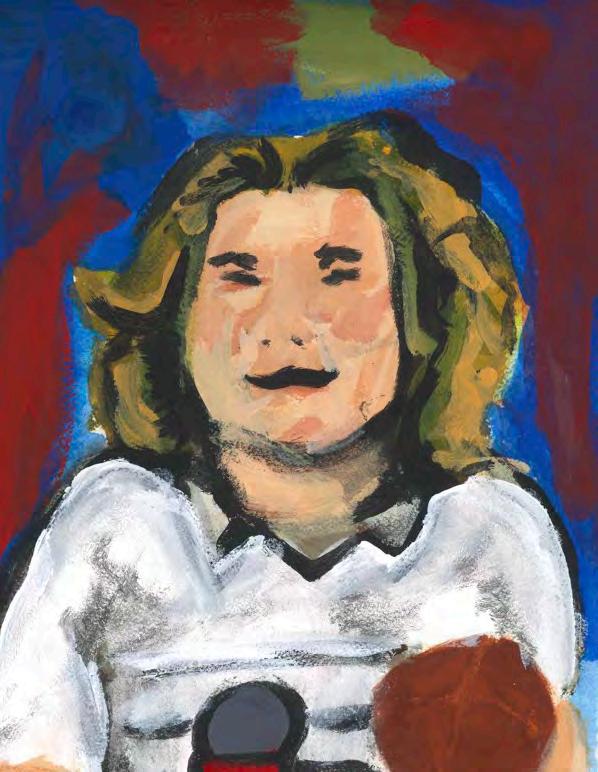
38 | Warrior Life
Who am I outside of playing sports?
Switching my dream from professional sports to sports writing
Story by Johan Van Wier Illustration by Patrick Morehead
Playing sports was my whole childhood up until high school, which created the mindset for me to become a professional in sports. I always have dreamed of this, while always watching the pro-athletes on TV, growing up and looking up to them.
Playing sports as a young kid can have pros and cons. Whether it’s the unreal expectations, the pressure, or having the time of your life with your teammates and friends while playing the sports you love. With all the success we can achieve at such an early age, we get the idea that we can do this forever.
Beginning in high school is where you start to showcase your skills to future college coaches. I played football all four years of high school but at the end of my senior year, I had to face the harsh reality that playing sports would not be my future.
My teammates and I reflected after the football season, wondering what will be next for us after the end of last season. These are the guys I have been with for the past four years, six days a week, practicing and working together. We had all played sports for as long as we can remember and now we were unsure what to focus on next.
There were so many summer workouts that filled my entire summer, to being at practice for 8 hours, practicing and watching film, preparing yourself the entire week for game day. I started to wonder what this was for. Why did I spend all this time in high school giving my time to something I will never do again in my life, feeling like I wasted my time.
Sports have always been my life so transitioning from a student-athlete to a full-time student was extremely hard when I got to El Camino. You are now the spectator, not the player. You have this dream that you have followed for 15 years and suddenly at 18 years old, you can’t fulfill it.
Having a conversation with my football coach made me realize what sports could offer something
off the field as well. My coach instilled discipline in my teammates and me and always showed us what was important outside of the football field. We never came to the realization while playing, only after, that playing sports all through your life giving the groundwork for your real dream.
My coach told me after the season, “If you are not fully 100 percent invested in it, why do it?” Hearing this solidified my decision on football. It made me content with not playing anymore–while being happy about the time I had.
I felt lost after not playing sports for a while. Although playing football at El Camino was an option, after not playing for a while the option did not seem as intriguing. I felt like now was the time I could focus on school more and change my dream. Instead of chasing the dream I had my whole life –I needed a new start in my life.
It was a tough time for me to have all this free time and getting into whats is next after football. It is a whole different mindset after finishing your lifetime sport.
Transitioning my dream of sports to something we can do off the field made me figure out, what am I outside of football? I had to quickly transition myself to think what is next for me, but the whole time it was in front of me, sports. Whether you are playing or covering, I can realize that I do not need to completely leave what I love the most.
I chose to study journalism in college because sports is still a part of me. It’s still what I love the most. I am always watching sports shows, reading articles, staying updated in that world.
I am always driven by sports and constantly keep up with the current news in all sports. Covering sports is the new dream to chase.
Sports will be in my life forever, and while I can still play, now outside of playing I can shift to now becoming the spectator – still learning and studying journalism to cover what I still love the most.
Warrior Life | 39
Filipino Food Galore

Here’s some of the best local Filipino restaurants and eateries near El Camino College
Filipino food is a popular choice for students looking to eat hearty amounts of food without breaking the bank. Here are the Top 5 locally-owned Pinoy eateries near El Camino College on a student’s budget.
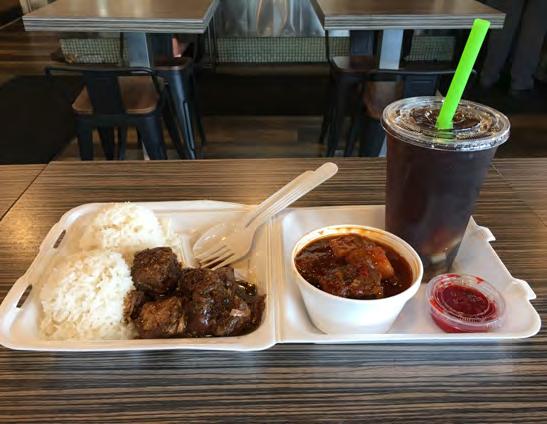

1. Pick Your Plate, Hawthorne
Based in a cozy restaurant on Inglewood Boulevard, Pick Your Plate has all the bases covered on traditional Filipino food. Their one item combo for $7.99, in this case a plate of pork sisig with rice, gives a great mix of flavors. The savory soft pork mixes with the snap of the onions and bell peppers and is complimented by the rice as it soaks up the flavors of the pork juices.
Address: 11943 S Inglewood Ave, Hawthorne (4.2 miles)
Phone: (424) 456-4803
2. Tita Celia’s, Carson
For 33 years, Tita Celia’s has been serving the Carson area with traditional Filipino food. The pork adobo (Combo E, $11.75) is covered in a salty, savory sauce, served in large portions. The large portions of rice act as a palette cleanser while the beef mechado, served separately in a cup to accommodate the stew, warms the body with its hearty flavor and big pieces of soft potatoes and braised beef. A large cup of sago’t gulaman ($2.75), a traditionally sweet Filipino drink, adds a nice minty touch to the meal.
Address: 621 W Carson St, Carson (5.7 miles)
Phone: (310) 834-6289
Website: www.titacelias.com
Story and photos by Raphael Richardson
A plate of pork sisig and rice from Pick Your Plate gives a great mix of flavors.
40 | Warrior Life
A plate of pork adobo, rice and beef mechado, with a side drink of sago’t gulaman warms the body with its hearty flavor.
3. Manila Sunrise, Carson
A quaint restaurant, Manila Sunrise offers a good spread of budget-friendly foods that are still delicious. Their one item combo of bicol express and rice, ($6.95), offers a good combo of spice from the peppers mixed with the mild heartiness of the pork, with the rice filling in the rest. The vegetable lumpia, ($2.29), is packed full of minced veggies to get your greens in your meal time.
Address: 21828 S Main St, Carson (7.1 miles)
Phone: (310) 835-2800
5. Pinoy Big Mouth, Wilmington
Located in the parking lot of a church, this food stand offers a more traditional feel of Filipino cooking. A skewer of raw pork costs only $1.50, which you can cook yourself on the woodfired grills provided by the stand. For those who want a snack on the go, you can buy a six-pack of crispy pork lumpia, with accompanying sweet and spicy sauce, and a cup of homemade pineapple juice for $4 each.
Address: 444 E Lomita Blvd, Wilmington (8.6 miles) Phone: (310) 408-1551
4. Manila’s Lechon, Carson
This strip mall restaurant is convenient for people in a rush to eat. In lieu of a full plate, Manila’s Lechon fast service offers skewers of meat at a reasonable price. Their skewers of barbecued chicken and pork ($3.50 each) are filling and flavorful, and the turon (a desert-style lumpia, $1.25 each), adds a sweet touch to the savory meat.


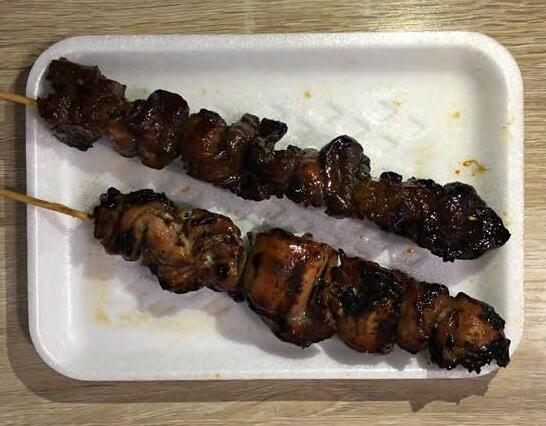
Address: 118 W Carson St (6.2 miles)
Phone: (310) 935-2209
Website: manilaslechon.com

Warrior Life | 41
A box of bicol express with rice, along with a single vegetable lumpia offers a good combo of spice with mild heartiness.
Two skewers of barbecued beef and chicken from Manila’s Lechon are filling and flavorful.
A set of six pieces of lumpia with dipping sauce, with a cup of pineapple juice, is crispy, sweet and spicy.
A Stream cries for help
Trapped in a grave of cement, Dominguez Channel struggles to survive
 Story and photos by Alexis Ramon Ponce
Story and photos by Alexis Ramon Ponce
42 | Warrior Life
The 15.7-mile-long Dominguez Channel crosses 10 cities and unincorporated areas in its path to the Pacific Ocean. It is part of the Dominguez Watershed, which covers most of the South Bay.
Quietly, but full of life, a creek emerges from underground in a tranquil neighborhood in Hawthorne, only to be encapsulated into a giant channel of cement that has trapped the body of water for decades. There are birds singing in the surroundings. They are flying free, which contrasts with the sound of the jailed stream known as Dominguez Channel.
It flows from Hawthorne and travels free and almost natural through El Camino Village. The channel’s meandering trip continues through the iconic Alondra Park, Torrance, Gardena, Carson and Wilmington. It extends to the Port of Los Angeles in the San Pedro Bay area and finally touches the waters of the Pacific Ocean.
On South 117th Street, close to where the creek starts its adventure, there’s a young couple: John and Melissa Gregorio, residents of the neighborhood. John has lived there since 1996 and he’s been witnessing the transformation of the environment of the little river ever since. Even though the place looks quiet, there’s a lot happening during the day, but most especially at night.
“The homeless population has increased in the area,” John Gregorio says.
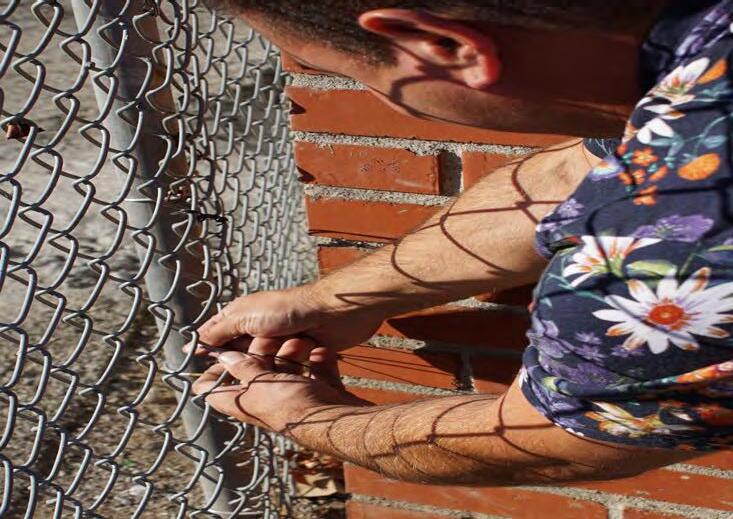
With wire and a pair of pliers, he fixes a broken fence. Someone cut it the night before to get in or out of the restricted area where the creek is. He explains that before the COVID-19 pandemic they used to see kids near the stream, riding their bikes, walking, running, playing and exploring. However, that has changed because now, homeless people are the explorers.
Nevertheless, residents have to deal with another issue: bureaucracy. The creek is under Los Angeles County jurisdiction, but the neighborhood belongs to the city of Hawthorne, bordering on the city of Inglewood. When residents need to call authorities to report an issue related to the channel, the answer is always the same. “It’s not our jurisdiction.”

Dominguez Channel is like a poor relative everybody knows that exists, but many just try to ignore. The creek says hello to the southwestern part of El Camino College, crossing in silence under the institution’s Parking Lot F.
15.7-mile-long Dominguez Channel tells a tale. Not long ago, it had a diversity of fauna and native plants – some of which could only be found here. Moreover, there were many species of insects, mammals, birds, fish, mollusks and crustaceans. But, the fairytale is over and the creature is now caged and abated by tons of cement.
The saying goes, “Big problems demand drastic actions” and that is what was applied to this spot of nature to placate its wild and free impetus.
There were some floods and a few fires in the surrounding
Warrior Life | 43
The
Dominguez Channel begins near 116th Street and Cherry Avenue in a quiet neighborhood near the border of Inglewood and Hawthorne. It flows through the South Bay, into Los Angeles Harbor, then into the Pacific Ocean.
The saying goes, “Big problems demand drastic actions” and that is what was applied to this spot of nature to placate its wild and free impetus.
Hawthorne resident John Gregorio fixes a fence near the source of the channel. “The homeless population has increased in the area,” he says.
lands in the past. One of the fires occurred in 1941, before ECC was conceived as an institution and before L.A. County decided to change the image of the river forever.
“It is what it is,” Torrance resident Mark Smith says about the cement encasement of the creek.

Smith is a man about 70 years old – he doesn’t like to say his age. He walks along the bike path above the channel, between Manhattan Beach Boulevard and West 154th Street with his black fox terrier dog.
“I used to come here every other day in the afternoon, but not anymore,” Smith says. “All the trash around and also all the weird people living on the trails might be dangerous. It’s not safe anymore, but it is what it is.”
Smith refers to homeless people living along the trail.
“It seems like it’s nobody’s problem,” Smith says. “It is what it is.”
The creek’s watershed fate is uncertain. L.A. County’s Sanitation and Environment Department (LASAN) explains on its website that Dominguez Channel and other select waterbodies in its watershed, including the L.A. Harbor, are impaired by pollutants like trash, metals, bacteria, and nutrients. This is mainly due to the watershed’s large, dense population and the amount of impervious ground surface that prevents large quantities of runoff from infiltrating into the soil.
In its trip along El Camino College and Alondra Park, Dominguez Channel passes close to another body of water: The Alondra Park Lake. Dominguez Channel’s close relative is like a lavish aunt who comes to visit and wears way too much perfume, and who always pinches your cheeks in greeting.
Everyday many visitors come: people, squirrels, duck, geese, dogs, even coyotes and other species give the place a noisy, yet relaxing, environment to visit.
There’s a woman standing in the shallow part of Alondra Park Lake. She is dressed to work: blue jeans, a safety vest and tall black rubber boots. Her name is DeAna Vitela and she is a biologist.
Vitela is the founder and CEO of Gardena-based AquaBio Environmental Technologies. “Helping nature heal itself” is AquaBio’s slogan and it has specialized in the applied science of bioremediation and biomimicry for industrial and municipal wastewater, among other services.
Vitela takes her job seriously. Slowly and quietly she’s taking samples of water to later take to a laboratory to identify the levels of nutrients, such as ammonia and other components.
She later takes measures to clean the lake, as well as other waterbodies in the South Bay. These samples are then sent to a laboratory where they are analyzed, and based on established parameters, determine the levels of bacteria, minerals and
44 | Warrior Life
One of the entrances to Laguna Dominguez Trail, the bicycle path along Dominguez Channel, is on Manhattan Beach Boulevard near El Camino College and Alondra Park. Residents of the area use the path to exercise, though there has been a rise in homeless encampments.
other components to prove the quality of the water.
In the worst-case scenario they proceed to apply the right measures to obtain optimal levels. The results and actions to be taken are shared with the L.A. County Parks and Recreation Department and LASAN.
While she is trying to get some samples of the algae and sediments, she says that the way they clean the lagoon is natural. They don’t use chemicals. Instead they use microorganisms.


As a professor of the ecosystem, Vitela knows about the problems around Dominguez Channel all too well. The creek’s water doesn’t come to the lake, but the overflow of water from the lake goes to the channel. The proximity of both bodies of water is an issue because in the end, they are connected.
She emerges from the musty-smelly water and puts the pail in the back of a big white pick up truck, along with other tools and algae samples. She then cleans her hands with sanitizer, carefully cleaning her long, well-kept, painted nails. Every nail is painted a different vibrant color. She wears many bracelets made of semi-precious stones.
“For good energies,” Vitela says.
Since 1987, she has worked in the research, development and application of bionutrients to the environment, as well as nonpathogenic micro-organic degraders – those that don’t cause disease, harm or death to another organism.
Vitela has specialized in wastewater remediation using different forms of life like microorganisms to consume and break down pollutants, in order to clean up the environment. She has been involved in the process of the restoration of both fresh and marine water habitats and lake management. As a biologist, she also works cleaning retention basins, waste treatment facilities and aquaculture facilities.
“I have been investigating because [Dominguez Channel] is attached to some of the other sites that we manage. The channel does need help because it is a watershed in an urban area. All runoff goes into it. If the water is not treated, it accumulates over time and then all goes to the ocean,” Vitela says.
A flock of geese passes nearby, filling the air with their nasal honk. Then they go into the water.
“The channel,” she resumes, “needs us now.”
Vitela recalls an important incident. In October 2021, when the putrid water traveled through Dominguez Channel
to Leeward Bay Marina in Wilmington, it released hydrogen sulfide into the air that killed fish and sickened people around the area.
“When they had the spill, I was contacted and I could talk to the city about that. I let them know some of the things we normally do [in cases like this], but they chose to put odorant and maybe some micros, but they never tested [the water] that I am aware of,” she says.
She takes a little moment to think.
“I gave them a list of testing to do and the cost to do it. I don’t know if they just cover the smell and let nature slowly handle it, instead of remediating it out of the system.”
Back in 1952, after a severe flood and other incidents, like mosquito plagues and fires, L.A. County decided to build the 15.7 mile channel with concrete to encapsulate the river. The city faced another problem: the difficulty of developing more housing projects in the South Bay due to the wetlands. The problem was solved cosmetically, but it created another bigger issue: damage to the ecosystem and surrounding cities.
To this aggressive measure taken 70 years ago, Vitela’s opinion is that it was the worst thing they could have done. An
Warrior Life | 45
Biologist DeAna Vitela inspects plants growing in the waters of Alondra Park Lake. “There is still hope to save the creek,” she says.
Biologist DeAna Vitela takes water samples from Alondra Park Lake to be tested. Vitela is the founder and CEO of Gardenabased AquaBio Environmental Technologies.
unnecessary measure because there were more choices to solve the problem.
“Like meandering the watershed. Meaning that instead [of] the creek [going] in a straight line to the ocean, we create a snake shape. The more meander it gets, the longer the river has the chance for the pollution to settle,” she says.
During this process the polluted water would be downgraded slower in its trip to the ocean.
“It is even more important to talk about trees, plants and bushes to have a balance in the environment. Nonetheless, by transforming a healthy creek into a cemented dead-unaesthetic channel, [L.A. County] destroyed the stabilization of the land,” Vitela says. “When it rains, the runoff is so drastic with all of the nutrients going directly into the bay and of course, this changes ocean life.”
The afternoon wind blows. Vitela takes a deep breath and tries to fix her thick, curly hair with her hands. “I brush my hair all the time, but not today,” she says ruefully.
A duck in the park is calling and other ducks do the same. Vitela looks in the direction of Dominguez Channel through her sunglasses and retouches her hair once more. She looks at a big tree and follows the branches that play with the wind.
Vitela is optimistic about the present and the future of the channel.
“There is still hope to save the creek,” she says.
“[L.A. County] can surely help the river by allowing plants to grow and not try to kill it. Let the ecosystem take over. Plants can do it better in soil stabilization,” she says. “Besides, those plants are great for pollution control and an excellent food source for the animals. They don’t necessarily have to be inside of the water, but in the hillsides.”
The biologist explains that the procedure is something that has been done in other bodies of water before, like the Los Angeles River and Machado Lake in Harbor City.

Rehabilitating and restoration of rivers and lakes is not a new matter. Another example of restoration is Ballona Creek, primarily in Culver City and Marina Del Rey, which is being reforested along with its estuary and marsh.
Vitela believes that everyone can help, not only Dominguez Channel, but all the environment.
“In a multicultural city, we can do something relevant,” she says.
In order to do so, the key is fifth graders because those kids are focused. They are concerned about the environment and what they learn, they take home and instruct their families to change little ways, she says. Fifth graders can motivate families to take action that will yield great-exponential results.
To protect the channel immediately and have long-lasting
“Mother Nature took care of us. Now is the time that we take care of Grandmother Nature.”
- DeAna Vitela
46 | Warrior Life
Reforestation and restoration of rivers and lakes is not a new matter. An example is Ballona Creek in Los Angeles County, which is being reforested along with its estuary and marsh.
results, Vitela encourages everyone to be involved in picking up garbage. She explains that there are groups of volunteers that clean the walkways around the lake and the park.
“Some fishermen, as well, clean the wires from the fishing lines out of the water, so those wires don’t hurt birds. We need more people like them,” she says.
“Both schools and the media need to do more to educate and raise awareness about respecting nature. They are not doing enough,” she says. “If everybody can help a little bit, maybe just a tiny bit, like picking up trash can make a big difference, or just go ahead and pick up your trash.”
In this matter, Vitela’s opinion is that ECC can help with the problem in the trails along Dominguez Channel by having campaigns among the students to help L.A. County clean the paths and teach people ways to maintain the trail.
On the other hand, ECC does not currently have a program for students and faculty to contribute by helping the environment around its perimeter, according to Amy Grant, dean of ECC Natural Sciences.

Talking about Dominguez Channel’s past, present and future, Grant doesn’t have much information and declined to state a position. She explains that the focus is not on how to care for the environment. They don’t have those classes, she explains.

Before Vitela goes back to work in the lake’s water she pauses.

“Even though some people want to deny it, this is an issue. Changes in the climate are real. They are here.”
She refers to warmer winters, long droughts, huge hurricanes and wildfires that continue to affect the population of this planet.
“Mother Nature took care of us. Now is the time that we take care of Grandmother Nature,” she says.
Warrior Life | 47
Biologist DeAna Vitela works cleaning Alondra Park Lake. She is optimistic about the restoration of Dominguez Channel. “There is still hope to save the creek,” she says.
An albatross flies free over Dominguez Channel.
Biologist DeAna Vitela shows snails born in the waters of Alondra Park Lake. “There is still hope to save the creek,” she says.

48 | Warrior Life
A flock of Canada Geese swim in the waters of Alondra Park Lake near El Camino College on Sept. 15, 2022. The overflow of water from the lake goes into Dominguez Channel.

Warrior Life | 49

50 | Warrior Life
Searching for gender identity My life as an oyster
Story and photos by Kim McGill Illustrations by Fumie Coello
As a little kid, I wanted to be a boy. I mean, I was fully committed.
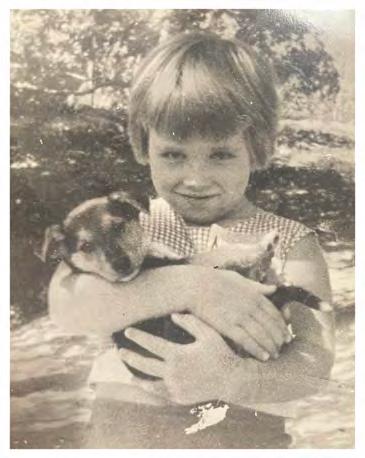
The first time I got suspended from school was in preschool, because for a week I refused to sit down when I went to the bathroom. We all had to line up to pee at the same times every day. So, everyone saw this conflict between me and the school staff play out.
Finally, the teachers got fed up and told me that I had to sit down because I “didn’t have a penis.
“I’m growing one,” I said.
My mom was called to pick me up immediately.
By the time I was in elementary school, I invented a different boy persona every week from all over the world, wrongly and embarrassingly appropriating many cultures.
I ran around the neighborhood as a warrior in my underpants with dish towels stuck into the front and back of my waistband, shirt and shoes off, with war paint applied to my face and chest with my mom’s lipstick.
I refused to answer my mom unless she called me by that week’s name - Pedro from Mexico, Sean from Ireland, Tino from Tahiti. As Hans from Switzerland, my dog and I laid in the ice plants on the hillside overlooking the freeway pretending to herd our sheep.
I played Tom Sawyer with a friend who was female. We were Tom Sawyer and Huck Finn, and we made her little brother dress up as Becky Thatcher. I don’t remember exactly how their parents reacted, but I remember the tension.
Our creativity was not appreciated.
I credit my mom for never making me feel unwelcome or strange.
She went along with all my playing at different gender roles. She took me to get my hair cut short. She never forced me to wear dresses, although I could tell her disappointment in how I looked and dressed.
On Christmas mornings, my mom made sure I had Hot Wheels, a GI Joe, superhero action figures and a toy machine gun that made the coolest sound until I filled it with sand.
I often wish I had asked her before she died, “What was it like having such a strange little kid?”
I wonder about the battles she must have fought behind my back, or the way she defended my decisions despite what she might have wished for me.
Listening to Dodger games on the radio was something I loved doing with my mom. I was a “bat boy” for community baseball leagues and girls’ softball teams, and my mom took me to the games regularly. I think she saw how much I loved it.
I decided that I wanted to be a professional baseball player. But, one of the most memorable heartbreaks of my childhood happened when I was about 6, and my dad said I could never play for the Dodgers because I was a girl.
Not long after that, my friends who went to Catholic school were devastated that a teacher they loved was leaving because nuns couldn’t become priests.
I held on to that as another example of the regular crushing of little girls’ dreams.
I noticed that I and all the other little girls had chores.
We were cooking and cleaning, ironing, making beds, doing laundry and babysitting at a very young age.
It wasn’t lost on us that our moms came home from one – sometimes two or three jobs – only to work late into the night doing everything to feed, care for and clean up after their families.
Meanwhile we saw the boys outside playing or lounging for hours with their fathers in front of the TV. We also witnessed the lack of appreciation or criticism of our moms’ labor.
I started to think, “Why would anyone want to be a girl? Girls don’t get to do anything fun.”
Gender disappointment and discrimination increased as I got older.
In third grade, I was playing “three flies up” with the boys during recess, when a teacher snatched me angrily from the
Warrior Life | 51
game and made me play with a group of girls jumping double dutch.
I pouted and refused, so she sat me on the bench as a punishment. When I started to talk to a boy sitting there, she punished me further by making me lie in the dirt and cobwebs under the bench.
In middle school, I earned a spot on the boys’ football team as the place kicker, punter and one of two quarterbacks. But the other schools complained, and I was removed from competition.
I don’t remember having any discussions with adults about sex, identity or development.
To my amazement, my mom was always patient and supportive. But she didn’t seem to understand or want to discuss what I was experiencing.
Even as little kids, everyone was experimenting - playing house, playing doctor, pursuing crushes. There was a huge disconnect between what we were doing and what our parents and teachers thought we were doing.
One day I was eating dinner with my family and I said a girl told me that when I got older, every time I went to the bathroom, I would bleed.
My dad always looked angry. But, that was the only time I saw him look afraid. He told my mom to deal with it and fled the table.

The next day, my mom showed me a giant, scientific text book with complicated diagrams identifying body parts. That conversation flew way over my head. That was the first and last time that I got any sex education other than on the streets, playgrounds and backyards of my childhood.
At the start of fifth grade, I went to a school where I didn’t know anyone. I could hear the whispers and dreaed being asked about my gender. When the teacher forced us to stand at opposite sides of the room for a spelling bee, girls on one side, boys on the other. I had to choose.


I never felt so alone in a crowd.
When people aske me, “Are you a boy or a girl,” I would answer, “Maybe.
By sixth grade, I was at war with my body, especially devastated by the development of my breasts. We had a concrete floor, without a rug or carpet. For months, I would lie on the floor to watch TV with my body pressed into the cold, hard floor, hoping that I could force my breasts to stop growing. I wouldn’t use a pillow, thinking that lifting my head even slightly would release the pressure of the floor against my chest.
Before leaving the house, I wrapped my breasts tightly in an ace bandage to flatten them, a practice I recently found out is both common and dangerous.
I fought with my dad always, even as a toddler. We had a mentally, emotionally and physically volatile relationship until he disappeared. I don’t remember many conversations about anything, and never about my identity, except once.

I was playing ball, and he came outside visibly angry and yelled at me in front of everyone.
“Get the f--k in this house and put on a bra.”
Not long after that, he left L.A. I never saw him again except for two very-short conversations less than three minutes long, and one phone call that also lasted only a few minutes.
By high school, I had given up. I tried to be and dress like a girl to fit in. I grew out my hair. During one torturous semester, I was a cheerleader.
But despite these efforts, I was much happier as I played on the boys’ high school soccer team, traveled with the boys’ varsity football and basketball teams as their statistician, and played in a men’s community softball league.
A few years later, I was living in the South Bronx.
For the first time, I knew young people who were radically stretching every societal and family definition of who they were versus who they were told they “should” be.
Especially among the queer house communities in the ball scene and the numerous youth of color reclaiming the west side piers along the Manhattan riverfront, young people carved out a safer and more supportive place for themselves than what they had experienced
52 | Warrior Life
uptown and in the outer boroughs.
They began to expose their sexual exploitation at the hands of older, richer white males, and fought back against the white gay world that dominated New York City’s queer politics.
Young people made brave and ferocious pronouncements of their racial, gender and sexual identities, despite facing exile from their homes, brutal violence in schools and on the streets, and terror at the hands of the police.
Still, most families, schools and neighborhoods had no vocabulary - let alone acceptance - for gender non-conforming, transgender, or gender fluid people.
Then, by 2010, new courage and confidence was erupting everywhere in how people identified themselve as well as in the ways they rejected strict gender boxes and expectations.
A sexual and gender revolution was happening.
Knowledge and discussions about transgender and non-binary identities rapidly increased. Artists included more complex and diverse characters in films, television and music. Gender dysphoria gained wider exposure and treatment options and resources expanded, even in the most dangerous spaces for queer people, including jails and prisons.
Generations before colonization, genocide, religious fundamentalism and the forced removal of children from their communities into boarding schools, orphanages and foster care, many cultures had words, roles and acceptance of queer identities. Some indigenous nations have honored “two-spirited” people as skilled healers and religious leaders for centuries.
I wonder how different my life - and the lives of millions of others - would have been if we had just been born at a different time or place in history.
There are many who think the rejection of gender norms and expectations is sick, or contagious or dangerous, and that people are confused or “choosing” non-conformity.
But, so many of us are confident at the age of three or four that the labels we were given at birth just don’t fit. We take on the whole world to demand a different life for ourselves. That confidence is what we should all look to as the ultimate and essential truth - we are born this way.
Unfortunately for too many of us, that confidence is shortlived.
In our deepest memories, we know who we are and how happy we are when we can just be ourselves. But family, religion, school and politics beat us back into a box, or worse cause us to look toward addiction or suicide to escape.
LGBT2IQ2 (lesbian, gay, bi-sexual, transgender, two-spirited, queer and questioning) youth are “four times more likely to seriously consider suicide, or to attempt suicide versus their peers” according to The Trevor Project.

For me, determining who I was and how I define myself changed often.
As people began to fully describe their identities instead of just introducing themselves, and added pronouns to email signatures and nametags, the closest thing I could think of was that I was most like a 10-year-old boy - someone who loves cartoons and comics, loves Star Wars and superhero movies, plays too rough, loves to jump in the mud but never wanted to soak in a mud bath.
But I rarely said it.
It didn’t seem mature, respectful or thoughtful. It wasn’t “deep” enough. Just like that little kid that answered “maybe” when aske what I was in fifth grade, I always say now, “You can use any pronoun for me.” And I mean it. I feel comfortable being all of the above. But, I haven’t met anyone else so noncommittal.
In 2019, I had the opportunity to travel to London.
Before entering their public train system for the first time - the “Underground” or what Londoners also call “the tube” - I bought a Snapple.
I popped the cap, and the fact underneath said that “oysters can change from one gender to another and back again.”
“Hmmm,” I thought, “that’s interesting.” I walked downstairs and inserted money to purchase my Underground access card. It came out of the slot and I read, in big letters, “Oyster” card.
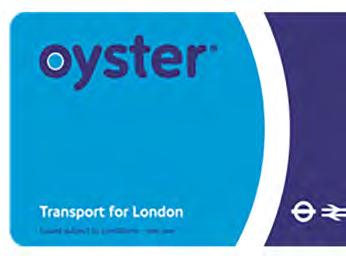
“What? That’s crazy!” I almost said it out loud and laughed.
I took both the Snapple cap and the Undeground pass as a significant sign. Since then, I have identified myself - and come to accept myself - as an oyster.

Warrior Life | 53
The ‘not-so-spicy’ Vaca family salsa recipe
By Brianna Vaca
Photo by Raphael Richardson
For those who want to indulge in the taste of a pico de gallo salsa, without the heat, try the Vaca family’s not-sospicy, not-so-secret recipe.
My mother Erica Vaca began making this salsa recipe in 1991 without any spices because her husband, my father Shawn, dislikes spicy food. The Vaca family requests this salsa from my mother at least two or three times a month. Normally it is eaten alongside tostadas and tacos, but it’s filling enough to sometimes be a meal on its own.
Preparation time: 10-15 minutes
Ingredients:
- 5 medium Roma tomatoes
- 1 bunch cilantro
- 1 ripe avocado
- 1 small red onion
- 2 large limes
- A pinch of salt (for taste)
- Tortilla chips
- *Optional 1 small jalapeno or serrano pepper (for spice)
Directions:
Step 1: Gather all vegetables and wash them.
Step 2: Once all vegetables are washed, dice tomatoes into small cubes and chop the cilantro, avocado and onion. Do the same to jalapeno or serrano pepper if used.
Step 3: After the vegetables have been chopped and diced, place them into a medium bowl. Then with a spoon, mix lightly.

Step 4: After mixing, add the avocado and continue to mix adding lime and a pinch of salt simutaneously for taste.
Step 5: Once completely mixed, serve on a nice plate with tortilla chips and enjoy. Add peppers to the top if you don’t avoid spices like my father.
54 | Warrior Life
MATCHA LOVERS LOCAL GUIDE
From lavender to strawberry, there are delicious ways to drink matcha latte
Story
by Nindiya Maheswari
There’s never a bad time to enjoy a cup of matcha, a green tea powder that is rich in antioxidants and mixed with milk. Matcha’s popularity has reached new heights in the South Bay, so now is the perfect time to go on a matcha adventure. Trendy coffee shops and boba cafés began introducing exciting matcha variation infused with a fruity, sweet, and even flowery flavor.
Lavender honey matcha
Iced lavender matcha latte from Newberry Coffee and Tea has a slightly sweet flavor and flawless floral hint of lavender syrup and honey. Regular size lavender honey matcha costs $5.50 while the large size is $6. The lavender honey complements the bitterness of the earthy matcha tea. Milk alternatives are available for $1 more.

Newberry Coffee and Tea
18236 Prairie Ave., Torrance, 90504
Hours:
Monday through Saturday: 7 a.m. to 5 p.m.
Sunday: closed.
Strawberry matcha
The iced strawberry matcha from Smoking Tiger is a summertime refresher and it costs $6. The strawberry syrup has tiny chunks of the fruit and brings a sweet and slightly sour flavor to the mix. The matcha tea is thicker and creamier. The drink is only served iced and milk alternatives are an additional $1.
Smoking Tiger Coffee and Bread
15435 S. Western Ave., Gardena, 90249
Hours:
Monday through Saturday: 8 a.m. to 10 p.m.
Sunday: 8 a.m. to 5 p.m.
Regular matcha latte
The perfect creamy and sweet matcha drinks are found at Café Pruvia for $5.25. In addition, a large matcha is $5.85. Although the drink is silky and sweet, customers can still taste the strong matcha tea flavor. Milk alternatives are offered for an additional $1.
Café Pruvia
1610 W. Redondo Beach Blvd., Suite 11, Gardena, 90247
Hours:
Wednesday through Monday: 11 a.m. to 10 p.m.
Tuesday: closed.
Mango matcha
Feeling adventurous? Try the mango matcha from Lotus Tea Lounge. It is sweet, smooth and velvety. The mango pureé does well with the earthy notes of the matcha and does not overpower the matcha flavor. However, the drink sits on the pricey side at $6.75.
Lotus Tea Lounge
15400 S. Western Ave., Unit A, Gardena, 90249
Hours:
Monday through Thursday and Sunday: 11 a.m. to 10 p.m.
Friday and Saturday: 11 a.m. to 11 p.m.
Matcha latte
Amai Tea and Cafe dusts the top of the drink with matcha powder for an extra kick to make the perfect cup of matcha latte. Blanketed with milk foam on top, the matcha is well balanced with a sweet and creamy taste. The drink costs $5.75 and milk alternatives are an additional 80 cents.
Amai Tea and Cafe
20210 Anza Ave., Torrance, 90503
Hours:
Monday through Thursday and Sunday: 11 a.m. to 7:30 p.m.
Friday and Saturday: 11 a.m. to 8:30 p.m.
and photo
Warrior Life | 55
Lavender honey matcha is served iced or hot at Newberry Coffee and Tea in Torrance.
Community
A Bolivian and Puerto Rican woman creates strong roots of community wherever she goes
 Story and Photos by: Ash Hallas
Story and Photos by: Ash Hallas
56 | Warrior Life
Roots
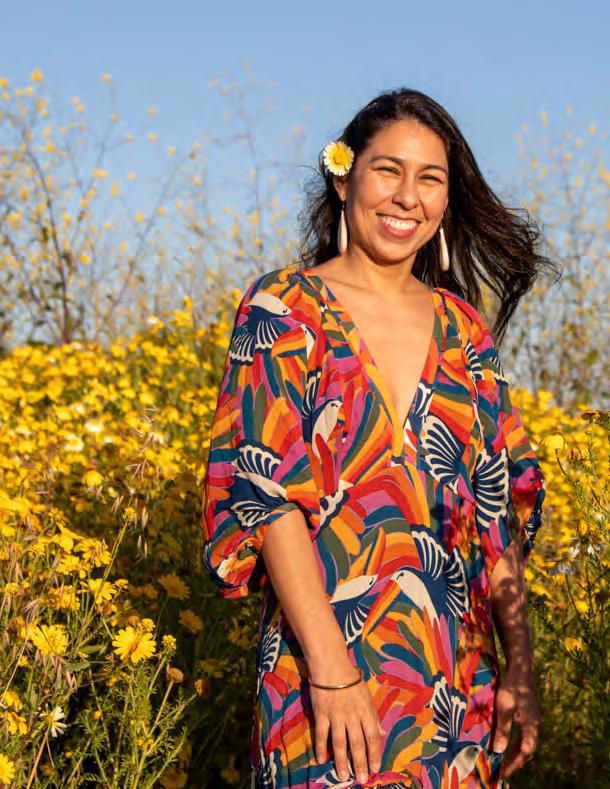
Warrior Life | 57

58 | Warrior Life
Monica Delgado sits in front of bright yellow flowers on Sunday, May 7, near White Point Beach in San Pedro. Delgado wears a colorful dress to symbolize the multiple cultures she has and embraces.
Ever since Monica Delgado was a child, people have incorrectly guessed her ethnicity.
Delgado’s Puerto Rican mother was pregnant, living in Santiago, Chile, until the socialist government was overthrown and Delgado’s mother and father fled to Texas from the military dictatorship.
Delgado was born in Texas but says she does not have Texan pride because she has no strong roots or connections to that state. She lived there for the first nine years of her life and despite not liking to mention how she was born in Texas, she does have happy memories of the international childhood friends she made while living in Texas.
When Delgado’s parents separated, she moved to New Mexico with her mom.
“Which tribe are you from?” A question Delgado often heard growing up in New Mexico, as people assumed she was Indigenous based off of her thick, dark brown hair and tan skin. Although Delgado did feel welcomed by the Native American community in New Mexico as a child, she still felt different and disconnected from her culture.
Delgado is a 45-year-old Bolivian and Puerto Rican woman who has been able to set strong roots within any community she joins and strives to create open spaces for anyone to feel welcome. She has done this by being a member of Taller Bula (an Afro-Puerto Rican Bomba group), being the owner and Professora of ArteLuta Capoeira Academy (a Capoeira school), and being the student success coordinator for the Social Justice Center at El Camino College.
Delgado credits her desire to build welcoming communities to her first time visiting Bolivia.
Compared to growing up in New Mexico where she was often misidentified as a different ethnicity, going to Bolivia at 15-years-old with her Bolivian father was when she felt fully accepted and at home. Since then, Delgado has success-
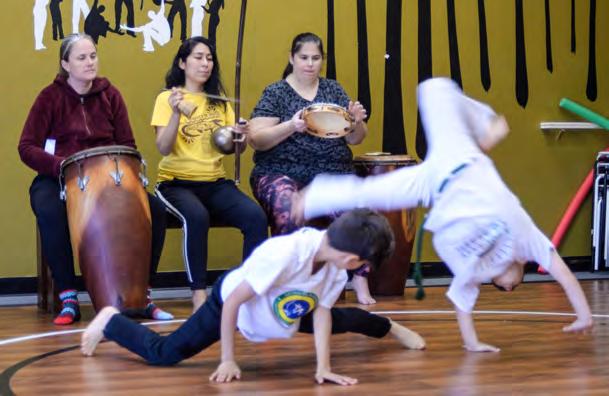
fully created different communities with the goal of having people experience the same warmth she felt in Bolivia.
A tool that has helped Delgado assess what her true goals are is the vision board. Vision boards are a handmade poster that contains the personal goals one may have for each year, which helps the person remember their ultimate goal in life and to not get distracted by different obstacles.
Playing with the red beads on her necklace, Delgado recalls the power her vision boards have had throughout her life. The boards that have her new goals for each year hang beside her bed so she can see her aspirations everyday when she wakes up. Her eyes squint as the power of her smile pushes her cheeks up.
“Opportunities may be missed if you don’t remind yourself of your goals,” Delgado says.
Delgado’s love and appreciation of vision boards has been incorporated inside the Social Justice Center at El Camino College. Across from Delgado’s desk inside the Social Justice Center hangs a poster-sized bubble map, drawn in colorful markers showing the connections the center has with different campus clubs and the future goals and plans the student workers have for the center.
Working at El Camino College as the program coordinator, Delgado was set on creating a Social Justice Center that allowed any student to voice their opinions and ideas on how to make El Camino College a more accepting and accommodating environment.
The creation of the Social Justice Center was approved during quarantine, allowing Delgado time to gather the resources and hire student workers to make the center a success before it would open on Sept. 28, 2022. The Social Justice Center is now a space where clubs can meet and hold events that are tied to the concept of bringing students with similar backgrounds together and feeling accepted.
Despite Delgado being the one who advocates for the students’ ideas and events they want to hold for the Social Justice Center, she insists the true power of the Social Justice Center comes from the student workers who brainstorm the ideas and goals they want to see happen on campus.
Warrior Life | 59
Monica Delgado plays the Berimbau as two of her students dance Capoeira at her studio, ArteLuta, on Saturday, April 15. On some occassions, the parents of the students play beside Delgado as the children dance.
“Students are at the forefront [of the Social Justice Center], I’m just here to amplify their voices,” Delgado says.
When Delgado is not the student success coordinator for the Social Justice Center, she is the Professora at ArteLuta Capoeira Academy, where she and her husband Luiz “Varal” co-own and teach in Lomita. Varal is Brazilian and has encouraged Delgado’s journey to learning Capoeira and Brazilian culture.

Being an Afro-Brazilian art form, Capoeira reflects life in a series of offensive and defensive martial art moves that are similar to an intimate dance between the two participants.
ArteLuta Capoeira Academy performs a monthly roda (the circle surrounding the dancing Capoeiristas) at every First Thursdays Art Walk event in San Pedro.
Delgado and the other Capoeira students find themselves performing at 7 p.m. on a spring night in San Pedro.
The roda grows as people walking on the sidewalk of the event take interest in the singing and martial arts performance. The sounds of the Berimbau fill the street as Delgado and the other Capoeiristas play the single-stringed instruments in harmony with each other.
Helping people communicate through dance, Capoeira can show how they interact in real life depending on what moves are used and the fre-
quency and the power of the moves. Because of how vulnerable and true a person becomes when they perform Capoeira, it can be seen as a way of enlightening a person about themselves and their true personalities, Delgado says.
Delgado says that Capoeira has the power to make people more self aware about themselves and their relationships because she has seen it happen with others in her class and it has personally happened to her.
The rasteira sweep move that made Delgado hungry for power affected her relationships between her dance partners. Match after match, Delgado used rasteira against every partner with whom she danced with. It wasn’t until her teacher pulled her aside and told her she can no longer use the sweep movement did she notice that almost every Capoeira partner she danced with was using defensive moves in avoidance of her notorious sweep.
This realization made her self reflect about why she wanted to repeatedly use the sweep when dancing and how that was affecting her relationships with her Capoeira dance partners.
Since then, Delgado’s relationships in her Capoeira classes have grown and she is recognized as a “highly regarded figure” in the Capoeira community, Grant Hartwell says.
Hartwell, a student of ArteLuta for nine years, has worked side-by-side with Delgado and ad-
Monica Delgado smiles as she looks toward the yellow flower fields in front of her in San Pedro on Sunday, May 7.
60 | Warrior Life
mires her ability to be able to be a full-time worker at El Camino College, a member of Taller Bula, run a Capoeira business and be a mother.
Hartwell looks up to Delgado as a friend and mentor.
“If we can all be like Monica, the world would be a better place,” he says.
During quarantine, Delgado wanted to get more in touch with her Puerto Rican culture – that’s when she discovered Taller Bula, an Afro-Puerto Rican dance and drumming group that primarily plays Bomba.

Joining this group has helped Delgado become more attached to her Puerto Rican culture and has become another place where Delgado has made strong connections and roots to.
Melody Gonzalez has been a part of the Taller Bula since it was founded and has known Delgado since they were both members of another Bomba group called Atabey. Gonzalez says she first thought Delgado was shy and has watched her “recognize and grow into her power.”
Gonzalez sees the progress Delgado has made throughout her life and feels very proud of her accomplishments. She says Delgado has the power to “build and heal communities” due to her “warrior spirit but gentle and calm demeanor.”
Gonzalez is not the only one to refer to Delgado as a warrior. Hector Rivera, a friend of Delgado’s and member of the Taller Bula, compares Delgado to the book, “The Sacred Path of the Warrior,” due to Delgado’s ability to embrace change through embracing Bomba and expanding her knowledge of Puerto Rican culture.
Delgado does her best to surround her 9-yearold son Caetano in his culture. Caetano overhears the Bomba music she plays in Taller Bula. Listening to his mother sing and dance in the group has made Caetano more comfortable in his culture and was once heard singing a well-known Bomba song in the shower.
“I felt so much joy hearing him sing,” Delgado says.
Knowing that Caetano has interest in his cultures makes Delgado overwhelmed with joy because she fears that as generations go on, the Bolivian, Puerto-Rican, and Brazilian cultures and traditions that run through Caetano’s veins will go with it.
Because Delgado’s parents had to leave their home country, she has been making a valiant effort to keep her culture alive in herself and in her son.
Despite not living in Puerto Rico or Bolivia, the roots of culture flow strong in the Delgado bloodline and in the sense of community she has been able to build around her.
“It’s a warm, empowering feeling– to feel like you belong somewhere,” Delgado says.
Warrior Life | 61
Monica Delgado plays the Berimbau as her students dance Capoeira at her studio, ArteLuta, on Saturday, April 15.

62 | Warrior Life
It’s been five years and I still like him
Nothing has happened between us, but maybe one day
Story by Brianna Vaca Illustration by Kae Takazawa
When I was younger I didn’t really understand what having a crush meant. That changed in the eighth grade. Who knew the boy who sat across from me in English class would be the same boy I still like five years later.
As the school year went on we talked nearly everyday. At first our conversations were small and only related to what we were doing in class. Later they were not just about homework, but also about the latest drama in our grade.
He was super attractive and had a funny personality. His dark brown hair was always perfectly styled into a long quiff, which was one of my favorite things about him. There were times where I would see him run his hands through his hair, which made my cheeks look like cherries because I was blushing so hard.
He was also the type of guy who would just randomly crack a joke and get everyone around him to laugh, me included.
Despite only telling my close friends, it seemed everyone knew about my crush. I worried he would find out.
By the time we entered high school at North High in Torrance, my crush on him grew even bigger, even though we spoke less and less. I wasn’t sure if it was because he knew I liked him or because we were getting busier as high school students.
When sophomore year came around, everyone seemed to be entering relationships which made me feel a bit lonely. I realized I should tell him that I had a crush on him.
But I didn’t tell him myself. I asked a friend to do it for me. Yes. Rookie mistake. He told him at lunch one day, near the cafeteria, in front of all of his other friends.
He didn’t feel the same way which made things awkward between us. We went from talking to
each other every day in eighth grade to awkwardly making eye contact in the high school’s hallway.
This crushed me. I felt like an idiot. There were a few times when I cried. What makes things worse was that I should have taken initiative and told him myself, but nope. I was a scared and shy 16-yearold.
It also made me think that love wasn’t real and that I will probably never find someone. My parents, who have been married for 32 years, met at the same high school as me and my crush and I thought the same thing would happen to me. We’d fall in love, get married and start a life together.
In junior year, he got a girlfriend. I was still sad about how things turned out between us and finding out about this hurt me even more and made me feel insecure. But for some reason, my crush on him was still there.
Is there something wrong with me? What did she have that I didn’t?
My friends questioned why I still liked him. They were still supportive although deep down inside I knew they were annoyed because I never stopped talking about him. There was something about him that attracted me to him, even when he had a girlfriend.
Five years later, we are both attending El Camino College and I still have feelings for him.
We see each other on campus sometimes while walking to class and the butterflies are still there when he walks by. Part of me wants to try and talk to him, but I am scared of embarrassing myself again.
I have tried liking other guys, but still find myself thinking about him.
Maybe nothing will ever happen between us. Maybe he will read this story and realize what he has lost. Maybe I’ll find the confidence to move on.
But I’m just not there yet.
Warrior Life | 63
A Photographer’s Reflection
My mom’s death was devastating for me as a kid. Now I cover the tragedies of others for the news.
Story by Raphael Richardson Illustration by Dylan Elliot
It’s just after 2 a.m. in September. A city bus has crashed into three other cars in Willowbrook, sending a work van into a crowd of people gathered at a taco stand. First responders radio in that one person is dead underneath the van and others are hurt.
Hearing this over a police scanner while I waited in a parking lot near the 110 and 105 Freeways, I start my car and head to the scene. I park, get out, set my camera up and begin taping the aftermath of what is to turn into morning’s big news story.
I am a freelance news photographer, known in the media industry as a stringer. I mainly shoot crime and tragedy, as that is what makes the most money. Doing this kind of work, you typically see things that most people both have never seen, and never want to see: death, carnage, the aftermath of violence, grieving loved ones.
Working in the news business, you must separate your emotions from your work, as you deal with a lot of the bad news. Otherwise, for some, you will just never be able to go a day without having a breakdown.
However, I noticed something. I don’t feel much of anything.
When I go home for the night, I don’t sit and think about what I just saw, reflecting off of it and changing my life for the better. The only thing I change are my clothes and then I go to bed.
How I deal with death and tragedy may have something to do with my mom. When I was 12 years old and still in middle school, my mom was diagnosed with a rare form of cancer.
She had been feeling the effects of it for years at this point and only got it diagnosed when the symptoms got worse. The doctors said it was
already at Stage IV and terminal.
She died a year later, about a week after going to the Philippines to be with her family during her final days.
When I got the call in the morning from my family in the Philippines, I was 13 years old. It was devastating – no child should ever lose a parent in this manner. For weeks, I grieved. I was pulled out of school to attend Mass for her, which in my 13-year-old brain, only made things worse. Why make me relive how I felt the day I got the call that she had passed?
Once the initial shock and grieving passed, I felt like nothing mattered. I stopped caring about my classwork and my grades plummeted. The only thing that kept me afloat during my years in middle school was the marching band, which kept some order in my life to keep going, but was not enough to fix my problems.
I never sought help for how I felt. Things were different 10 years ago, as mental health was not as much of a societal focus then, as it is today. At the time it seemed shameful to need to go talk with someone about how I was feeling.
I was not the only one who felt the same about mental health. Two surveys conducted by the Substance Abuse and Mental Health Services Administration, a U.S. government agency, show that in the past decade, there was almost a 60% jump in mental health service usage by youths age 12 through 17, with only 2.9 million seeking help in 2010, before rising up to 4.6 million in 2020.
While mental health is treated much better now, I did not think about these kinds of services at the time. A curiosity about journalism, combined with the lack of reaction to death led to me becoming
64 | Warrior Life
a crime reporter and photographer for a local newspaper while in high school.
Eventually, I grew numb to the feeling of sadness over my mom’s death and told myself that I’ve gotten over it, and moved on with my life.
However, I am not completely desensitized to tragedy. A teenager was riding in the back of a pickup truck in San Pedro. The truck suddenly sped up, throwing the boy out the back and slamming his head on the pavement. He was rushed to a trauma center, where he later died.
As I recorded the scene, a man drove up. He asked what happened and I casually stated that a kid hit his head after an accident. He then said he was the godfather and if his kid was alright.
It pained me to be the one to tell him that his boy died at the hospital.
He sped away, grief-stricken. I realized this wasn’t just some person who died in a crash. It was someone’s son, someone’s friend, someone’s teammate. My lack of reaction to death, looking back now, was my own twisted way of “mental health treatment”, by just not thinking about it. The interaction with the man broke through that way of thinking.
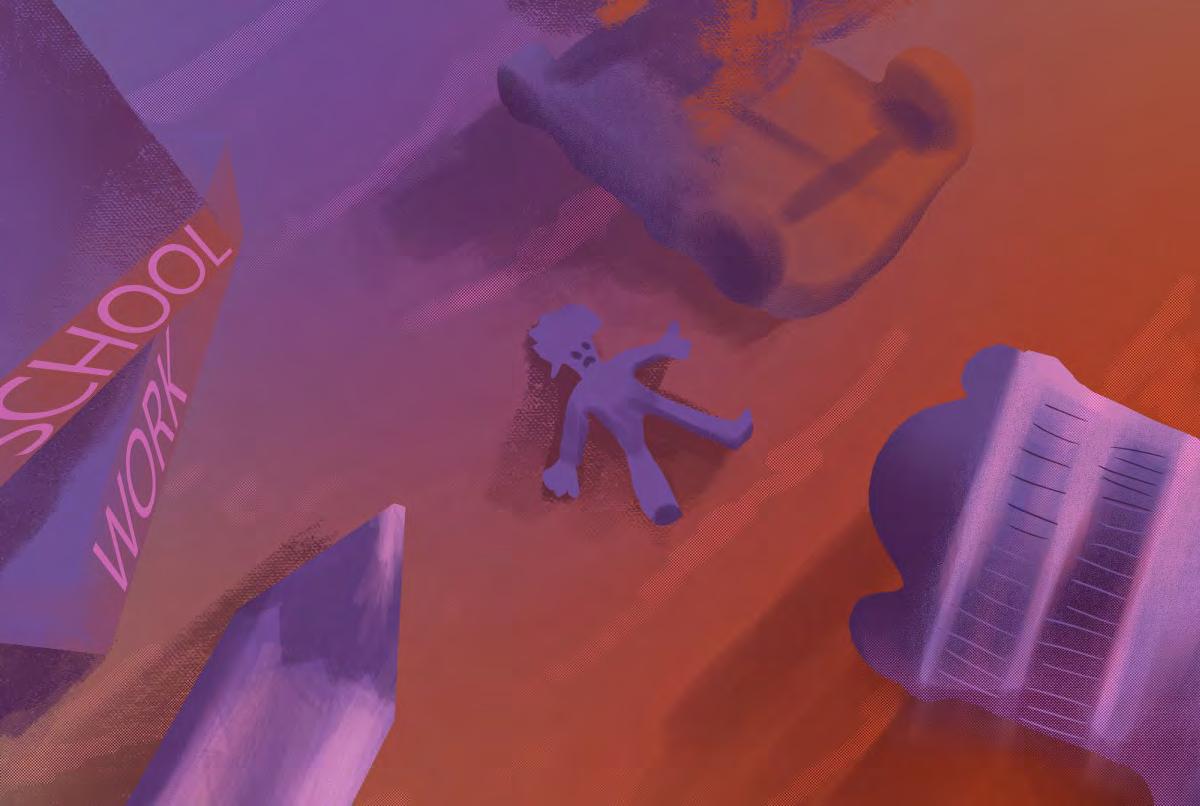
The family held a vigil for him where the accident occurred, and hung a banner with his photo onto a chain link fence. I pass by that banner every day.
Mental health is a topic that deserves to be in today’s societal spotlight. It would have done me a lot of good had I used whatever services were available at the time to help cope with her death.
While I will be forever affected by my mom’s death, I will simply use it to keep growing.
MENTAL HEALTH RESOURCES
Mental health resources are available to ECC students in need. The ECC’s Student Health Services offers free mental health support for students currently enrolled in classes.
They can be accessed in-person at the El Camino Student Health Center, open on Monday, 8 a.m. to 7 p.m.; Tuesday-Thursday, 8 a.m. to 5 p.m.; Friday, 8 a.m. to 1 p.m.
Student Health Services can also be contacted at 310-660-3643.
Students can also call ECC’s After-Hours Emotional Crisis Line, at 310-660-3377.
Anyone suffering a mental health emergency can call or text the Suicide and Crisis Lifeline at 988.
Warrior Life | 65

66 | Warrior Life
My green monster
How OCD has affected my everyday life
Story and illustration by Ash Hallas
Despite knowing the response that awaits me, I tried to break through the barriers that have surrounded me since I was a child.
“I can’t walk.”
Although the words that are uttered out of my mouth hold truth, the fact that I was diagnosed with Obsessive Compulsive Disorder (OCD) makes people doubt that any fear I have can be a reality.
The disorder creates excessive thoughts and fears (obsessions), and has the person perform certain rituals to ease those repeated thoughts (compulsions). The obsessions are notorious for making the person feel that the fears are real and dangerous, but are seen as irrational to anyone without OCD.
As usual, I see disbelief written on their faces.
“Let’s just put on some muscle relief cream.”
My 19-year-old body knew that wouldn’t fix the problem. Muscle relief cream was not going to fix the fact that I had fallen off a skateboard when riding down a hill by my grandmother’s house in Palm Springs. However, growing up being told that my OCD overexaggerated everything and my fears were not realistic made me doubt the physical pain I was feeling.
Hearing the same responses of my fears being wrong and I am “crazy” has made me doubt myself in knowing what is true or not.
I agreed to put on the white muscle relief cream.
An hour after the cream was spread on my body, still being unable to walk and crying every time an inch of my body moved, my grandma took me to the hospital.
I had broken a part of my tailbone and pelvis.
Being diagnosed with OCD by my therapist in the fifth grade came with a hefty price.
It’s hard for a child to understand that something about their brain is different from other people. Therefore, my therapist read me the book “What to Do When Your Brain Gets Stuck,”
which explained what OCD is and the coping mechanisms to combat OCD for children.
One of the chapters was to give OCD a form, a monster that lives in your head that tells you repeated thoughts and orders you around. This showed me that my OCD thoughts are not mine and helped me distinguish my personal thoughts versus what my disorder makes me think.
A little green monster, round and fuzzy, with a mean expression on its face — that’s what my OCD looks like.
The book also showed me how to lessen the powers of OCD. A favorite tool I learned was doing the opposite of whatever compulsion OCD wants me to perform.
Walking along the sidewalk on the Las Vegas Strip at 19 years old, I see roadkill on the road next to me.
“What if the germs from the roadkill got on your hands? What if the wind carried the germs to your hands? You have to wash your hands otherwise the bacteria will continue to grow and get into your fingernails and you’ll get worms and you’ll get sick,” OCD repeats into my head until it is hard to hear my own thoughts.
Feeling overwhelmed as my mind races about the possible germs that now live on my hand because of the roadkill, realization hits me that I should do the opposite of wanting to wash my hands.
I lick both my hands.
The fears go silent. OCD goes silent.
Doing the opposite of an OCD compulsion is very extreme and the idea can be very nerve racking for people with OCD. The reason why I am able to do it more easily now as an adult is because of the fact I started learning the coping mechanisms and how to challenge the debilitating fears of OCD as a child.
However, combating OCD on a normal basis is not always so simple as “doing the opposite of a compulsion.”
Warrior Life | 67
OCD
This was especially true during my junior year at San Pedro High School, when my OCD fears of being watched and murdered as I slept festered. It grew to the point where I could not close my eyes at night without quickly opening them in fear that someone or something would be standing in front of me.
5 p.m. to 8 p.m.
Those were the times I was able to fully sleep on weekdays. From 5 p.m. to 8 p.m. were my safe hours to sleep. It was after school, homework, dinner, but before everyone in my house would be asleep.
Weekends were slightly better because there was more availability to sleep throughout the day. Although there would still be sly remarks about how “lazy” and “what a teenager” I was.
My therapy schedule changed from once a week to twice a week to try to get a hold of a good technique and control this OCD “flare-up” – a term my therapist and I use when my OCD peaks, but then drops back down to normal after finding a good coping mechanism.

But this flare-up seemed to never go back down.
Months and months of little to no sleep and all nighters, constant anxiety began to creep into the day instead of just at night.
Hallucinations from the lack of sleep began to plague me wherever I went. The hallucinations only fueled my paranoia of someone watching my every move.
There, a 6-foot shadow of a man stood across the room from me. Despite the fact he had no eyes, I could tell he could see me. His legs inched closer to where I laid on the couch. Frozen in fear, I was afraid to blink. To breathe.
He disappears.
Combating these fears with my usual “do the opposite” tactic was too difficult. The failure of not being able to fight these OCD thoughts, as well as the lack of sleep, made my mental health decline fast.
Toward the middle of my second semester of my junior year, I was admitted to local hospital due to my active suicidal ideations.
Staying for four days in the mental hospital both helped and hindered my mental well being.
The nurses and staff were rude and unprofessional as they did not care if the patients would eat or not and would always choose to administer a “sleep juice” shot if a patient was getting overly emotional. To this day, I do not
know what was in the shot. But the other patients and I were very afraid of the “sleep juice” because it would knock the recipient out cold as soon as the nurse administered it.
Although there were major problems with the hospital, it was the first place I was able to sleep peacefully.
My OCD is slow and can not come up with new fears in a new environment. In the hospital, there were no fears of shadows watching me or something getting me in my sleep.
Finally being able to sleep helped me reground and reevaluate my next steps on how I can try to get a peaceful night’s sleep at home.
Since then, I am still combating my OCD flareups, but I am progressing in how I handle and view my OCD. A huge help with understanding my OCD and not feeling isolated with those thoughts has been the growing awareness around mental health and how people are being more open about their OCD experiences.
With 1.2% of adults in the United States of America being diagnosed with OCD, according to the National Institute of Mental Health, it is important for people with OCD to be represented and heard.
If you or someone you know is struggling with OCD or mental health, El Camino College students receive a free resource called Timely Care. It provides 24/7 mental health care and allows students to schedule appointments with the therapist of their choice for free.
I have a right to be heard and not shamed for my disability because it will always be a part of me. OCD can be a lot to handle, but I have hope that my coping mechanisms get stronger with practice, and the people I surround myself with give me the correct support I need to grow.
68 | Warrior Life
Grab a slice
The top 5 pizza shops to get a slice near El Camino
Story and photo by Johan Van Wier
There are lots of pizza options, both inexpensive and pricey near El Camino College. You have options like flat crust, deep dish, Detroit or New York style pies. The best type of pizza is often debated by preference by origination. No matter what style you like the best, there will always be an abundant amount of options to choose from, but here are the best five closest to El Camino.
1. Union Pizza Company
They are known for their famous deep-dish Chicago pizza, filled with tomato sauce and cheese, with a rich crust. The hard-crunchy crust compliments the tomato and super cheesy base. The Chicago pizza is cooked for 30 minutes to get the full deep-dish experience. For $12 you get the base-size pizza.
Hours: Monday-Friday: 11 a.m-9 p.m., Friday: 11 a.m.-10 p.m., Saturday: 12-10 p.m., Sunday: Closed Location: 3939 Artesia Blvd., Torrance, 90504 Instagram: @union_pizza_company
2. Pizzaroni
Their staple pizza is the Detroit-style that has vineripened fresh tomato sauce, layered on top of the doughy bottom crust layer, complimenting the crunchy edges of the crust. The best option is the four slices of their Detroit-style pepperoni pizza that includes four slices in a box for $6.99.

Hours: Sunday-Thursday: 10:30 a.m.-9:30 p.m., Friday-Saturday: 10:30 a.m-10 p.m.
Location: 3903 W. Rosecrans Ave., Hawthorne, 90250
Website: https://pizzaronipizza.com/
3. Gigi’s Pizza
The pepperoni slice is the best option. It is a thin New York-style pizza covered in pepperoni. They crafted a thin slice that evenly distributes the greasy bites that get juicier by the bite. It’s the place to go for a quick juicy slice after class. They were voted favorite pizza by Daily Breeze readers. Each slice is $3.49.
Hours: Monday-Saturday: 10 a.m.-9 p.m., Sunday: Closed
Location: 16006 Crenshaw Blvd., Crenshaw, 90249
Website: https://www.gigispizzagardena.com
Pizzaroni’s Detroit-style pizza includes four slices in a box for $6.99.
4. Pizza Machine
This shop offers great customer service along with a hand-tossed dough that comes out thick on the end of the crust, but with a doughy taste. The cheese overpowers the tomato sauce but in a good way. And the tomato sauce still holds itself under the cheese. This is the place to go if you are looking for two super hot-cheesy slices for $5.54, which includes a drink.
Hours: Sunday: 12-9 p.m., Monday: 11 a.m.-9 p.m., Tuesday: Closed, WednesdaySaturday: 11 a.m.-9 p.m.drink.
Location: 1610 W. Redondo Beach Blvd., Gardena, 90247 Website: https://www.pizzamachine1975.com/
5. Bonello’s New York Pizza
Bonello’s comes with a New York pizza vibe, that gets you two slices for $4. They cook the crust for an extensive time, and the slice is catered to taste mainly cheesy and crunchy with a pepperoni after taste.
Hours: Monday-Saturday: 11 a.m.-9 p.m., Sunday: Closed Location: 20210 Anza Ave., Torrance, 90503
Instagram and Facebook: @bonellosnypizzatorrance
Warrior Life | 69
Finding a career through dance, one Step at a time
For
Story by Brianna Vaca
Photos by Anthony Lipari
Faint classical music can be heard from the South Physical Education Building at El Camino College. A voice shouts.
“Cambre!” “Coupe!”
ECC dance Professor Daniel Berney’s voice carries outside the classroom where he’s teaching his Monday morning beginning ballet class. The names are of the movements he desires from his students while they begin class at the bar.
“Plie!” “Arabesque!” “Second Position!”
Berney wears a navy blue El Camino T-Shirt and black track pants with white accent and white pointe shoes on a daily basis to teach his class. He says he wears that specific T-shirt to represent the college after working at El Camino as an instructor and choreographer for over 21 years.
He is one of three full-time dance instructors at El Camino alongside Elizabeth “Liz” Adamis and Johnathan Bryant.
Berney says the amount of part-time dance instructors fluctuates throughout each semester.
He choreographs the fall and spring dance shows on campus and teaches beginning ballet, dance appreciation and history of dance of the 20th century.
Prior to teaching at El Camino, he worked at Santa Monica College, California State University, Dominguez Hills and Moorpark College. He still teaches a few classes at Cerritos College.
Berney was born in Scranton, Pennsylvania, but moved to Santa Monica at the age of 5 when his father got a new job as a doctor. Not too long after the family moved to South Orange County where he got his start in dancing.
Performing has always been a part of Berney’s life. During grade school he danced, sang and acted.
“One of the roles that sealed the deal for me was during elementary school,” Berney says. “I was Barnaby, the little juggler of our Lady Fatima.”
This role was the start of it all for him. Becoming a dance professor was something he never pictured though.
Berney comes from a family of doctors. His father and grandfather were both physicians and he says his father wasn’t too sure about him having a career in dance, but he still encouraged him to go to school and get a degree.
He did. During the 1980s, Berney got his bachelor’s degree in dramatic arts at the University of California, Santa Barbara
and then continued his studies at the University of California, Irvine to receive his master’s of fine arts degree in dance.
While getting his master’s of fine arts degree at UC Irvine, he was choreographing at a dance company called Ballet Pacifica in Orange County. He was also given the opportunity to teach a few dance classes.
Berney began teaching a modern dance class at CSUDH part time in August of 1987. Soon later, he was given a temporary full-time position.
During his first few years of teaching at CSUDH, the college’s dance emphasis changed from modern to ethnic. Berney made the decision to find another place to teach.
“The western styles (modern jazz, ballet, tap) were really my training,” Berney says.
This is when Berney took an offering at Moorpark College where he became the chair of the dance program.
“This was a small dance program, but they needed a fulltime person to come in and take over,” Berney says. “So I applied and got it.”
At the time, he and his wife were not living near Moorpark. His wife, who he met at UC Irvine had a job in fashion that required her to live near Los Angeles and with one child and another one on the way, it wasn’t feasible for him to be working at Moorpark.
Still needing to be near L.A. for his wife’s job, he started looking around for a new job.
When he was still an instructor at CSUDH, he said he would choreograph at El Camino and became familiar with some of the faculty. A spot had opened up for a dance instructor at ECC because one of the faculty members had died.
“They wanted to develop the program [at ECC],” Berney says. “They had an announcement I happened to look at.”
Berney’s dance emphasis is in ballet, but he says that when he teaches his students he adds contemporary styles instead of solely focusing on classical ballet.
He applied and got the position and began his job as a dance instructor in July of 2001.
After his morning ballet class on a Monday, Berney sits at his desk and looks at his calendar. A student walks in and greets him while simultaneously asking a quick question. Berney looks away from his phone and gives the student his full attention and provides the best answer he can.
Professor Daniel Berney, dance is more than just movement. It’s his passion.
70 | Warrior Life
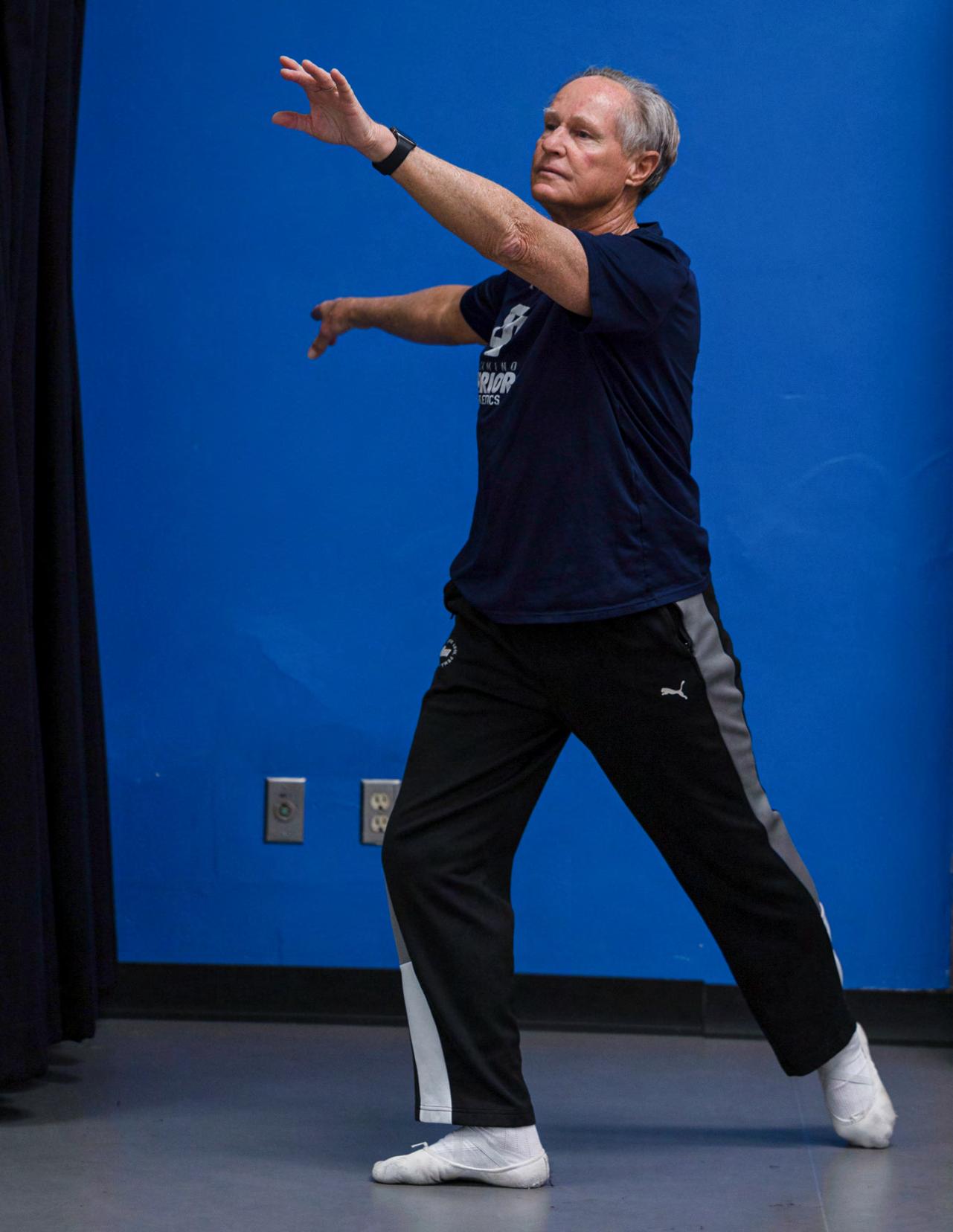
Warrior Life | 71
El Camino College dance Professor Daniel Berney does a lunge arabesque in the dance room of the South Physical Education Building at ECC on April 19.
On his desk sits two boxes of Nutri-Grain bars and as the student leaves, he quietly asks if he could have one. Berney replies with a smile. “Help yourself.”
Adamis, a colleague of Berney’s since she was hired in 2013 says that Berney has always been an encouraging and compassionate person.
“He knows what he is teaching,” Adamis says.
She says Berney always has great energy and for the students who have zero experience in dance, he helps and pushes them to their best potential.
Amy Wang, 59, says that she loves Berney’s beginning ballet class and his teachings.
“I have taken many classes,” Wang says. “Ballet, hula, modern dancing and latin dancing, but I really like our ballet class. Our teacher is the best.”
Adamis and Berney teach the same students and also run the dance shows together.
Berney also got Adamis’ daughter into surfing; which is a major hobby of his.
Adamis said when her husband died a few years ago, Berney was there for her and always checked up on her. He would also bring her food to her office.
“He treated me like we were family,” Adamis says. “He was that piece of family that I don’t have here.”
Other than dance, Berney says he enjoys sports, specifically swimming and surfing.
Berney, who declined to state his age, says, “I am an avid water person. I swim daily and give credit to my longevity. I take good care of my body because it breaks down doing what I do.”
He used to play baseball in high school and played tackle football against Marines from Camp Pendleton in San Diego County, but stuck with dance.
Berney says the dance program does get a good amount of support from administration.
Right now, his main focus is to develop the program at El Camino College.
Berney says that whether you have experience or not, a dance class helps students better understand the act of performing arts. He hopes this will help grow the classes.
“We would have to reach out to the high schools and do some recruiting to get the juniors and seniors who are interested in dance to come here for their first two years,” Berney says.
When it comes to the dance classes at El Camino there are two aspects: the lab (ballet, modern dance, jazz classes) and the lecture, which includes dance appreciation and dance history, he says.
Berney says every year the dance professors, including himself, bring eight of their El Camino dance major students to the American College Dance Association at UC Irvine, which provides opportunities for their future careers in dance.

The students also get to perform some of their own dance pieces at the convention.
Berney says the other thing he sees himself being involved in on campus is the Guided Pathways Meta-Majors.
Berney has been a team lead for the program for the last three years. There are eight programs from two different divisions which include dance, fashion, music, cosmetology and more.
This program guides students within specific majors on a path throughout their time at El Camino.
Berney expects his students to get more than just the actual practice of ballet, modern dance or jazz.
“What I hope they get out of it is that fact that you have enthusiasm and passion for what you do in life, so find that and pursue that,” Berney says. “If [students] see teachers with that kind of enthusiasm and passion for what they do, they’ll find it infectious and maybe it will help them.”
72 | Warrior Life
El Camino College dance Professor Daniel Berney poses with his students during his beginning ballet class on April 17. Other than dance, he enjoys swimming and surfing. “I am an avid water person,” he says.

Warrior Life | 73
El Camino College dance Professor Daniel Berney poses in the Physical Education South Building at ECC on April 19. Berney has been an instructor and choreographer at ECC for over 21 years.
Breaking up with a friend as an adult
Reflecting on the good and bad of a friendship destroyed by insecurity
Story by Delfino Camacho Illustration by Zamira Recinos
*All names apart from that of the author have been changed*
“You’re acting like a !$&?ing baby!”
In our almost 10 years of friendship, it’s the first time I’ve ever cursed at my friend Homer in genuine anger.
We’re speeding down the 91 Freeway, on our way to grab lunch and have a walk and talk. We were supposed to be talking about Homer’s divorce from his ex-wife Mack, who was also my friend, but he kept subtly insulting me and insulting our other friends.
You couldn’t just blame it on stress from the divorce. He’d been acting like a jerk for a long time. When I called him out he did what he always did when someone criticized him – he lashed out.
For once, I got mad.
We fought. Words were said. Through tears, he tells me to shut up and to take him back to his car.
He shuts down and he won’t even look at me. It was a common tactic of his. Whenever a friend expressed hurt or anger toward him he would deflect, ignore and attack.
“So, is this really it?” I ask.
He shoots me a look of pure hatred. In that instant, I knew our friendship was over. I didn’t cry, but I felt a lump in my throat.
Driving silently I think about our friendship, the good and bad. It all comes in flashes.
2012
“Action!” shouts Homer. It’s night and our friend Topher and I start running barefoot down the street, except we’re not Delfino and Topher. We’re two bumbling robbers on the run. We’re making a movie – Homer, me, Topher and our friend Jane.
I first met Homer in a college broadcasting class in 2011. We became friends when we realized we were both film fanatics. Through him, I met Topher and Jane. I’m still friends with Topher, but after the fight, I never saw Jane again. She was closer to Homer.
“Cut!” Homer shouts and we set up for the next scene. These are some of the most fun times of my life.
2015
It’s 3 a.m. Christmas morning. After spending the day with our families, we all met up. We always spent holiday nights together.
Homer is driving us all home. The freeway is a ghost town. Next thing I know we’re stopped at the shoulder. Homer wants to do something crazy.
We’re running across the freeway. There’s not a car in sight. Everyone’s yelling. We touch the center divider as if we’re playing a game of tag and run back to the car. Jane and I can’t stop laughing.
I wish I had tried harder to stay friends with Jane. I guess I always thought there’d be more time.
2014
It’s late and I’m tired, and I need to be up at 5 a.m. for work. We’re making another movie and Homer needs me because I’m one of the main characters. He pressures me to stay late. I didn’t have many friends growing up. I’m a people pleaser and it’s hard for me to say no. Homer knows this.
The shoot is repetitive and unpleasant. Instead of a group of misfits making a movie, this feels like someone on a power trip. He complains and orders us around, but none of us say anything. We don’t want to upset him. I’m exhausted at work the next day.
2017
Armando, a friend of Homer’s, starts getting recognition for his photography. Instead of being happy for his friend, Homer starts acting jealous, insulting him behind his back.
But it’s OK. It’s just a joke, right?
A pattern starts to form. Apart from Topher and Jane, none of Homer’s high school friends like him anymore. I took Homer at his word when he told me it was because they were either jealous or jerks.
“Not like you,” he tells me.
2013
I reconnected with my friend Veronica after high school. I’ve never been lucky in love, but I like Vicky. Still, we’re just friends. Homer encourages me; tells me it’s obvious she likes me.
“You know it. I know it. The whole damn neighborhood knows it and you’re an idiot if you don’t go for it.”
I take his advice to heart. I ask her out. She says yes. We got married in 2020.
2019
It’s his wedding day. Mack, Homer’s bride-to-be and our group’s newest friend, looks beautiful. Homer looks distracted.
Months earlier, when he first told us about getting hitched, Topher and I asked if he was sure. We loved Mack, but wasn’t it a little soon? They hadn’t been together that long.
“It’s fine,” he said, then smiled. “We can always get divorced.”
At the end of the festivities, our little group collapsed in a corner.
Homer, ever the photographer, starts taking photos of all of us. SNAP! It’s Vicky and me cuddling on the couch. SNAP! Jane is dancing, dressed in a full suit complete with suspenders. SNAP!
74 | Warrior Life
Topher sticks his tongue out for the camera.
Although it probably wasn’t, in my head I remember this as the last time we were all really happy, all together.
2020
After months of only hanging out via Zoom due to the pandemic, we finally feel comfortable to start hanging out again. This time it’s just Homer, Topher and me. The vibe is off. The entire time Homer and Topher seem tense. After a couple hours we part ways. Topher calls me as I’m driving home.
“Did things seem weird?” he asks.
He goes on to tell me Homer and he had an argument right before I got there. I knew things felt off.
“What was the argument about?” I ask.
“Oh, you know Homer,” replies Topher.
I get what he means. Homer was always what we lovingly referred to as grumpy, prickly even, but it was a part of his charm and he was always “just kidding.” Topher tells me he got fed up with the underhanded insults and pushed back. Homer got mad. Then I got there.
“You think I should have just bit my tongue?” asks Topher.
“Nah, we’re all friends. We should be able to talk to each other,” I say to reassure him. “It’ll blow over.”
It was another running joke of ours. If our friend group was a boy band, Topher was the funny one, Jane was the loud one, I was the nice one and Homer was the mean one.
We always meant “mean” in a fun way, but maybe that was because we were too close to him or maybe because in the beginning, his barbs were always aimed at outsiders, never us.
After they separated, but before they divorced, Mack went on to tell me that near the end of our friendship Homer grew to resent and badmouth me.
“He was in competition with you,” Mack said.
I guess he forgot to tell me.
People are complicated. Friendships even more so.
With the benefit of hindsight it is obvious to see what happened, at least from my point of view. All of us changed and settled into the people we were going to be. In my opinion, Homer became someone who enjoyed being cruel and who lacked accountability.
Maybe he changed. Maybe it was me.
A lot of people, including him, think I stopped being friends with him because of Mack. I can almost hear him telling a story about how we abandoned him and sided with his ex.
But the divorce was never the real cause. It was him.
Homer was charming, in rare moments insightful and funny as hell. There are times I really miss him, every holiday and after watching a new good movie, but he was also mean and insecure.
I’ve accepted we are no longer friends, but I will never regret the friendship we had.
As Homer and I reach his car I try to say something, but he’s out of my car in a flash. I yell at him to talk to me, as he fishes for his keys in his pocket.
When he finally opens his door he grabs a pile from the passenger seat. It’s a collection of books, movies and records of mine that I had let him borrow. He had brought them to return to me.

“Is this really it?” I ask.
He drops my stuff on the curb, slams his door and drives away.
Warrior Life | 75
Unveiling student, faculty and staff expression
THROUGH FASHION THROUGH FASHION
Story
Students and faculty silently communicate through their carefully selected, sometimes peculiar styles. Warrior Life surveyed El Camino College students and faculty about their favorite articles of apparel and here are five responses about their most beloved items.
Emily San Vicente , film major, 21 Instagram: @izthatemily
“I really gravitate towards [jackets] because it can make a big statement piece,” San Vicente says. “It is a piece of clothing that can be mixed and matched with other pieces of clothing and will still stand out.”
In her time exploring her personal style, she finds it easy to pair jackets with just about everything. She sports many variations of an outfit with jackets as a staple because it empowers her.
“When I wear a leather jacket I always feel a boost of confidence,” San Vicente says. “It makes me feel as if I am in charge.”

“What I like to express through fashion is that I am put together but without having to be super sophisticated,” San Vicente says. “You could still look good by wearing streetwear fashion.”
Piper Takenaka, neuroscience major, 20, Instagram: @piper.takenaka
“[A gray hoodie] was something that a friend of mine thrifted and is something we share to keep us connected,” Takenaka says. “It makes me feel happy and at home because of how big and comfy it is.”
The hoodie was found in 2021 a thrift store called Shimokitazawa in Tokyo, Japan, and travels often because it’s a shared piece. It is passed along from Takenaka to her friend, and to her friend’s siblings. She and her friend take extreme care of the hoodie so whether it’s shipped from or to Japan it looks its best.
While at ECC, she spends the duration of her time studying which gives her ample time to wear hoodies.
“I enjoy buying hoodies with interesting patterns so that I can
look more put together than I am feeling,” Takenaka says.
A chic and simple item catches Takenaka’s eye–a cardigan set.

“My personal favorite is the M-Idori top” from futuristic, feminine, and edgy Italian retail clothing company Diesel, Takenaka says. “It seems basic, but it’s elevated with layering and silver zipper detailing.”
Her personal fashion taste changes depending on her mood. It’s one style one day, another style the next.
It fluctuates from super girly, dressing in bows and lace to feeling “edgy and choosing my cargo pants and combat boots,” Takenaka says.
Jenny Hoang, art major, 19 Instagram: @hennyjams
“I take clothes from my dad pretty often because he keeps everything for decades so his clothes are durable and worn in,”
Takenaka wears a knitted sweater from Yesstyle that’s improvised into a cardigan with a lacy camisole top. Raphael Richardson | Warrior Life San Vicente’s leather jacket
76 | Warrior Life
by Hannah Bui | Photos by Raphael Richardson and Hannah Bui
Hoang says.
When Hoang puts on an old pair of oversized Levi blue jeans, one of her dad’s hand-me-downs, it was the perfect fit for her.
“I actually stole them from my dad because I’m almost his height, so his clothes fit just a little baggy on me,” Hoang says. Various factors have influenced her style choices.
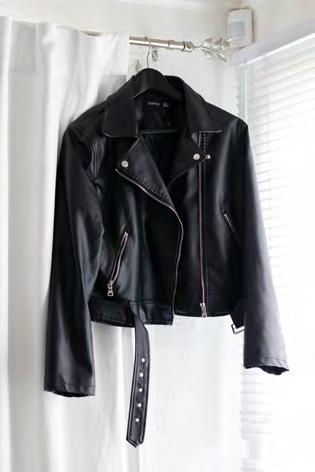
“I wear a lot of basics and I choose my clothes very intentionally to fit my body type and work throughout different seasons,” Hoang says.
Currently, Hoang’s favorite item is a white lace crop top from Garage because it has a flattering cut and is versatile.
“I can dress it up or down with different items and accessories,” she says. “Wearing it makes me feel confident and beautiful.”
Maintaining a wardrobe with minimal pieces is always her goal.
“I have a relatively small wardrobe, it’s important to me that all my pieces can be used for a long time in a variety of ways,” Hoang says.
Patrick Schulz, Music Theory Professor, 48
One of Schulz’s favorite pieces is a Columbia windbreaker.
The jacket isn’t “overly warm but it does keep the wind off of you” which makes it useful in the South Bay, Schulz says.
The Columbia brand is known for its many community outreach programs set in Portland, Oregon, including The National Park Foundation’s Open OutDoors for Kids program where they connect the youth to nature.
“It seems like they have a strong program to give back to the community, in the form of volunteering,” Schulz says. “They pay their employees a regular wage to do that.”
Wearing the windbreaker “makes me feel a little more connected to nature,” Schulz says. “It makes me think about being outside.”
A friend invited him to Portland to see the city for the first time in 2015 and they decided to go hiking.
“I was cold and wet, and miserable, and [my friend] gave me a [Columbia] jacket,” Schulz says.
His friend told him he should get one next time he returns. Two years later, in 2017, he bought his first Columbia product, a windbreaker before another planned trip with his friend.
Even now, about six years later, he continues to own the jacket, which is now accompanied by a second one and an array of Columbia clothing, including T-shirts, collared shirts, and shorts.
Catherine Bueno, Part-time Faculty Librarian, 42
Bueno would describe her style as quick and classic, and associates that with her nerves to try new things and her reserved nature. An upside to this style is how it helps her be professional as a Librarian at El Camino. “There’s a fine line between being professional and a business professional” where she
looks approachable to students and able to relate to them, Bueno says.
Heels and boots caused her foot pain during high school and pregnancy. This led her to a brand called Vionic, a brand for stylish orthopedic shoes where she acquired two pairs — one high-heeled pair of suede boots adorned with a buckle, and the other — black sneakers.
The Vionic boots she now owns with arch support give her freedom to roam around the library to each student with renewed prowess.
Amid societal pressure to suppress her culture and appearance as someone of Native and Hispanic descent and a tanner complexion for most of her life, a family member served as a positive role model.
“My aunt had really tan and long legs and she always wore really short shorts,” Bueno says. “Now, I’m proud of showing people how tan I get and wear short shorts” in the summer.
Another piece reminds Bueno to stay connected with her family. The piece is sterling silver earrings that hold three crystals.


“I have three kids so whenever I try and find jewelry it always has to be something with three jewels or three gems,” Bueno says.

Bottoms Tops Accessories 0 FAVORITE APPAREL 12 ECC STUDENTS AND EMPLOYEES 5 4 3 2 1
Bueno’s sterling silver earrings
Warrior Life | 77
San Vicente appreciates her Boohoo leather jacket for its versatility. Hannah Bui | Warrior Life
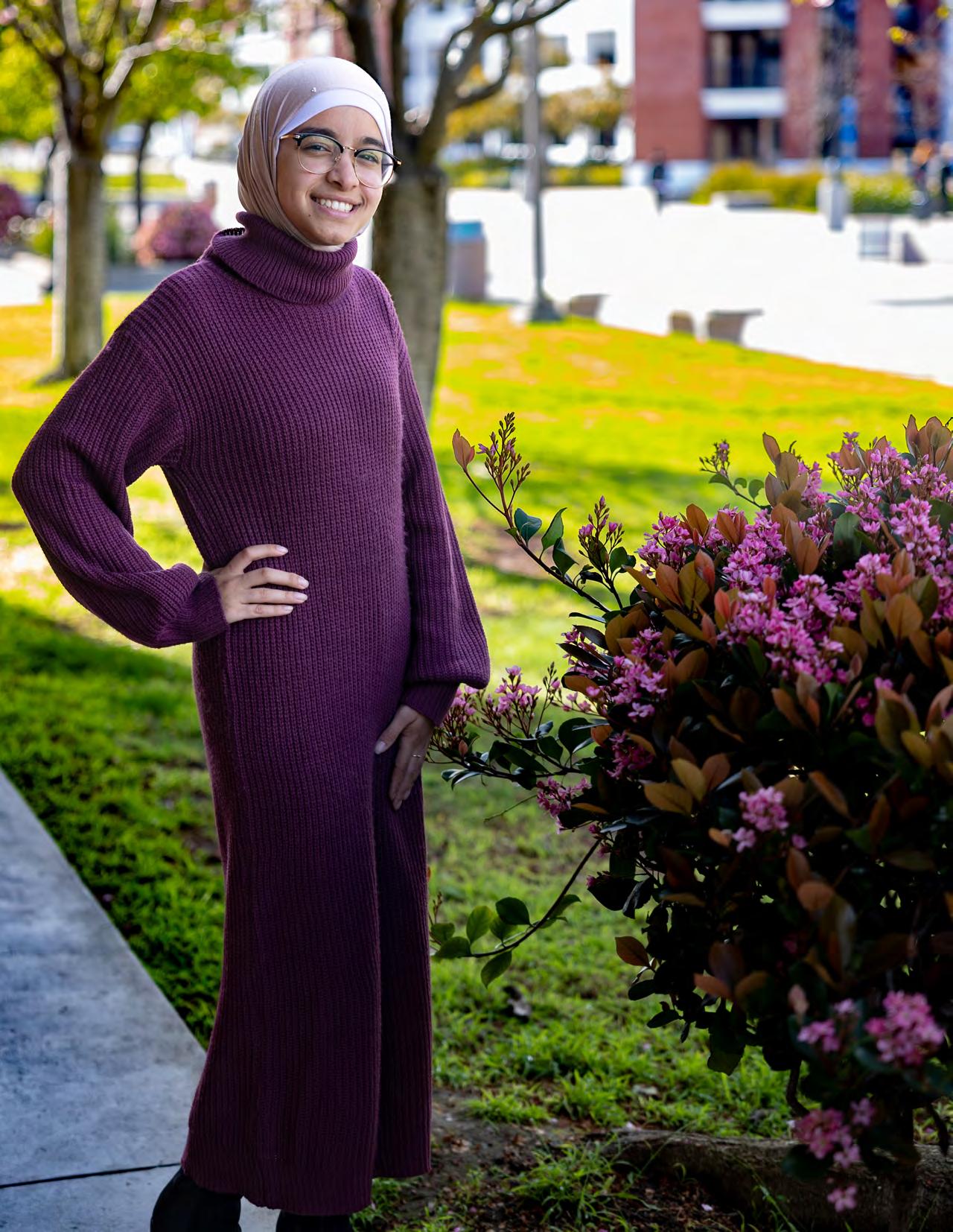
78 | Warrior Life
El Camino College Associated Students Organization President Jana Abulaban came to the U.S. from Jordan with her family in July 2016. She is getting ready to transfer to UCLA for the fall of 2023.
To The South Bay From Jordan
Student government president advocates for immigrant and refugee rights
Sun heats the desert and a mirage of an oasis of blue water dances on the horizon. A grandmother has been walking for 10 days – from Palestine to Jordan – with her six children to flee the Palestinian-Israeli war. It’s 1968.
However, her sacrifice to leave her homeland was not like the mirage she saw in the desert. She found true refuge and paved the way for her family to come to America and have a better life.
Today, 55 years later, that grandmother’s granddaughter, born in Jordan, identifies as a Palestinian woman. As the president of the Associated Students Organization at El Camino College (ASO), 18-year-old Jana Abulaban is now advocating for people like her grandmother who was once a refugee after being displaced by war and genocide.
In July 2016, at the age of 12, Abulaban first arrived in America after her grandfather who was granted U.S. citizenship sponsored Abulaban’s parents and their five children to travel from Jordan.
At first, she was not even sure her family would stay in America. But soon after they arrived, they were granted permanent residence – known as green cards.
Abulaban’s own experience as a refugee started in Jordan. Despite being born in Jordan, she was not granted citizenship. As a result, she was denied access to a good education and had slim chances of upward mobility.
Today, Abulaban, who is majoring in communications and psychology, is one step closer to earning an associate degree to transfer.
Moreover, she ran for Associated Students Organization president in the spring of 2022 and
won. Abulaban emerged as a leader of 35 student government members at El Camino College.
A year later, she’s getting ready to transfer to UCLA. She has traveled from Washington, D.C., to Japan as part of the forensics team.
As president, Abulaban helped to make student-led initiatives come to fruition.
“I was part of the menstrual products machines initiative,” Abulaban says. “Thankfully, we were able to achieve it by the end of the fall (2022) semester.”
On Fridays, Abulaban leads the student goverment’s meeting. Wearing a long flowery dress and a light pink hijab, she enters a meeting room where members gather. Standing and speaking in a soft voice, everyone turns their attention to her.
She can see how much student government can create a change on campus. She believes there are more things the college could offer to students.
“I want to be part of this group that’s able to create that change,” Abulaban says. “I’ve always been big on advocacy.”
Interim Director of the Student Development Office Ricky Gonzalez, who advises El Camino’s student goverment, said ASO is an organization “by students, for students and run by students.”
“Jana is by far one of the most integral servicebased, equity-minded and innovative leaders that I have seen in this institution for a long time,” Gonzalez says.
This year, Abulaban is working on a project advocating stipends for the Associated Students Organization and Inter-Club Council members. She said all the advocacy work the members have
Warrior Life | 79
Story by Nindiya Maheswari Photos by Khoury Williams
done needs to be compensated.
Being curious, she wanted to find out how El Camino can offer more benefits and better training to its student government members.
As Abulaban looked into the best practices that can be implemented at El Camino College, she talked to student government members from nearby community colleges and found out some are paid for their work.
Former El Camino College Director of the Student Development Office Greg Toya worked with Abulaban prior to taking a new position at Santa Ana College.
“Jana is an outstanding leader,” Toya says. “She’s very grounded and reliable and consistent.”
Abulaban enjoys her time at El Camino College and wants to ensure students have a better experience at the college.
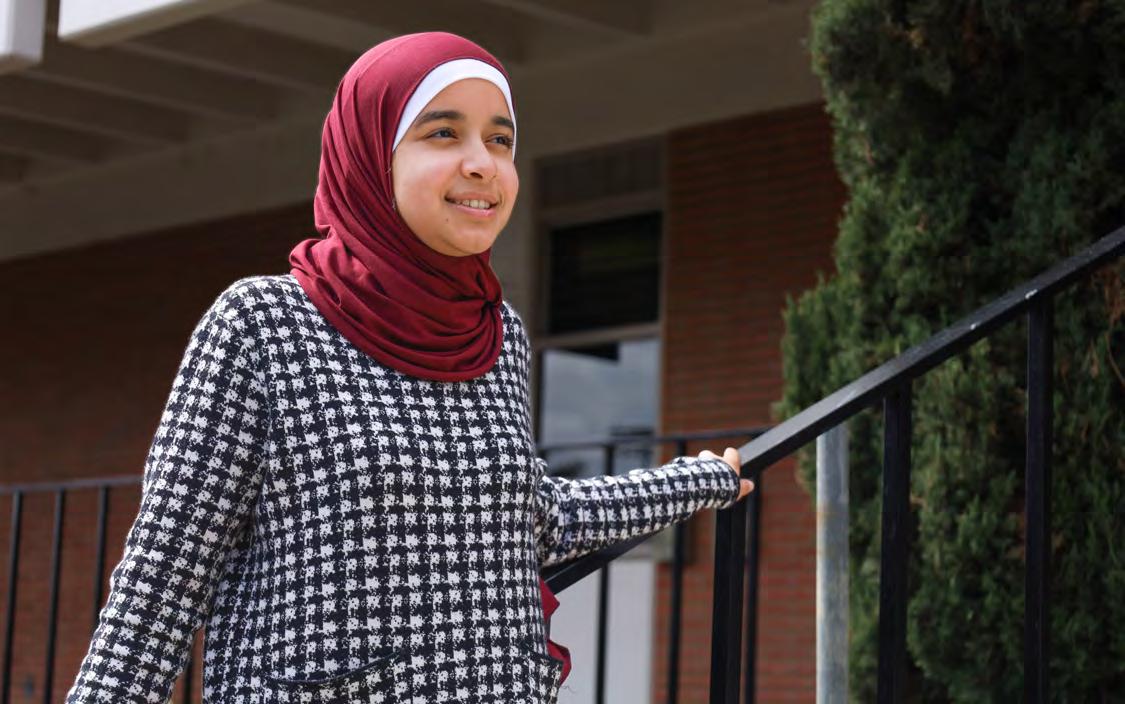
“I want them to live like that true college experience without having to try to remove as many barriers from them as possible and want to ensure that their voices are heard,” Abulaban says.
She also wants students’ basic needs to be met. She believes to be able to succeed at school, students need food, transportation and a place to sleep.
“Whatever goal you have, whether that’s graduating or getting a certificate, degree,
transferring, anything like that, I want to make sure that you have all the support you need,” Abulaban says.
In March 2023, Abulaban and 10 student government members from El Camino College attended the American Student Association of
Community Colleges (ASACC) in Washington, D.C., and visited Senators Diane Feinstein and Alex Padilla’s offices, both Democrats from California.
During the trip to the Capitol, Abulaban and ASO Public Relations Director Sabrina Rashiq introduced a higher education bill for refugee students to pay tuition fees as residents rather than international students to Padilla’s staff members.
“There are certain crazy requirements that you
“I want to be part of this group that’s able to create that change.”
- ASO President Jana Abulaban
80 | Warrior Life
ASO President Jana Abulaban leads 35 student government members at El Camino College. Abulaban is also a member of the forensics team that participates in national and international speech and debate competitions representing ECC.
ASO President Jana Abulaban advocates for students’ basic needs to be met while attending El Camino College. She believes to be able to succeed at school, students need food, transportation and a place to sleep.
need to have at least $20,000 in your bank account before applying and that you need to maintain that for a certain amount of time,” Abulaban says.
Abulaban and Rashiq suggested a new immigration processing category for refugee students looking to come to the U.S. to complete their higher education. She says it can look like the existing priority refugees category that require sponsorships from families or organizations to come to the U.S. rather than showing $20,000 in their bank account, which is almost impossible for a refugee.
Back from Washington, D.C., Abulaban and Rashiq continue drafting legislation with representatives who said they would be happy to co-sponsor.
Wearing a different hat, Abulaban is also a member of the forensics team that participates in national and international speech and debate competitions representing El Camino College. However, her advocacy for refugees and new immigrants also reflects in her speech and debate performances.
Captain of the forensics team at El Camino College Uzair Pasta has known Abulaban since they were on the same debate team at West Torrance High School in 2018.
Pasta also works with Abulaban in the Associated Students Organization and Muslim
Student Association Club. Pasta says Abulaban is a true inspiration.
“She came from Jordan, she is from Palestinian background,” Pasta says. “Yet she is able to not only succeed at El Camino, but also thrive.”
On a late Wednesday afternoon, Abulaban gathered with Pasta and around 30 Muslim students inside the Social Justice Center. She grabbed some vegetables, rice and a donut for dessert from a potluck table and sat down. The room was filled with joy and laughter.
Around 5 p.m., right in the middle of enjoying her meal, she paused to check her phone. That was the day that UCLA sent out a letter of acceptance to prospective students.
A few seconds after reading her email inbox, she smiled calmly and said “alhamdulillah,” which means “praise be to God.” She got accepted to UCLA to major in psychology this fall.
Abulaban says her career aspiration is to be a lawyer and go to a law school to learn immigration or international law because of her experience living as a refugee in Jordan.

“I realized that just because of your status, you’re treated differently, just because you’re from a specific place,” Abulaban says.
She says she will continue to advocate for people’s rights and make sure that “everybody has the rights that they deserve.”
Warrior Life | 81
How I messed up my mom’s memorial
The conversations, skills and wisdom I miss now that she’s gone
Story, photo and illustration by Kim McGill

My mom died 11 years ago. I miss her all day, every day.
When she died, I had only one important job at the memorial her friends organized. I needed to speak about what my mom meant to me and so many others. I had written down what I wanted to say. But, someone unexpected showed up, and in my anger and confusion, I said things to expose the hurt they caused my mom.
I spoke of infidelity and cruelty, of betrayal and loss. I never mentioned names, so I left people confused about who did what to who.
I sounded crazy.
Since then, not a single day has gone by when I haven’t regretted what I said at my mom’s memorial and so much more about my relationship with her.
I let her down, and also let down the friends who loved her so much.
This is what I wish I had said to the people who gathered to honor her.
My mom never said how to be a good person. We didn’t have many long conversations.
She grew up in North Dakota. I grew up in California. She was country. I am city.
As a little girl, she wore dresses and a bow in her hair and was always shiny and clean. I wore Sears husky jeans and T-shirts and was always sticky and muddy. She worked as a teenager picking strawberries in Minnesota. I worked as a teenager doing urine testing for the L.A. County Probation Department. I saw her as “old fashioned.” She saw me as rebellious.
82 | Warrior Life
She was uncomfortable discussing the topics most people crave talking about – sex and politics, and conflict and pain. She avoided being embarrassed.
But in her actions, she showed how to be a good person. Here are her lessons:
1. Be a good friend.
A few days after my mom’s death, I opened a fortune cookie and the paper inside said, “To have friends, first be one.” It felt like the perfect summary of my mom’s life.
She remembered every important day, sent birthday cards, called to check in and asked about children and grandchildren by name.
She organized weekly card games. She shopped for groceries and did laundry for friends who were sick.
She cooked beautiful, feel-good food to spoil her friends like pot roast with carrots and baby potatoes or chicken and dumplings on cold and rainy days. Her friends sat down at the table with fresh cut flowers and their name written carefully on a card at the top of their plate.
My mom made her friends feel cherished and important. And they did the same for her.
2. Share what you have.
My mom believed that your home – no matter how crowded or tiny, on the street, in a car or under a roof, with plenty of food or hardly nothing at all – can always shelter and feed one more person.
She took people in who lost a job or their place to stay. She organized neighbors to take daily meals to families who were too devastated by death or loss to cook. People went to her for ideas and advice.
When children were cutting their knees and splitting their heads open on a dirt baseball field covered in rocks, she organized moms and kids to clear the field by hand.
She looked out for people.
3. Work hard.
My mom was always the one who was consistent and reliable. She kept the lights on and food in the fridge. She came home from long days at work and cooked and cleaned and did laundry until late at night.
When my dad left, she worked two and sometimes three jobs. No job was too hard. She answered phones for a sheetrock contractor. She worked at a hardware store. She set type for a printer. She sold concessions at Dodger Stadium, standing for eight hours on hard concrete.
She passed the value of hard work on to me.
She never forced me to work, she just linked it to goals that I cared about. She made me work to earn a toy or a dollar. I sold more raffle tickets every year than anyone else in community baseball because I wanted the prize. My mom wouldn’t help me sell.
She helped me start babysitting at age 9 and encouraged me
to wash dishes or help clean whenever I was at other people’s homes.
She never complained when I left before dawn and returned home late at night to cover school, sports and after-school and summer jobs. As a teenager, I worked in a cannery skimming scum off the top of huge vats of jam in 115-degree heat. I planted pumpkins in the blazing summer sun and sold Christmas trees in weather so cold that my fingers – raw from sap and pierced by pine needles – bled.
Many would say that she allowed me to work too many hours. But I learned humility and how to push through.
4. There isn’t anything anyone needs that can’t be made.
My mom stayed up all night creating rag dolls with detailed, multi-colored clothes and embroidered faces for her friends’ children.
I begged for Twinkies and store-bought Halloween costumes. But my mom always sent me to school with fresh baked cookies. While others were superheroes and witches and serial killers, I was an itchy burlap scarecrow with straw sticking out from my sleeves and ankles and a stuffed crow perched on my shoulder. For a school play, she created cloth masks that covered our whole heads, each kid a different character from Winnie-the-Pooh.
When my All-Star softball team had no money for uniforms, my mom and other women made us shirts and sewed sequins onto our caps that glittered in the sun. We were both laughed at and slaughtered by a team from Downey where they had full uniforms, cleats, paid umpires and professional fields with lights and electronic scoreboards.
I wish I had studied all the talents my mom had, arts passed down from generation to generation until they ended with me.
5. Leave a better world for the next generation.
My mom was from a time, a place and in relationships where women were silenced, bullied and coerced, told how to think, even told how to vote.
But in unfriendly, male dominated work environments, she carved out safe places for women. She helped them to move up at work and out to better possibilities. She encouraged them to start businesses and take risks. She warned them about sexual harassment, and advocated for them when they were mistreated. I know this, because I saw some of it, and because the women she worked with told me.
She was part of that bridge generation that made the lives of women and girls so much better. She never marched for women’s rights or drew a protest sign.
But she was part of the revolution that demanded an end to doing twice as much work for half the salary, an end to hands up your skirt and down your shirt, an end to working a full day and coming home exhausted to put in a second shift cooking, cleaning and caring for children with no help from your male partner.
She didn’t win those rights for herself. But she and thousands of other women planted seeds of resistance in their children.
Warrior Life | 83
My mom also told me to “fight my own battles.” Even when I was in a conflict or I felt a teacher was unfair, she almost never stepped in to defend me. This taught me how to stand up against injustice.
6. Let your children go.
Parents often want to protect their children, and hold them close forever. My mom was no different. But she showed that a parent’s job is to let children go, pick them up when they fall and then let them go again; to take them to the edge of a cliff and push them to fly.
I am sure that I scared my mom a lot.
As a little kid, I ran around the neighborhood until the street lights came on. I concocted elaborate runaway plans, packed my wagon with food and supplies, and took off with my dog until long after dark when cold and hunger called me home.
I broke my collarbone playing soccer in pouring rain, broke an eye vessel playing catcher when I got hit with a baseball bat to the face, got kicked by steel cleats that split a muscle sheath in my leg causing a hernia I still have, an injury the doctor said he’d never seen.
I broke my cousin’s nose in a boxing match and got blood all over the room.
By middle school, I traveled everywhere alone on the bus when the L.A. MTA was known as the Rapid Transit District (RTD) or what we all called “Rough, Tough and Dirty.”
I drove 3,000 miles across the country by myself three times to move to and then come back from the east coast.
My mom sometimes looked worried or angry.
She suggested that I stay closer to home or pay more attention to safety.
It would have been natural for her to be over-protective, especially since she had a son who died before I was born as well as several miscarriages.
But she never pushed me to change.
After she died, one of her friends said that my mom had “crap luck.”
In many ways, her life was hard.
She was badly burned as a child and lost months of her childhood. She moved many states away from her family for better opportunities.
Maybe because of so many miscarriages and the death of a son, because of their own tough childhoods, or for other reasons I never knew, the relationship she had with my father was lacking in love or affection. He was controlling and critical, and I saw her confidence melt. I had a hard relationship with him too and I think that added to her stress. Silent tension that soaked the atmosphere gave way to eruptions and days when people disappeared. When he left, I was glad, but my mom was devastated.
At times, I think she felt crushed by life.
She drank too much to escape sadness, and that made her sadder. Over time, she regretted ambitions never reached and dreams abandoned. In the end, my mom endured a vicious five-year fight with cancer that took her one piece at a time – a piece of colon, a piece of liver. When it spread to her lungs and brain, it took her thoughts and speech.
But, I think she had a beautiful life, especially because of the love she got from and gave to her friends.
I wish I had known how much I would miss her. I should have held on tighter, and filled in the quiet spaces with questions. I should have learned more, urged her to pass on all her precious skills. I should have forgiven more and shown more patience. Thinking back to that day at her memorial, all of this is what I wish I had said. Had I appreciated her more, I would be more like her. And that would be better for everyone.

84 | Warrior Life
Top 5 pupusas in the South Bay
One of the best foods from Central America is “las pupusas,” which are thick tortillas stuffed with a base of cheese and refried beans. In the past, people believed pupusas were a mix of culinary traditions of the Mesoamerican natives and the Spanish colonizers. However, it’s a delicacy that has its origins in the Mayan culture, according to recent studies.
There’s a dispute between Honduras and El Salvador over who is the real creator of this delicious treat. The truth is that “las pupusas” are made with passion and a fusion of corn meal, cooking oil, secret spices and your choice of fillings, such as chicharrones, frijoles, cheese, shredded chicken, loroco – a fragrant plant with edible flowers known as the flower of the Maya – and many more. Enjoy one or two. “¡Buen Provecho!”
1. Restaurante Las Brisas
Las Brisas Restaurant in Gardena is a little place that offers the most complete range of Salvadorean-style pupusas, from one ingredient to the three-ingredient specials, such as frijoles, chicharrones and cheese. There is even a zucchini option. Single ingredient pupusas are $3 each and $3.50 for the special ones.
Address: 14302 Van Ness Ave., Gardena, 90249
Phone: 310-324-1474
Hours: Open daily: 9 a.m. to 8 p.m.
2. Restaurante Channy
Channy’s Restaurant in Hawthorne is a nice, small restaurant with great customer service and good prices. It is famous among the locals for their Guatemalan-style pupusa combinations, such as cheese and beans or cheese and chicharrones. Also, you can have a refreshing glass of fruit juice and a fresh Guatemalan pastry for dessert. Pupusas here are $3.25 each.
Address: 12631 Hawthorne Blvd., Hawthorne, 90250
Phone: 424-675-4526
Hours: Open daily: 7 a.m. to 7 p.m.
Website: https://www.channyrestaurant.com/home
3. Arcense Restaurant & Pupuseria
Arcense Restaurant in Lawndale is a quaint restaurant that has the best Salvadorean-style loroco and cheese pupusas in the area. Vegetarians can also ask for the cheese pupusa. For vegans, they have a loroco specialty. Pupusas are served with cole slaw, seasoned vinegar and fresh tomato sauce. Pupusas are $4 each.
Address: 15122 Inglewood Ave., Lawndale, 90260
Phone: 310-219-0800
Hours: Monday: 9 a.m. to 4 p.m.
Tuesday: Closed
Wednesday-Saturday: 9 a.m. to 4 p.m.
Sunday: 9 a.m. to 3 p.m.
Traditionally, pupusas are accompanied with cole slaw that you can put on top or just keep on the side. There is also a mild sauce made with fresh tomatoes, or habanero peppers for those who like it spicy at Las Brisas in Gardena.

4. Northgate Gonzalez Market Deli
Along with the freshly-baked bolillo rolls and freshly-made tortillas, the cheese pupusas from the deli inside Northgate in Hawthorne are well-known for their great flavor. It’s the best of its kind, according to some of the regulars. They don’t offer a dine-in area and all the food is to go. Pupusas are $2.69 each. Call for deli service hours.
Address: 3930 W. Rosecrans Ave., Hawthorne, 90250
Phone: 310-973-1079
Hours: Open daily: 7 a.m. to 10 p.m.
Website: https://www.northgatemarket.com/
5. Superior Grocers Deli
At the deli inside Superior Grocers in Hawthorne, you can enjoy the best beans and chicharron pupusas with the great flavor of a juicy cabagge salad, with a touch - if you want - of habanero or chipotle salsa. For the vegan customers, they offer refried bean pupusas. The deli has a wide variety of other traditional Latin American foods and drinks. There are tables for dining in. Pupusas are $2.99 each. Call for deli service hours.
Address: 12630 Hawthorne Blvd., Hawthorne, 90250
Phone: 424-348-2083
Hours: Open daily: 7 a.m. to 10 p.m.
Website: https://superiorgrocers.com/location/hawthorne/
Story and photo by Alexis Ramon Ponce
Warrior Life | 85
Need a new Central American food in your diet? Here’s where to try one of “las mejores”
Class dismissed
After 30 years in education, Humanities Dean
Debra Breckheimer will retire from El Camino
Story by Ma. Gisela Ordenes
Photos by Khoury Williams
There’s a magnet in Debra Breckheimer’s office perched prominently on the filing cabinet above her desk. It says “Believe.”
“Believe in yourself,” she says. “You gotta believe in yourself first. When I stepped behind this desk, I thought, ‘What the heck am I doing? ... And I’m just gonna believe that I’m gonna make it.’”
By “desk” she means her desk as the Dean of Humanities at El Camino College, her job since July 2018 andwill retire at the end of the semester.
Clad in a white-and-blue plaid blazer over a black shirt and black pants, the 63-year-old thinks before she speaks. She contemplates the questions but when she opens her mouth, her sentences come in rapid succession. The straightforward, authoritative manner with which she speaks contradicts the image of someone who had to wrestle with self-doubts.
But self-belief was not something Breckheimer had a lot of growing up in Westchester, California in the 1960s. It was something she had to struggle with when she started college at 28. “I didn’t think I was college material at all, just like so many students today.”
She’s come a long way since then, but the journey was anything but easy.
Raised by a single mother, Breckheimer grew up with four brothers.
“I’m second to the oldest so I was kinda like mom,” she says.
Her parents divorced when she was 10. Her father had a massive stroke shortly after and couldn’t work. Her mother supported all five children by running a daycare center in their home, babysitting kids. When she found work downtown as a bank teller, her mother would take the bus every day, leaving the house at 5 a.m.
“We’d know she was coming home because we could hear the sound of the grocery cart –chak-ke-chak-chak-ke-chak – on the pavement,” Breckheimer says.
Breckheimer and her brothers had to work at an early age. She worked almost 40 hours a week and
had to forego college after high school.
“I didn’t go to college. I had to work,” Breckheimer says. “We couldn’t afford for me to go to college, and we needed some help with my income.”
Her thinking changed when she met her future husband at 23. Patrick Breckheimer was a teacher in South Los Angeles when they met. He grew up in a family of educators. Breckheimer describes him as someone who “had a great joy of teaching.” He eventually became an administrator, but grew up knowing he wanted to be a teacher.
When they got married, her husband gave her the courage to go to El Camino. It was 1987 and Debra was 28.
“I was very scared of school,” she says. “I lived over in Lawndale, and I walk to El Camino and take classes.”
She debated whether to take math or English. In the end, practicality won.
“We didn’t have a lot of money. So I needed to do it pretty quickly,” Breckheimer says. I had fewer classes to take for English, so I decided to be an English major.”
She credits El Camino for instilling in her the confidence she carries now.
“El Camino was a place where I started to gain my footing and feel like, ‘Wow, I am kind of good at this stuff,’” she says.
She transferred to California State University, Dominguez Hills after earning her associate degree. She took as many units as she possibly could to fasttrack her bachelor’s degree. It was in the last year of her bachelor’s degree when she found out she was pregnant. That same year, she graduated with a bachelor’s degree in English, magna cum laude.
“The plan was for me to teach high school. But when I was finishing up my bachelor’s degree and struggling to do this student-teacher work, I didn’t want to teach it,” she says. “I was a [teacher’s assistant] at Hawthorne High and I didn’t like it because I couldn’t teach the subject. ... And so I came home and pretty much begged him, ‘Please,
86 | Warrior Life

Warrior Life | 87
El Camino College Humanities Dean Debra Breckheimer poses in front of the Humanities Building on March 27. Breckheimer will retire at the end of the spring semester.
I’ll never ask for anything. Can I just get my master’s? I want to teach college.’”
Her husband was taking night classes for his master’s degree. But when they had their son, they traded places and he went to school during the day while she worked on her master’s degree at night. When she recieved it, she returned to El Camino College.
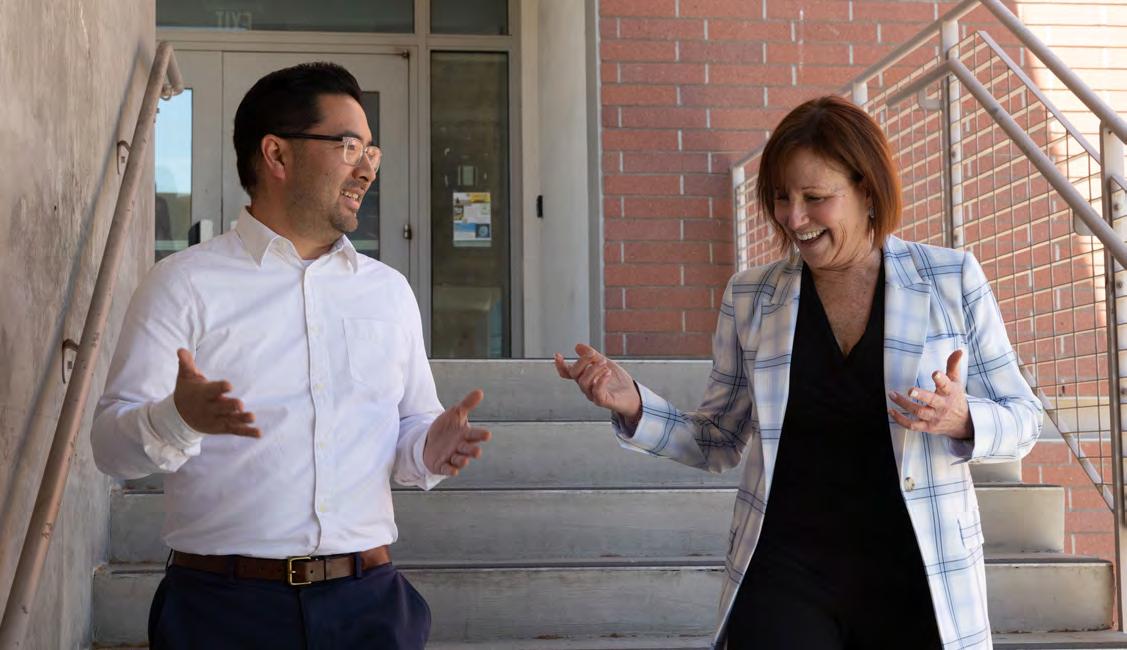
“I remained in contact with a few of my professors ... and I would visit them and ask ‘Hey, can I grade papers?’ There’s not one English teacher on this planet that would not be happy to give their papers away,” Breckheimer says. “It’s a lot of work, and it’s difficult work.”
She started grading students’ papers. She taught a class for Professor Stephan “Steve” Waterworth. There were no teaching assistant positions in community colleges.
“I taught a class kind of for free for Steve and I had to get the dean’s permission and it was a big deal. But it really got my foot in the door, and I just loved teaching,” she says.
She also started teaching at Dominguez, but she went back to El Camino.
“I wanted to give back to a school that laid the foundation for my life and my ability to raise and support my family,” Breckheimer says.
Four years after the birth of their son, the Breckheimers had a daughter. Life was good, until Patrick died.
When Breckheimer talks about her husband,
her voice softens, her eyes light up, the lines on her face relax, and her lips break into a small smile. Breckheimer calls him her “greatest influence” and “the person that has had the most impact” on her. He was her biggest cheerleader when she was in college.
“If I had a struggle on a biology test ... he would really be the one to encourage me,” she says. “And so I was very fortunate to have him in my life and quite frankly, I’m grateful beyond words.”
Her experience taught Breckheimer how important it was to have someone believe in your capability to succeed, so she tried to be that person to her students. She used to teach precollege classes when they were still being offered at El Camino.
“One of my favorite things about that was I was able to find students in my lower-level classes that were really a lot smarter than they gave themselves credit for,” Breckheimer says. She helped students develop a work ethic until they realized they too could be honor students.
English professor Darrell Thompson attests to this. Thompson was 24 when he was Breckheimer’s student in English 1C during the spring 1994 semester.
“She was the one who straightened me out,” Thompson says. “I was in her class early in the semester, and I submitted the draft of an essay. After she read it, her reaction was like, ‘What are you doing here?’ ‘What are you up to?’ ‘What is
88 | Warrior Life
El Camino College Assistant Dean of Humanities Scott Kushigemachi and Dean of Humanities Debra Breckheimer discuss plans while walking down the stairs outside of the Humanities Building on March 27. Breckheimer has been with El Camino for 30 years.
your next move?’”
Thompson says the impact one instructor had on him made him consider doing something he never thought he would end up doing for the rest of his life.
“I realized I am good at writing and that sort of thing,” he says. “She just kind of said, ‘Well, why don’t you go to Dominguez, and get your degree in Ret Comp [Rhetoric and Composition], and come back here and teach,’”
Thompson followed Breckheimer’s advice. He has been teaching in El Camino’s Humanities Department since 1998.
Her ability to change the trajectory of someone’s life isn’t lost on Breckheimer, but she doesn’t think it’s unique to her.
“It’s nothing special about me, I just think that’s a teacher’s job, to encourage and pressure, then kick in the rear end,” Breckheimer says.
It wasn’t just a husband nor a father to her children, but a great mentor she was losing when her husband was diagnosed with brain cancer in 2000. The doctors told them he had six to nine months to live. They decided to make memories with their children. They got a camper, and drove along the California coast.
“We had a fifth wheel camper. So like a big trailer that goes onto a truck and I had to learn how to drive it,” Breckheimer says.
He lived almost four years. Breckheimer says although it was sad when he passed, she prefers it this way instead of not having a warning.
“I don’t know how you deal with the shock (of unexpected death). And the lack of knowledge, at least I knew. And knowing is painful in its own way. But we had time to talk about lots of things, you know, that you wouldn’t want to talk about.”
Unbeknownst to both of them, her husband had one final lesson to teach her, even in death. It was a lesson that served her well when she found out she had “almost stage four breast cancer” in 2012, three months after the death of her mother.
“My husband fought his cancer with a level of dignity and strength that I admire more than I can put into words,” Breckheimer says. “He didn’t know this nor did I at the time, but he taught me how to fight.”
Breckheimer had a double mastectomy, a surgical procedure to remove both breasts, a month later. She counts the date of her surgery as the day she broke free from cancer.
“I’m in full remission,” she says. “I just hit 11 years. I’m very, very grateful. I’m very fortunate and I’m back to being pretty active, too.”
Breckheimer usually wears high heels to work, but not today.
Today she’s wearing green-and-white Adidas Stan Smith sneakers. The sneakers go well with her blazer, her standard office getup. She just had surgery, unrelated to breast cancer. Nothing
serious, but her doctor advised her not to wear heels for a while. Her daughter chose the sneakers.
“My daughter told me to go out with a bang,” Breckheimer says.
She’s talking about her imminent retirement.
“I think I realized that it was time for me to retire because I love my work.” she says. “And I want to go out loving it. I don’t want to go out frustrated.”
Breckheimer became the Dean of Humanities at El Camino 25 years after becoming an Adjunct Instructor of English.
“The reason why I left the classroom is mostly because I saw things that I wanted to change,” Breckheimer says. “The previous dean was retiring, so the timing worked out.”
That desire for change was granted when she had to lead the faculty in revamping the department’s curriculum because of Assembly Bill 705, a bill signed on October 13, 2017 by former Governor Jerry Brown requiring community colleges to use high school performance instead of the traditional assessment tests to place students in Math and English courses.
It was her baptism by fire as a dean.
As a consequence, the Humanities Department had to get rid of all lower-level classes, create a new curriculum, and change schedules.
“We piloted the change a little earlier than the state demanded,” Breckheimer said. “So that was huge.”
The other major project she had to face as dean was how to navigate classes during the pandemic.
“I had to take everybody online, and then get them back to campus. So it’s been a lot of twists and turns,” she says.
Her parting gift is the Writing Center rebuild. Breckheimer calls it her huge passion project. She got a new coordinator for the center which is now the Reading and Writing Studio.
“It no longer looks like the DMV. So it looks like a cozy place that is inviting and welcoming for students,” Breckheimer says.
While she’s quick to add that the credit is not all hers, she says “it’s very important for me to see that get done. It took a lot of fighting to get some money to get some things changed in there.”
Breckheimer’s administrative assistant Michele Bynum says Breckheimer takes students’ needs seriously.
“One of her strongest passions is student success, making sure that students have their questions answered, their concerns addressed when they come into the office. She always makes time for students as well as faculty,” Bynum says.
Therein lies some of Breckheimer’s many frustrations.
“We really are the place for folks to have the ability to turn their lives around,” Breckheimer says. “It’s just that they have to be able to have the ability to do that. And that doesn’t mean mental
Warrior Life | 89
ability. It means their life can’t be so chaotic, that they can’t sit down and write a paper. They can’t be so hungry that when they go to class they can’t think because their stomachs are growling.”
When she leaves the dean’s desk at the end of the spring semester, Breckheimer will have served El Camino College for 30 years — 23 years as a teacher and seven years altogether as an interim faculty coordinator, interim dean, and dean of humanities.

“I’m proud of what I’ve accomplished. And that doesn’t mean that I feel like I’ve done everything right,” Breckheimer says. “I’ve had an amazing professional life.”
Bynum says the dean is looking forward to a new stage in her life.
“Of course, she’ll miss everybody and miss what she’s doing. But I think she’s also taking
the time to think about the next step in her life,” Bynum says.
Breckheimer is happy to leave the seat and is excited at the prospect of a less stressful life but she won’t “go quietly into the night.”
“I might sleep for a month or so but you know, I’m gonna probably do something in health and fitness,” she says. “It’s my passion. It’s been what has really kind of helped me through all my health struggles and stress and everything. So I’m gonna first get certified as a nutritionist and I definitely want to do another triathlon.”
The shelves at her office are half empty, the framed photos of her loved ones are gone. The Dean is wrapping up.
“I think being a dean has been an honor,” Breckheimer says. “[It’s] something I never imagined doing.”
90 | Warrior Life
El Camino College Dean of Humanities Debra Breckheimer leans on the railing outside the entrance to the second floor of the Humanities Building on March 27. Breckheimer, a breast cancer survivor, is in her 11th year of remission.
F lower
Power Bring the
Just in time for graduation season, here are the Top 5 flower shops within 5 miles of El Camino College
With the upcoming graduating season, many El Camino students are looking for the best place to get graduation leis. From low prices to customizing, these five flower shops provide multiple services that accommodate any graduating student.
Kiku Florist and Gifts
This hole-in-the-wall shop is most known for their flower arrangements during graduation season. Only 1.8 miles away from El Camino College, this flower shop is a hot spot for all graduating students because of their price range being $30 to $100 depending on the requested flowers.
Address: 16511 S Western Ave, Gardena 90247
Phone: (310) 327-3034
Hours: Monday-Friday: 10 a.m. to 5 p.m. Saturday: 10 a.m. to 4 p.m. Sunday: CLOSED
Bloom De Fleurs
The bright gold combined with the white walls of the flower shop make you feel like royalty. Every lei is made to order because Bloom De Fleurs orders the flowers that are requested. This flower shop is great if you are looking for personalized gifts, have a specific floral arrangement in mind, and is conveniently 2 miles from El Camino College.
Address: 2140 Artesia Blvd O, Torrance 90504
Phone: (310) 308-9117
Hours: Monday: CLOSED TuesdayFriday: 10 a.m. to 5 p.m. Saturday: 10 a.m. to 4 p.m. Sunday: CLOSED
pre-made center piece of pink roses,
Milieu Florals
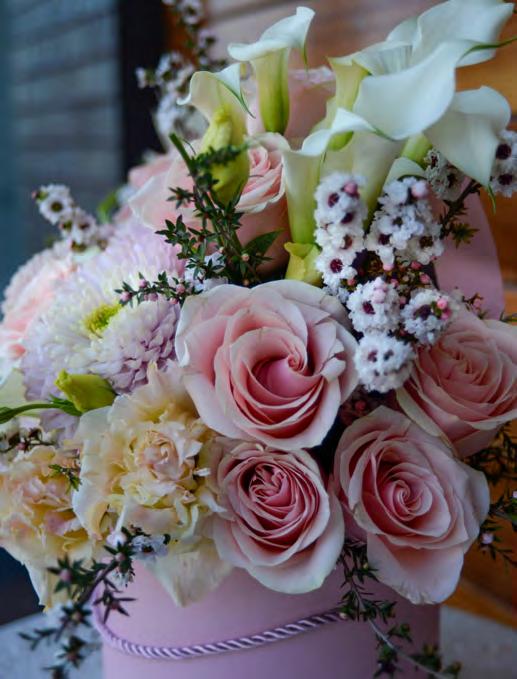
Lilies and other
A professional look with a neutral toned aesthetic will make you wonder if this store is a flower shop. Inside is a large open space with shelves full of finished bouquets, candles, vases, and Chapstick- all sold in one store. Only 3.2 miles from El Camino College, it will leave you in a place that provides workshops and gives you the ability to create your own floral arrangements.
Address: 18545 S Western Ave, Torrance 90248
Phone: (424) 329-0097
Hours: Tuesday-Friday: 11 a.m. to 5 p.m. Saturday-Monday: CLOSED
J Flowers
The freshness of the flowers in J Flowers will give you the sense of walking in an open field only 3 miles from El Camino College. J Flowers provides leis and hand tied bouquets wrapped in paper from Korea, perfect for graduation. With flowers at every price point, J Flowers promotes their ability to accommodate any price range a customer has.
Address: 2708 Artesia Blvd, Redondo Beach 90278
Phone: (310) 374-1596
Hours: Monday-Friday: 9 a.m. to 6 p.m. Saturday: 9 a.m. to 3 p.m.
Sunday: CLOSED
The Gardena Florist
Being 2.7 miles from El Camino College, the Gardena Florist is a small family business. The shop emanates a strong smell of earthy and floral tones, the owner Sung Chang greets you with a warm smile and immediately stops what he’s doing to assist you. This is the place to go to if you’re looking for great customer service.
Address: 1022 W 164th St, Gardena 90247
Phone: (310) 327-9717
Hours: Monday-Friday: 8 a.m. to 5:30 p.m. Saturday: 8 a.m. to 1 p.m.
Sunday: CLOSED
Story and photos by Ash Hallas
A
Calla
soft-toned flowers at Bloom De Fleurs on April 20, 2023.
Warrior Life | 91
TEXTING ≠ LOVE
Life lessons from a victim of a texting relationship
Story by Hannah Bui Illustration by Kae Takazawa
Can distance make the heart grow fonder? Yes, but to what extent is it harmful?
It’s practically the law when a relationship dies to chalk it up to something like “we were on different paths” or “our star signs aren’t aligned.” Blurring the line between what actually happened and the relationship’s potential makes us more inclined to generously sprinkle our vague recollections (delusions) as charitable insight on our friends and family.
This insight can range from something like “play hard to get, they like that” to “you can change him, you just watch.” People will thank us for our wisdom.
Okay, not always. It’s not a foolproof method.
If I’m being honest, do I really want to sign up for another problematic relationship?
Will I allow another ineffectual relationship under the guise of “the experience?”
The ongoing youthful chatter launched the early church conference Saturday, four years ago in July.
I’d be lying if I said I was a fan of large gatherings. But another day of silence in one’s room isn’t tempting to anyone who’d spent their first two weeks of summer break confined in their home (fine, willingly, for the most part).
At the start of the conference, we were tasked with an icebreaker, introducing ourselves to three other people. Names were exchanged. I met an Asian guy named Juan.
I met an Asian guy named Juan?
Our grades came up when it was my turn to share. He’s a year younger, a freshman. Yeah, that works. Hold on, does that make me a cougar?
His single proud and unflinching gaze from across the hall was all it took to jumpstart what became a relationship set up on a DM. Turns out his name wasn’t even Juan. Who would’ve thought, right?
Those DMs became text messages. Text messages became phone calls and the occasional Facetime call between L.A. and San Diego he’d beg me to make.
Things got serious fast.
A whole lot of kissy-faced emojis were exchanged. You would think he was an undercover agent with an assignment with the words he used to send a goodnight text. Gorgeous, stunning, breathtaking. Respect though. The boy was on a mission. Short, but good-looking and athletic. It helped. And he’s super into me.
The existing 124 miles from L.A. to San Diego didn’t faze us. It only made us stronger. He told his friends. The outpouring of support was overwhelming.
By August of that year, with me at summer camp and him busy with football, word of our private matters reached our dear friends and nosy strangers in his absence. And people weren’t afraid to talk about it. His need to share our business became our problem.
When questioned, there was little pushback, but equal amounts of accountability. Then again, he is my “mans,” my “Pookie,” my babe. We’ve had our fair share of virtual biking dates and pictures exchanged, and I’ve even gotten a glimpse of his fish photo and his beloved football helmet. Yeah, we’re tight.
A few weeks later in a text he wrote, “I think I can commit.”
The feeling this generates fluctuates from a “let’s meet up” to “I won’t eat the last slice.” It’s usually a sign of empty promises. It was like he was thinking out loud, believing he could commit when deep down, we all knew he couldn’t.
It felt sudden at the time, but who knows? I didn’t have that kind of experience. I wanted to believe he knew what he was doing. I mean, he had this unwavering confidence and enthusiasm about our future that pulled me into his world of white picket fences and biking alongside each other. It was a pleasant escape from reality.
I put my hopes in the constant notion that I was worthy of a love that existed in movies. I lost myself to a fantasy and he did too.
But who knows what they’re doing at 16 and 15?
Still, here is where you evaluate your stance on love. Showing love by text though crucial shouldn’t
92 | Warrior Life
Will I allow another ineffectual relationship under the guise of “the experience”?
be where it ends.
When it’s time to part ways, you might get hit with the “sorry, I’m too busy, I don’t deserve you, you’re too good for me” speech and know deep down that a part of you knew it wasn’t real.
Was it those text conversations about the news that turned into late-night talks about his friend battling depression? Or stories he’d share from when he and his friends outran the police during his rebellious phase that increased intimacy and solidified our relationship?
In truth, there’s no guarantee a relationship will last even if you text someone 100 times a day. And that’s perfectly fine.
You’ll notice it’s a problem with online communication. It stems from the phenomenon coined by Emily Morse, a sex and relationship specialist called “premature escalation” which is excess communication that may lead to disappointment when you meet up.
Texts can help you create assumed personas, which are used to judge potential partners before meeting them in person, and this can be frustrating when the person you meet isn’t the person you thought they would be.
Although there is a distinction between online and long-distance relationships, it has the same
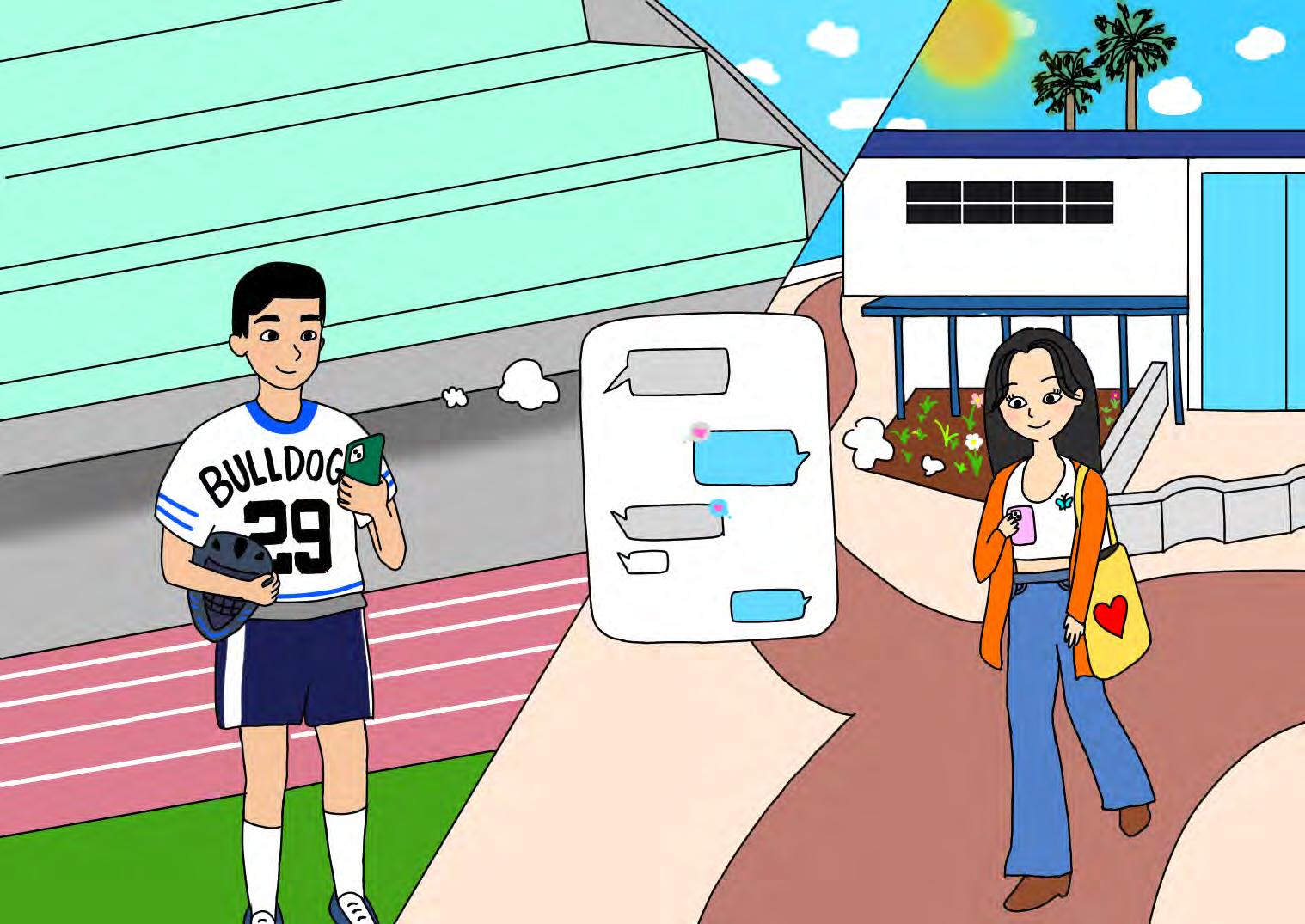
effects on how people can be perceived.
Our initial conversation at the early church conference that Saturday, four years ago in July left a lasting impression on me. It ignited a spark that continues to burn today.
Now, don’t get me wrong, he and I are on good terms now, and fortunately for him, this isn’t the diss track you all hoped for. Considering the events that unraveled, I am satisfied with how things ended because I wouldn’t have been forced to rethink my priorities had the relationship worked.
How can I be responsible for myself when a relationship gets difficult and minimize the harm texting relationships have on me?
Well, here it is.
Sometimes we need to recognize people for who they are instead of making excuses for their behaviors because we believe we know them, especially in texting relationships.
Often, that special someone is fated to fill only a portion of your life or a season, they’re not the only one.
You deserve to regain control of the narrative and not force anything that doesn’t serve you just because the beginning was good.
The ending isn’t always the same.
Don’t confuse texting for love.
Warrior Life | 93
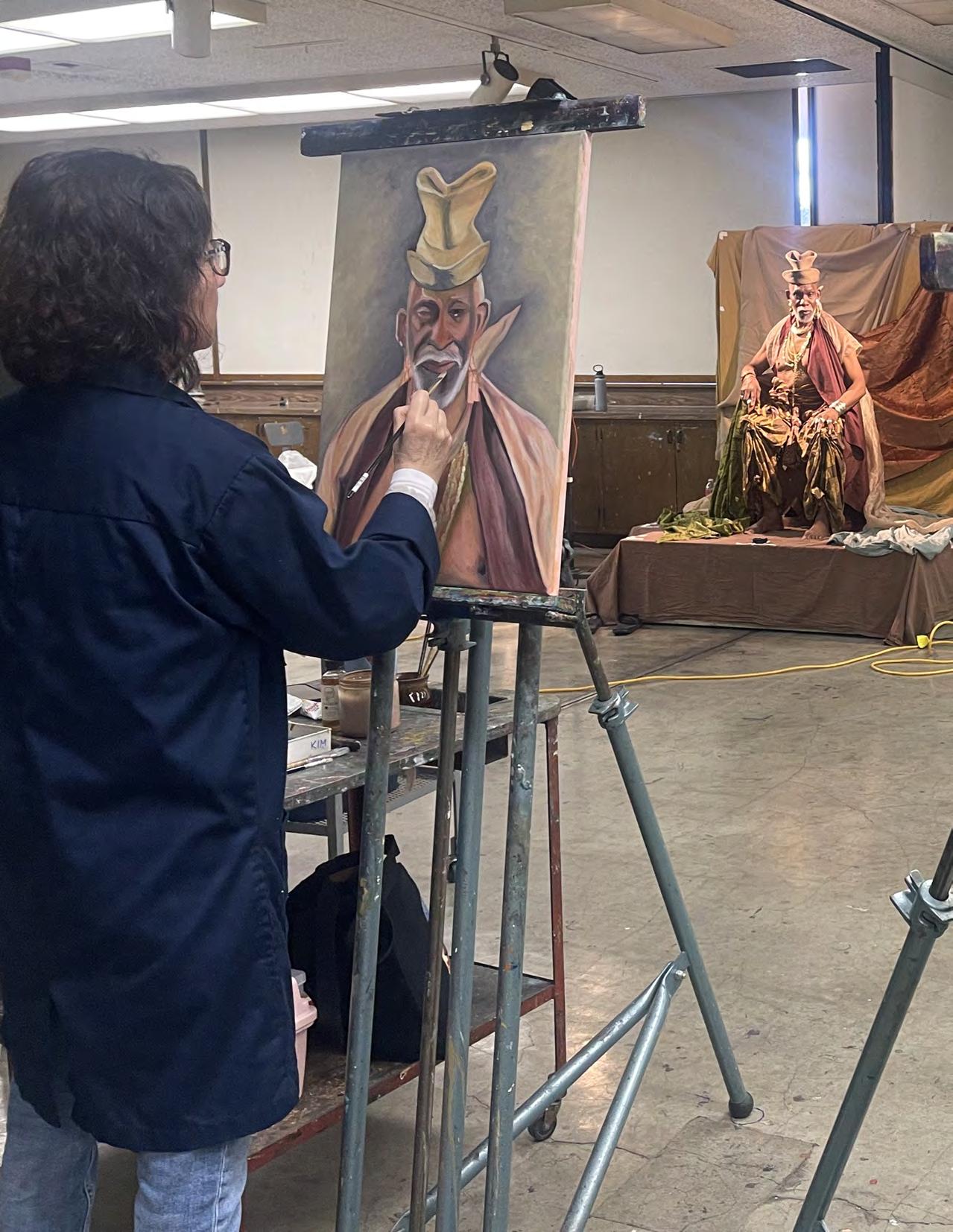

94 | Warrior Life


Warrior Life | 95
Jonathan Beck slides quietly into the large, concrete classroom that smells of paint and dust and maneuvers his way through a jungle of heavy iron drafting easels and metal chairs. Dodging discarded charcoal and pencil lead scattered across the floor and avoiding eye contact with the strangers gathered there, he steps carefully onto a worn wooden platform.
His bearded chin tilts up and long gray hair falls from all parts of his head except for a perfectly round, bald top.

With dark eyes hidden under bushy eyebrows, he looks out for the first time, squinting under the bright production lights that are aimed at him. The lines that cross his face suddenly shift and he grins.
Then he drops his robe.
Imagine Gandalf the Grey, naked.
The purest form of humanity
Art models at El Camino College – and at schools and studios throughout the world – pose naked before hundreds of people each week who they might never see again.
They work alone in the midst of crowds.
They exist in a fishbowl, capturing the attention of everyone, two to 20 minutes at a time.
“Nudity is universally relatable,” says art model Andrew Cahner, 55, of Santa Monica. “It’s the purest form of humanity. When you eliminate clothing or the uniform, it makes it more timeless. You can look at Renaissance art and they look pretty much the same as we do.”
For students, a life drawing class is often the first time they have ever fully seen a naked body. The initial reaction elicits some small gasps, even a suppressed giggle. But within seconds, students adapt despite their shyness and get to work capturing on paper what they see.
“It takes a lot of courage to be vulnerable the way they are,”
El Camino dance major Mia Vargas, 19, says of the models.
“One of the great things about teaching life drawing or life painting is that it puts the nude body into a special context very different from how most of us and our culture responds to nudity,” says Randall Bloomberg, El Camino art professor since 2001.
“It’s great to look at a naked person and respond to it in an artistic way that is elevated from sexuality,” he adds.
Known as a “gesture model,” Cahner has established a reputation for creating dynamic, complex and physical action poses. He does a lot of work for animation studios and animation classes.
“Nudity is not sexual unless it’s made to be,” Cahner says.
During one class at El Camino, he wears a tall chef’s hat and pretends to chase a yellow rubber duck with a plastic cleaver, while students race to capture the skeletal structure within each pose.
These poses are far from erogenous.
The civilizations of the ancient Maya, Egyptians and Greeks were not uncomfortable with, or condemning of, public nudity. The Renaissance promoted study of the human body as an important component in the advancement of art, science and philosophy.
But, as both the Catholic and Protestant Church gained political and cultural power throughout Europe and spread their influence worldwide through colonization and the transatlantic slave trade, strict morality codes were adopted that denounced revealing even small sections of the human body.
Laws were especially harsh in the shaming and control of women and LGBT2IQ2 people.
This history has had a significant impact on American culture, where Puritans played a huge role in the nation’s development.
JJ Cole (above and on previous two pages) models in a life drawing class at El Camino on April 4, 2023. He has worked as an art model for 25 years after retiring from a career as a professional dancer in Houston, New York City and Los Angeles. Kim McGill | Warrior Life
“My parents always instilled in us that you must show your light, never hide it. You must be regal. So, I am in that mode. I present that, because that’s what I am.”
96 | Warrior Life
- JJ Cole
Most Americans remain uncomfortable looking at – or allowing others to look at – the human body, and have institutionalized, incarcerated and even put to death people who challenge that core value.
The current culture wars dominating U.S. politics are again eliminating instruction on Michelangelo’s David from classrooms and banning books that discuss anything from menstruation to reproduction.
Jonathan Beck knows that many people assume that naked modeling is somehow immoral or sexual. He finds this ridiculous. His wife was once challenged about her modeling, and she asked, “Is it sexual to take a shower or to go to a nude beach?”
After serving as a Navy pilot, Jonathan Beck traveled to Canada and lived on a commune.
An older man he met there confronted a Royal Canadian Mounted Police officer who threatened to arrest people for public nudity.
Jonathan Beck recounts this story: “The officer told him, ‘You should be ashamed.’ The man responded, ‘You were there when they crucified Christ. What you wear on your hip brings death and destruction. What I expose brings pleasure and life onto this earth.”
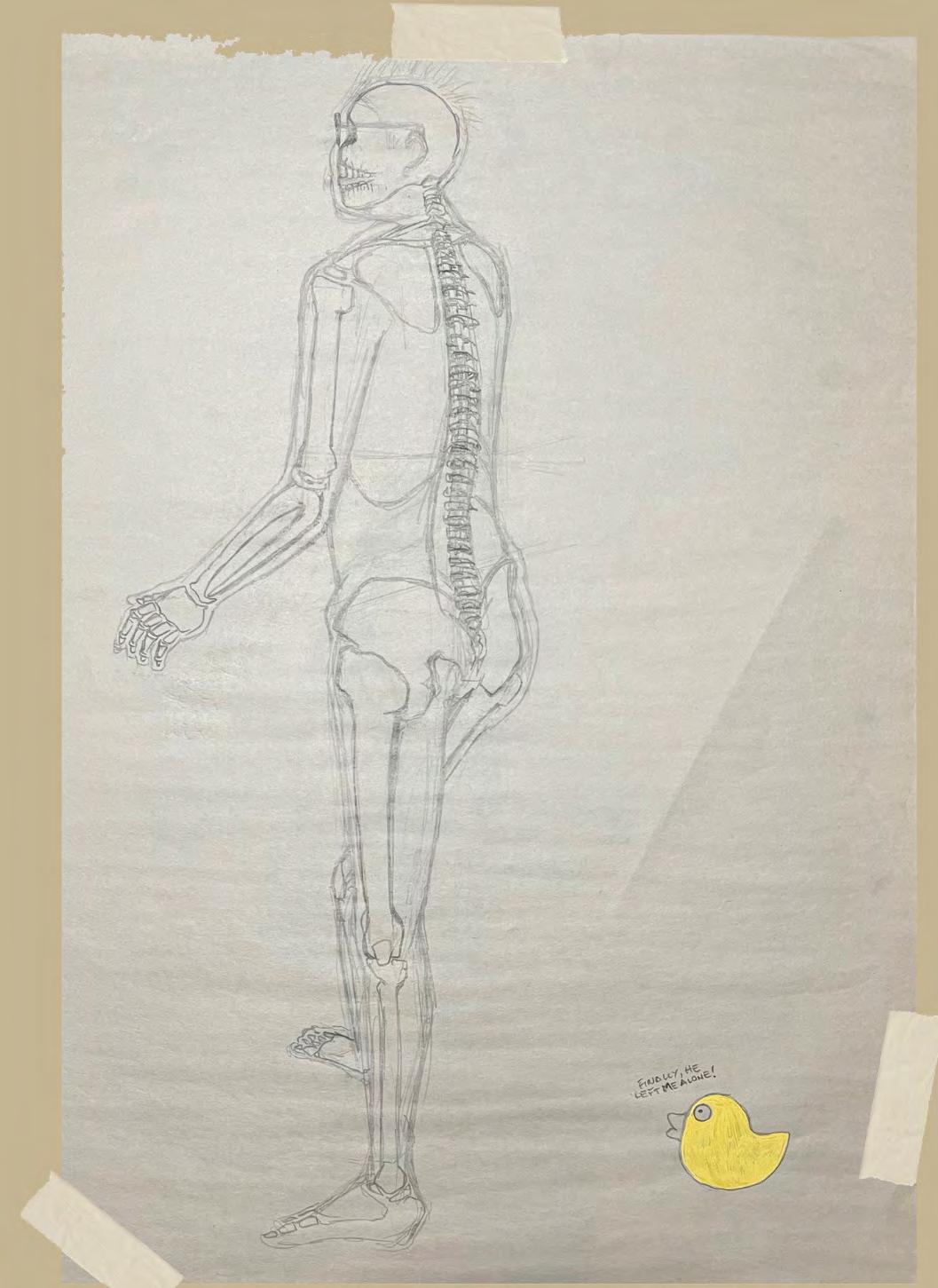
Jonathan Beck says that people have a “contorted” view.
“Breasts are for sustenance. Vaginas are how we all got here,” he says. “The human body is one of the most beautiful things on the planet. It should be drawn.”
Jonathan Beck once showed up at a class to model and all the “old guys” in the class got up and left.
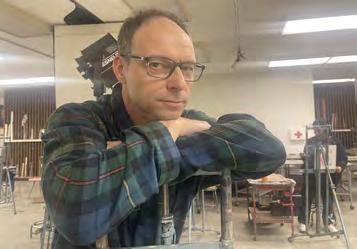
Maybe they were expecting a female model, he says. “You shouldn’t be drawing to get aroused.”
He pauses and then adds, “They were there for the wrong reason.”
Famous, not famous
JJ Cole has transformed the wooden model platform in Art 205 on the second floor of ECC’s Art and Behavioral Sciences building into a throne adorned with gold and brown fabrics. He wears a tall woven hat, robes are draped over his shoulders, and he decorates his neck, ears and wrists with jewelry. He has studied the images of African kingdoms and also draws inspiration from his family.
“I know many people who are very royal, very upright,” Cole says.
At 68, he is the fifth generation of his family in the U.S. from Nigeria. His grandparents were enslaved. His parents worked as sharecroppers in Winfield, Louisiana then migrated to Texas. He was born and raised in Houston, went to college in Pittsburgh and performed in dance and theater in New York City until, at 43, he retired from dancing and began modeling. He now lives in Pasadena.
“My parents always instilled in us that you must show your light, never hide it. You must be regal. So, I am in that mode,” Cole says.
“I present that, because that’s what I am.”
He says the extra attention he puts into setting up his poses also comes from working with theater designers and stage directors who transported audiences to magical places.
“My role is to promote “unification, universality, interconnectivity,” Cole adds.
 Andrew Cahner models for life drawing students at El Camino College in Torrance, Calif. on April 27, 2023. The skeleton on the left is a drawing of Cahner posing in class during the fall 2022 semester. Studying anatomy, including drawing the skeletal form, is a key component of classes at ECC. Kim McGill | Warrior Life
El Camino students struggle to draw from a photo on May 16, 2023, capturing only minor details. Kim McGill | Warrior Life
Andrew Cahner models for life drawing students at El Camino College in Torrance, Calif. on April 27, 2023. The skeleton on the left is a drawing of Cahner posing in class during the fall 2022 semester. Studying anatomy, including drawing the skeletal form, is a key component of classes at ECC. Kim McGill | Warrior Life
El Camino students struggle to draw from a photo on May 16, 2023, capturing only minor details. Kim McGill | Warrior Life
“Nudity is universally relatable. It’s the purest form of humanity.”
Warrior Life | 97
- Andrew Cahner
While Cole rules lovingly over his art class kingdom, he walks through campus without being recognized.
El Camino’s life drawing models are simultaneously some of the college’s most famous and least-known staff.

Their contact information doesn’t appear anywhere in ECC’s directory, but their likenesses decorate the art program’s hallways, fill student portfolios and adorn the walls at campus exhibitions.
They travel hundreds of miles a week to art schools throughout Southern California, yet hardly anyone knows their names.
Their life experiences, skills and academic degrees are endless, yet they are rarely celebrated.
Before the Renaissance, images – whether on canvas, in sculpture, pottery or tombs, or decorating the walls of the
Masterpieces have titles such as “Bearded Old Man with a Wart,” by Wenceslaus Hollar (1607-1677), “Head of an African” by Albrecht Dürer in (1471-1528), “Reclining Male Nude with His Left Arm Shielding His Eyes” by John James “J.J.” Masquerier (1778-1855), or “Naked Sailor” by WilliamAdolphe Bouguereau (1825-1905).
Models who gave so much of themselves to the creation of great art were made invisible.
Their smile, a glance, every sinew of muscle, every crease on their face and the most intimate parts of their bodies have been examined, studied, stolen, copied, sold, celebrated and counterfeited worldwide for centuries, but their names and their stories are unknown.
In more than 500 years, little has changed.
At El Camino, the work of life models enables students to access awards, scholarships, acceptance into university art programs, and employment in competitive art and animation fields.
But models are rarely credited or thanked.
When artwork is sold in galleries, to museums or at auction, the models and/or their descendants don’t share the profits.
The drawing above is a copy of “Reclining Male Nude with His Left Arm Shielding His Eyes” by John James Masquerier, (1778 - 1855), updated to reflect the realities on the streets of present-day Los Angeles. Life drawing students are poften required to create “master copies” of notable art work. Like most art models historically and today, the model in Masquerier’s piece is unnamed despite his contribution. Kim McGill | Warrior LIfe
world’s great pyramids and cathedrals – included depictions of humans, animals and gods, but were not focused on realism.
The Renaissance, from the 14th to the 17th centuries, pushed the use of life models with an emphasis on capturing the exact anatomy, expressions, perspectives and proportions of the human form and its environment.
Art models have been a central component of art instruction and creation ever since.
In life drawing classes, it is often required that students study drawings and paintings by “master artists” that are considered essential to understanding both the craft and traditions of art. The art models are almost never identified unless they were part of the ruling class.
Leonardo da Vinci’s Mona Lisa is valued at more than 50,000 million euros, but neither the painting or any income it generated was ever shared with its model Lisa Gherardini or her descendents. She was the wife of a wealthy Italian silk merchant who originally commissioned the painting. The vast majority of models - then and now - are working class and low-income people.
Jonathan Beck introduced his brother Tim Beck, 74, to modeling 20 years ago.
Tim Beck agrees that art models have been largely forgotten throughout history. But he also imagines that models enjoyed some public recognition while they were alive.
“Before the printing press, before photography, before there were movies, there was the artist. Art models would have been the movie stars of 500 years ago,” Tim Beck says.
Cahner doesn’t focus on the lack of recognition. “It’s not about me,” he says. “I’m there for the students and the client.”
As for Jonathan Beck, even in Hollywood, he has remained mostly anonymous.
He’s been a TV and movie extra including working as a zombie on The Walking Dead and a humanoid robot on HBO’s Westworld.
98 | Warrior Life
His most famous live modeling moment was on The Late Late Show. Host James Corden, Jordana Brewster, Dave Grohl from The Foo Fighters and Rainn Wilson all drew him. The segment has more than 1 million views on YouTube. After the episode aired, the show’s producers contacted him about delivering pizzas naked and he agreed. But Jonathan Beck says the network lawyers were worried about liability and the segment was crushed.
“Art models should get more respect,” Jonathan Beck says.
He is concerned when he’s modeling and students are on their phones. Models face possible exploitation if pictures are taken without their permission. “You don’t know where your image will be used.”
He says it’s also rude to be talking on your phone or texting when models are working.
“Models should be introduced. We’re not expecting it, but instructors should still say ‘Let’s give the model a big round of applause.’ I appreciate it when I get a thank you,” Jonathan Beck says. “We’re not objects, we’re people.”
Bloomberg says that when he was in art school in New York, there was no conversation between models, professors and students.
“These are people that are helping us in our classroom activities, but I didn’t feel comfortable talking to the models, because the teachers didn’t introduce them,” he says.
disciplined and conscientious. He never breaks focus. He completes each 20-minute session warning students to watch as he holds the pose for “three, two, one and done.”
He ends the class cheering for the students and their work. “Bingo! You did it. Great job everyone!” And he claps for everybody present.
“We are human beings, and if we do not celebrate that, then we withdraw, we get caught up in the matrix of existence. At the end of a class when everyone is working, grasping, learning, achieving, understanding that energy that we have, I know I didn’t do it alone,” Cole says. “So, let us cheer our work, let us appreciate this moment because we’ll never get it again.”
An incredible design
On a warm Saturday morning, Tim Beck saunters across the parking lot of a strip mall in Torrance, wearing a wide brimmed black-felt hat. He enters his favorite neighborhood doughnut shop – smashed in between a nail salon and a liquor store – orders a muffin and large coffee, and without hesitation begins to talk about art modeling with a childlike enthusiasm.
“I think there’s a little jealousy, even with the art teachers. Everybody pays so much attention to us. We’re the center of attention for three hours,” Tim Beck says.
Bloomberg explains that making a drawing of a human body is complex, requiring the development of observational drawing skills, perceiving the model and translating the human figure onto paper or canvas, understanding the shadows, the values – lights and darks, and breaking the human body down into geometric shapes, all in order to make the drawing convincing.
You can learn by copying master works by other artists as well as drawing from photographs, says Bloomberg, and both of those techniques are regularly used in art classes.

But he says those techniques are limited.
“The human body is this incredible design,” Bloomberg says. “There’s proportion and harmony that you can only understand by working directly with live models.”
He argues further that having students in the classroom with a live model is “incredibly inspiring” and important to an artist’s development.
“Live models are essential because they show many different angles of the body, shapes, colors, light and shadows,” El Camino art student Fumie Coello says. “Photographs are more limited in showing those details.”
Cahner explains that a photograph is two-dimensional. The camera will distort the image. He says the whole point of

“We’re not objects, we’re people.”
- Jonathan Beck
Lily Caraballo models for life drawing students at El Camino College on May 9, 2023. Kim McGill | Warrior Life
“The students are working to perfect their craft. We are here to support that. Models want mutual respect.”
- Lily Caraballo
Jonathan Beck stands beside a student drawing of himself after modeling for an El Camino life drawing class on May 2, 2023. Kim McGill | Warrior Life
drawing from a model is to transfer all the complexities of a three-dimensional subject onto a flat page.
“I don’t have any aptitude for art,” Cahner says. “I love being a fly on the wall in all these art lectures. The magic of how it all happens is fascinating when someone is successful at a drawing or painting.”
During the Renaissance, artists drew from corpses but quickly realized the need to observe humans with different facial expressions, in various positions and interacting with other people, animals and the world around them.
El Camino art student Zamira Recinos says that looking at a drawing or photograph only gives her one perspective. “Working from an art model helps me to understand the full form of a person since I get to thoroughly examine what I’m looking at” including moving to see all sides.
Without art models providing people a 360-degree opportunity to study and draw the human anatomy, Bloomberg says, visual arts and design would be severely limited.
“It’s like practicing your scales in a music class. If you can learn to draw the human figure, you can draw anything,” says Bloomberg. “You want to have that foundation to have any career in the visual arts. It gives you enormous sensitivity to
composition and proportion for painting and sculpture, but also for animation, architecture and jewelry design.”
Hard and strenuous work
Lily Caraballo, 32, grew up in Queens and went to Lehman College in the Bronx. She earned her MFA in creative writing from Antioch University in Los Angeles. Modeling gives her some income to support her work writing non-fiction and critical essays.
She highlights how important modeling is to artists and speaks about the relationship as mutually beneficial.
“The students are working to perfect their craft. We are here to support that,” she says. “What do models want? Mutual respect,” she says, and for people to understand how physically challenging the work is.”
An art model’s job is strenuous. They maintain difficult poses, without moving. They often work long hours without food, water or clothing, seeking warmth from small space heaters in the cold, and a break from the heat on blistering days with an electric fan.
Tim Beck jokes that he performs the more difficult, standing poses, in “the stance of a warrior” while his brother, Jonathan Beck, “likes to lie down.”
The pose Tim Beck is describing is contrapposto, meaning “opposite” in Italian. Originated by the ancient Greeks, it requires the model to rest all their weight on one leg, and the pose can cause significant pain.
“When I’m modeling, if I don’t want to take a pose that’s too difficult or will injure my body, I won’t do it,” Jonathan Beck says, adding that models must protect themselves on the job
He used to model for a professor at a local university that he says had a terrible relationship with models.
“He is so dictatorial. Once, he wanted me to twist my neck looking backwards for six hours. I’m not gonna do that.,” Jonathan Beck says. “He [the professor] said ‘You’re the model,’ as if I had to do whatever he said. It was that whole domination thing where he saw me as his little servant.”
Jonathan Beck believes the minimum that all models should expect is a clean model stand that is close enough to the floor that it’s not difficult or painful to step down from after a pose, a temperature that is neither too hot nor too cold and heaters and fans available to adjust the climate as needed, a pole to lean on –essential for many poses that require a lifted arm or the concentration of weight
A drawing of art model Marguerite Garner interpreted as an exhausted single mom. Kim McGill | Warrior Life
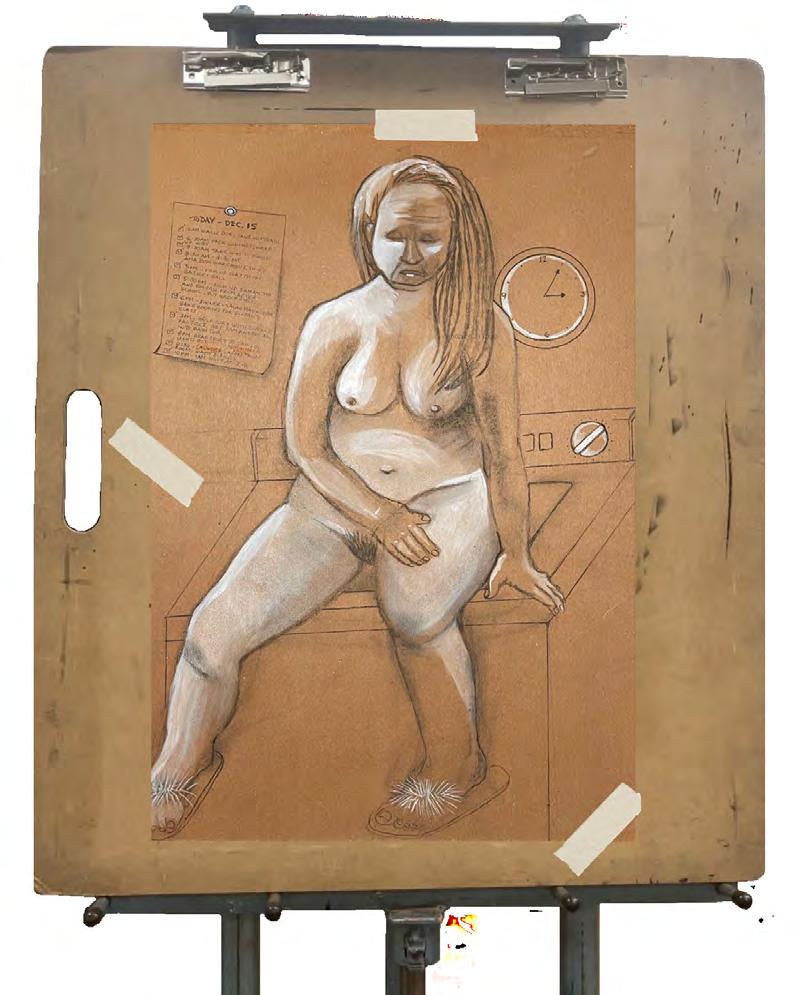
on one leg and smaller five-minute breaks every 20 minutes as well as a 20-minute break every two - three hours.
The Uber or Lyft of the art world
Niccole Blair travels nearly 88 miles, often more than a fourhour round trip drive, all the way from Crestline, Calif. near Arrowhead to El Camino College. Some places she models for are even farther away. On Dec. 13, 2022 she left before dawn during the season’s first snowfall. Her boyfriend helped her clear the snow from her car. She just got a new four-wheel drive. “That will help,” she said.
When the historic winter storms hit Southern California in February 2023, Blair was snowed in for nearly two weeks. There was a strong mutual aid network that neighbors set up for each other –especially needed when the roof of the local market caved in under the weight of the snow - but the world outside the mountain communities supported only briefly and barely, she says. She lost nearly two weeks of work. There is no emergency pay or disaster relief available for her or other models.
Life models hustle year-around for opportunities. They are among the world’s oldest gig workers.
“We are like Uber or Lyft of the art world,” Jonathan Beck says.
Cole has 475 clients – universities, colleges, studios, art classes – and he works “morning, noon and night,” finding time to rest in between.
At El Camino, models earn $30 an hour and get free parking. But, hourly rates can be less, and some schools make models pay for parking.
Art models receive no health insurance, retirement, paid vacation, holidays or sick days at ECC or any of the other schools and studios they work for. The profession is not unionized.
They travel hundreds of miles a week to different colleges, art schools and studios, but none of the models at El Camino are reimbursed for public transportation, mileage or gas.
Marguerite Garner lives in Torrance and has been modeling at El Camino for 20 years. In addition to El Camino, she drives to work at the Laguna College of Art and Design in Laguna Beach and Saddleback Community College in Mission Viejo.
In addition to parking, Garner explains that some schools make models pay for fingerprinting and blood or urine testing. Since COVID, models are also required to get regularly tested,
get all their vaccines and remain masked at all times.
“If you’re going to be taking your clothes off in front of minors, they want to be careful, and I understand that,” Garner says.
But, she adds it’s expensive, especially when models have to repeat the tests for multiple sites.
“Professors champion us, but college administrations might not understand our importance. Some models have quit and won’t come back,” Garner says.
Cahner started modeling 20 years ago and it’s been his main job for 15 years. He generally works for 20 to 25 schools and art studios each semester.

“You take what you’re offered. You either say yes, or they’ll find somebody else,” he adds.
There are days when he wakes up at 5 a.m. to work an early morning class then covers a night class at 8 p.m.
“There is no typical day,” Cahner says.
Garner says that models have rarely been well compensated, if at all.
In the past, some were wealthy or famous beauties, explains Garner. But, many more were “mistresses, courtesans, and wives – Picasso had a few,” she says. Toulouse-Lautrec painted exotic dancers and sex workers.
People who were enslaved or unhoused or laborers in the homes where artists lived were often depicted. Power imbalances make it questionable whether many models could say no.
“It [art modeling] was traditionally the wheelhouse of street people,” Garner says.
Cahner says that there is a lot of unpaid time for travel, scheduling and growing administrative requirements.
“One universal thing in higher education is expanding bureaucracy and that’s getting more egregious over time,” he says.
During COVID when schools shut down, some colleges and art studios ignored commitments and refused to pay models anything. Many models struggled to survive financially.
“I come from a business background, and it’s been very revealing to me how - from a management perspective - organizations treat their least powerful constituents,” he says. “Times of crisis don’t build character, they reveal character.”
All ages, shapes, shades and sizes
Models provide art students with the most essential resource
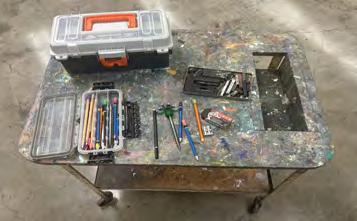 Student supplies are laid out during a life drawing class at El Camino College on March 21, 2023. Kim McGill | Warrior Life
Student supplies are laid out during a life drawing class at El Camino College on March 21, 2023. Kim McGill | Warrior Life
“I’m not airbrushed. You can’t change the channel. This is what a real woman looks like.”
- Marguerite Garner
Warrior Life | 101
ECC art student Zamira Recinos presents her final portfolio to a fall 2022 class on Dec. 9, 2022. Kim McGill | Warrior Life
both understand people and learn how to draw them - access to the human body in all its forms.
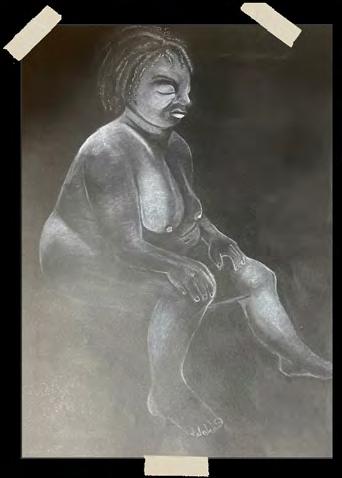
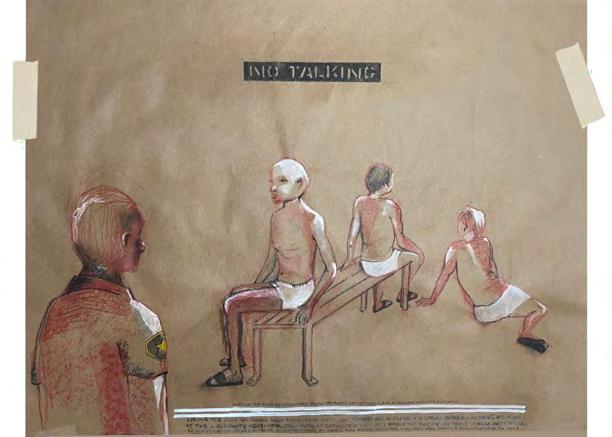
But, discrimination against people of color, women, transgender and LGBT2IQ2 people, elders, heavier people and people with disabilities eliminates opportunities for many models.
“Some art schools want greater diversity,” Garner says, “not just what’s stereotypically pretty or glamourized.” But she adds that this is not the norm.
At El Camino, models range in age from their 20s to 70s. They represent a wide variety of heights, weights and genders. In the past two semesters, at least four Black models and eight white models have worked on campus, although Asian, Indigenous and Latinx models haven’t been represented.
Garner believes that diversity of models is essential for the production of art, as well as the representation of life. She has experienced discrimination directly when that value isn’t prioritized.
“Women get judged, ignored and made invisible,” Garner says.
“I’m not airbrushed. You can’t change the channel.” She says she is what a real woman looks like. We are soft and we are hard. We don’t work out, or if we do, we don’t work out in ways you think. I could be your mom, your aunt, your neighbor,”
Garner says. “I’m 66. They’re not going to call me if they want a young woman. But, my look is flexible. I can fix my hair and put on makeup or I can look like ten miles of bad road if they ask me to.”
Garner has developed a thick skin.

She admits that there are always discussions about different body types. Schools have said they want “pretty, young girls, perky, not saggy.” She knows they aren’t going to call her.
“I don’t find it disrespectful,” she says. “It comes with the territory.”
Hearing that she was interpreted in one student drawing as a tired mom struggling after a hard day of work to complete a long list of household chores, Garner laughs.
“That is what I want to be – a single mom sitting on top of the dryer – as much as I want to be Bathsheba,” lover of King David and mother of King Solomon, Garner says.
“My attitude is what keeps me working,” she adds.
A rtists, inventors and entrepreneurs
Jonathan Beck first worked as a model in 1979. He met his wife at the Art Center where they were both modeling. She had worked as a dancer in Hollywood and even worked with Gene Kelly. She was in TV shows also, like “Hawaii 5-0.” She left show business.
“Too many Harvey Weinsteins,” says Jonathan. “It’s a very cut throat, terrible place, a lot of back-stabbing competition.”
After getting married and having kids, Jonathan Beck left modeling to earn more money. He worked for Baskin Robbins at their training center.
“I taught franchise owners how to scoop ice cream,” he said.

In 2003, Jonathan Beck was laid off, so he went back to modeling and has been doing it ever since.
“I like freedom,” he says. “In modeling, you can be your own boss, leave a bad situation, just get off the [modeling] stand and walk out.”
Caraballo started modeling to help with bills and pay her way through school. But she says over time that changed.
“I began to find modeling to be creatively fulfilling for me. It got me back into art and art history, and being surrounded by other creatives working on their craft encourages me to keep working on my own,” she says.
She lives in South Los Angeles where she listens to a lot of music, enjoys cooking, is an avid gamer and has a book blog on Medium where she talks about her writing. “Since high school, I also found a love for street photography, and I dabble in that here and there,” she adds.
Cole began as a student at M.C. Williams Community
Tim Beck is the model for the student drawing (top) depicting L.A.County Jail. He shares his business opportunities at Jon’s Donuts in Torrance, Calif. on April 1, 2023. The bottom photo includes him and his sheepdog, Lord Randal, on their 1970s trip hitchhiking across the U.S. Kim McGill | Warrior Life
102 | Warrior Life
A drawing of Lily Caraballo from fall 2022 semester. Kim McGill | Warrior Life
School, Theatre and Dance Center in Houston where he studied ballet, modern and jazz dance. As a teenager, he performed with the Houston Ballet School and Company. In 1974, he studied theater arts at Carnegie-Mellon University in Pittsburg before moving to New York City where he performed on and off-Broadway, as well as with Nat Horne, Finis Jhung, Frank Hatchett, Martha Graham Dance Company and Alvin Ailey American Dance Theater.
“My life’s philosophy is simple, direct and to the point,” Cole says. “I do what I do when I do it, then it is done. I don’t have to show off, but just do my work impeccably well for the benefit of everybody involved.”
Cahner has a business degree, started a company and sold a company, but enjoys modeling. “There’s something spiritually satisfying about it,” he says.
Garner started working as a live model when she was an art history and life drawing student at Cal State Fullerton (CSF) in 1979. She earned a master’s degree in Visual Anthropology from CSF and taught English and Sociology in Inner Mongolia. She lived in the Middle East and has worked as a professional dancer in middle eastern, belly, and Iranian folk dancing. She has a United Nations Educational, Scientific and Cultural Organization (UNESCO) certification in Kalbelia and other folk dance traditions from Rajasthan, India.
In 1992, she met her husband, Arthur Kusuhara, now 85, at the Long Beach Renaissance Fair. She is now Kusuhara’s full time caregiver since he had a stroke and began losing his eyesight.
As a model, Garner incorporates her love for culture and life experience into her work, specializing in historic costuming. She recently helped to create a pirate pose at Saddleback College.
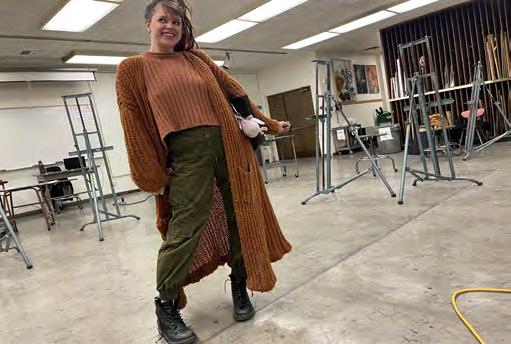
“I really love my job, and will go a long way to accommodate people – except shave my head. I won’t shave my head,” she says.
Tim Beck has made a dramatic career change every decade.
He grew up in Torrance and went to North Hills High School. He says that despite getting a D in typing, he majored in journalism at El Camino College.
In the 60s, he earned a bachelor’s in Botany and a master’s in Biology at UCLA, and was recruited to work as an organ
transplant technician, because he was “big enough to push an 815-pound machine up a ramp.”
By the 70s, he was assisting in surgeries to remove kidneys and prepare them for transport. “You don’t need a medical license to operate on dead people,” he says. He hitchhiked across the country with a sheepdog named Lord Randall, including looking for his brother at the commune in Canada. But the day before he arrived, Jonathan Beck had left for the east coast to see the sunrise with a girl named Laughing Water. “Those were the days when LSD was called vitamin L,” he says, chuckling.
In the 80s and 90s, he taught science and math in public and private schools, but never lasted long due to his controversial teaching methods, including sharing tips with high school students about safer drug use.
In the early 2000s, Tim Beck moved back to his childhood home in Torrance to care for his ill mother. He began working as a model and also advocated that part of Sacred Cove Beach in Rancho Palos Verdes be an unofficial nude beach. They regularly ran from the police and argued with local residents who, according to him, “act like the beaches are their private front yards rather than belonging to all people.”
Five years ago, Tim Beck had throat cancer and received so much radiation and chemo that he was known to friends and hospital staff as “fall-out boy.” He dropped down to 120 pounds and spoke in art class about trying to get his “modeling muscles” back.
He has patents for several inventions including an improvement on the design of the Frisbee, the use of dry ice pellets and liquid nitrogen to put out an industrial fire, and an oil spill solution.
Reflecting on it all, Tim Beck sees art modeling as a highlight.
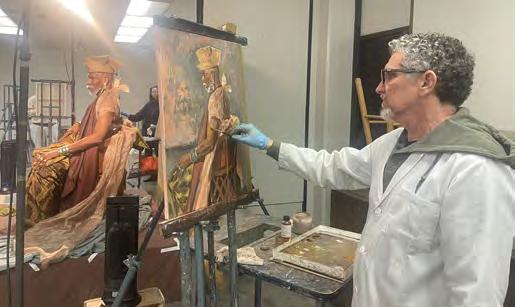
“Being an art model is a reward for achievements in good works,” he says.
“Maybe the model in great paintings was nameless, maybe they got no money, but when a new portrait dropped it was carried through the streets, and people would come out of their shops to marvel at the artist’s work. And who is that guy? He is the art model,” Tim Beck says.
Then, he drops a large white envelope on the table with a detailed sketch that a student has done of his face.
“Who’s that guy? He’s an art model,” he says laughing.
ECC art professor Randall Bloomberg paints art model JJ Cole in class at El Camino on April 4, 2023. Kim McGill | Warrior Life
Warrior Life | 103
Art model Niccole Blair heads home after posing for students in a life drawing class on April 4, 2023. Kim McGill | Warrior Life

104| Warrior Life
Kyong Yu, owner of the Korean-themed restaurant Mr. H’s Lunch Place, tosses a wok of food into the air as she cooks a meal for her workers in Gardena.
A RESTAURANT REBORN
A Japanese restaurant closed down during the pandemic. Now, they’re back with a new Korean take on food.
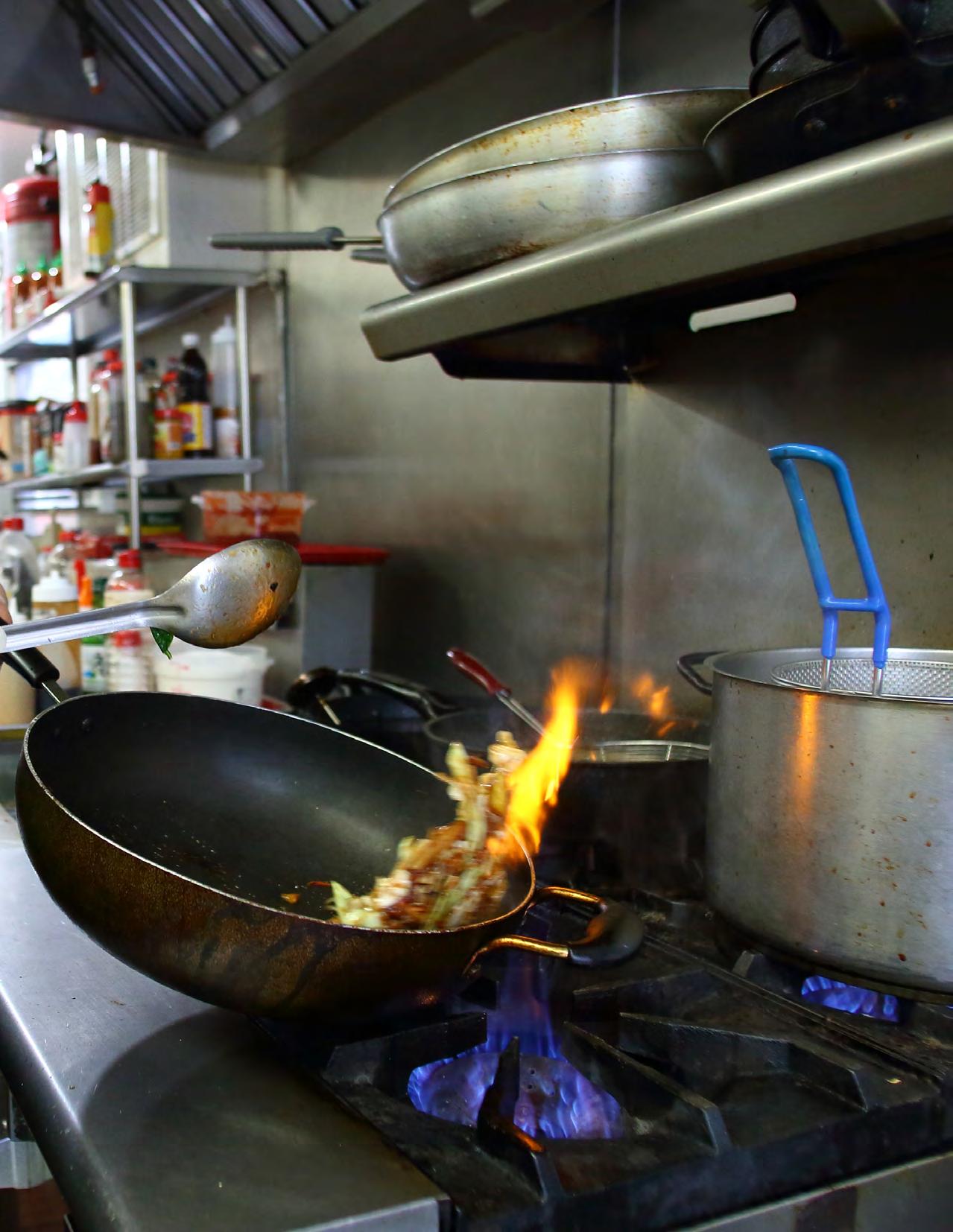
Warrior Life | 105
Story and photos by Raphael Richardson
Across the street from El Camino College, in a compact restaurant nestled inside a former motel-turned-office building, a woman steadily churns out scratch-made Korean food in her kitchen.
That woman is Kyong Yu, whose anglicized name is Jennifer (Jenny for short), the owner of Mr. H’s Lunch Place, a Korean restaurant catering to ECC students. And right now, she’s busy making meal after meal for a special client — GrubHub. They have sent a photographer to take photos of Yu’s food to use on their mobile ordering app.
At 3 p.m., the restaurant is otherwise not busy — except for an El Camino instructor and a few of his students waiting to pick up their orders of Korean cuisine.
The restaurant is at its busiest in the beginning of the week, when most students are at the college. The flow of students into the restaurant peaks around noon, when most take their break and slows as the day progresses and they begin leaving for home or work. By Friday, the restaurant is usually quiet.
Soon, the blitz of plates going to and from the kitchen stops as the photographer finishes getting shots of the food. “You’re faster than like, 90% of the restaurants I work with,” he says. Yu gives him a bag with two meals to take home before he leaves.
Yu is a chef at heart. Born in South Korea, she moved to the United States with her husband and owned and managed a few restaurants and stores across California. Eventually, she began to work at a new Japanese restaurant in Gardena – Wasabi Sushiya.
The tale of Wasabi Sushiya is a complicated one that leads right back to the same spot – a new restaurant, Mr. H’s Lunch Place, in the
same location that honors a man who worked right across the street at El Camino College.
That man is Hiram Hironaka.
Hironaka, known to both El Camino employees and students as Mr. H, was the college’s automotive technology instructor. Originally an automotive teacher in the 1970s at the since-closed Buchser High School in the Silicon Valley area, Hironaka joined El Camino to teach automotive technology in September 1983, eventually becoming a tenured professor before retiring in 2015.
With a passion for his students, Hiram decided to open up a lowcost restaurant for students to go, and the perfect spot was just a crosswalk away from campus.
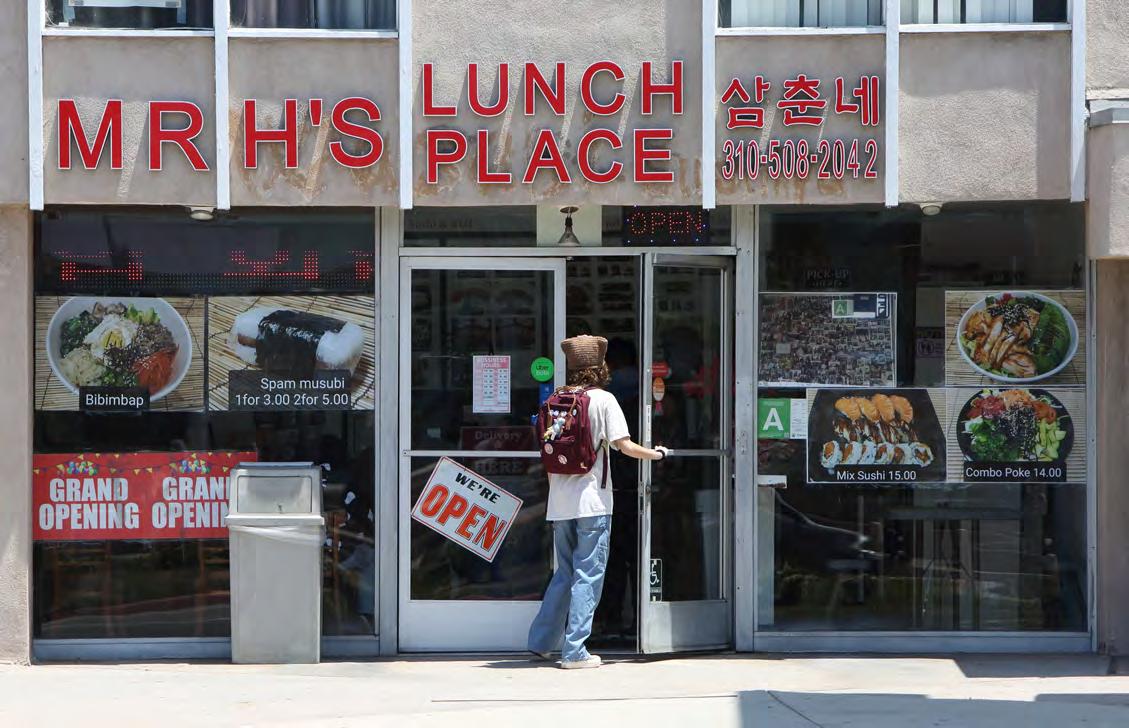
“My goal was to provide good food that was reasonably priced, and healthy fresh food for the kids,” he says. “Out of love for the kids and everything. My heart felt good – my pocketbook didn’t.”
Today, he pulls his car up close to the front doors of the restaurant, coming in with a bag of lemons for the restaurant, and a ukulele for himself. He’s dressed simple - A gray T-shirt with a black and white stripe going through the middle, a pair of camouflage shorts, and a pair of square shaped glasses. A leg brace gives him a slight limp as he walks into the store. The many wrinkles on his face account for the numerous years of experience as both a professor and restauranteur.
“I thought it would be a good idea to branch out into the food industry,” Hiram says as he takes a seat in the restaurant. He checks in on both Yu and the restaurant every Friday.
Being a professor while running a restaurant across the street from the campus where he worked was not an easy job, Hiram says.
“Basically what I would do is I get to teach, and then I will come
106 | Warrior Life
A customer enters Mr. H’s Lunch Place during the midday lunch rush. The label scar of Wasabi Sushiya’s old sign is visible behind the new blazing red sign of Mr. H’s. The restaurant is named after retired El Camino College automotive technology instructor Hiram Hironaka.
here, eat, go to the backroom and sleep,” he says with a laugh.
Despite not working at the restaurant anymore, he still comes into the restaurant for Yu, who runs Mr. H’s with the help of a few employees.
Often working in the kitchen, she dons an apron that adorns whatever shirt she chooses that day. She wears a hair net that covers her short, wavy black hair, and black glasses with blue accents.
Her old age means she takes her time walking across the restaurant, but she is lightning fast with her cooking and to the point with her words like every sentence is a business proposal.
“I used to have [a] husband,” she bluntly says. “But he died.”
Yu keeps her backstory relatively short. She would rather focus on the restaurant.
As with any locally-owned business, Yu has not had it easy running Mr. H’s, and neither did her predecessor Hironaka with Wasabi Sushiya.
Business with the new restaurant was fine — until the Great Recession in 2008. Around the globe, the economies of nations slowed in what the International Monetary Fund said was the most severe economic collapse since the Great Depression in 1929.
As the U.S. housing market collapsed and banks and corporations fought to get by, Wasabi Sushiya struggled to stay afloat.
“There was a downturn in the economy in this local area,” Hiram says. “We took a hit.”
However, unlike many small businesses at the time, Wasabi made it through the 2008 recession relatively unscathed. The business, at
the time, was still intact.
For the next few years after the Great Recession, Wasabi Sushiya was getting by. Besides some problems with gas bills that were resolved, nothing was really standing in the way of the small Japanese restaurant.

That was, until 2020 came around.
And when 2020 came around, so too did COVID-19.
“It ruined us,” Hironaka grimaced. “All of a sudden people couldn’t eat inside, people were afraid of coming in.”
The pandemic figuratively and literally shut down the global economy. Lockdowns and virus outbreaks among shipping workers caused global supply chains to come crashing to a halt. This, in turn, wreaked havoc for retailers, and in particular, small businesses, like Wasabi Sushiya.
The pandemic did not spare anyone and any business. Julie Clowes, the director of the U.S. Small Business Administration’s L.A. District Office, says that the lockdowns affected virtually every sector of business.
“You can say … that pretty much every business was affected in some way, shape or form,” she said. “Obviously certain industry sectors had a much harder hit and were much slower to come back. I think of something like the hospitality sector, where the businesses had to shut down and they didn’t really have … another avenue [of revenue].”
The SBA is a federal agency designed to support small business with anything from loans to business advising to disaster relief. With
“It ruined us. All of a sudden people couldn’t eat inside, people were afraid of coming in.”
-Hiram Hironaka
Warrior Life | 107
Dozens of photos from a previous era of owners Hiram Hironaka and Kyong “Jenny” Yu’s restaurant line the walls of Mr. H’s Lunch Place. The restaurant, located across the street from El Camino College, is full of items from previous restaurant Wasabi Sushiya.
the pandemic being considered a disaster, it put a heavy strain on the agency as it struggled to deal with the flood of requests from restaurants desperate to stay open.
“During the height of the pandemic, we had four different programs running simultaneously … so the one [program] everyone thinks of is the RRF, or the Restaurant Revitalization Fund,” she says. “That certainly reached a lot of restaurants, although we had a greater demand than we had supply of funding, unfortunately.”
The SBA reported that they dispersed almost 16,000 grants, totalling around $5.7 billion in aid, but it was not enough to stop the closings.
The slow march of death for thousands of restaurants across the country began, with the National Restaurant Association reporting around 90,000 of them permanently closing their doors by May 2021.
For Wasabi Sushiya, which had weathered the 2008 recession, the pandemic would soon prove to be its breaking point.
Unlike the 2008 recession, COVID hit the restaurant hard. A multitude of problems began piling up against the restaurant. Just a
year before, construction projects for the soon-to-be Administration Building left the entire east side of campus bordering Crenshaw Boulevard closed, barring students from going to Wasabi Sushiya.
“They had fenced off the whole front, from Manhattan Beach Boulevard all the way down to Redondo Beach,” Hironaka says. “Automatically, we can see that it became a barrier … We put up with that for one whole year.”
That following year, 2020, Hironaka opened the business back up, only for his prospects to come to a crashing halt when the lockdowns were enacted on the state and federal levels, closing his business again.
As he struggled to deal with the lack of customers, he, like many other business owners, kept his employees on payroll, paying their salaries out of pocket.
“I felt that I needed to keep them afloat, too,” he says.
The situation Hironaka was in became too much for him to handle. He was hospitalized in late 2021 and handed over the reins of the restaurant to Yu. But despite her efforts, the restaurant shut down, with the company’s Instagram announcing the closure in the middle of December, two days before they shuttered.
“2021, December 17. We shut down,” Yu says, “I tried to reopen [in] May, but we had a lot of problems.”
It was at this time that they decided to rebrand the restaurant altogether. Yu had one person in mind when it came to the name of the restaurant — Hironaka. Having supported her the entire time she has been at Wasabi, Yu wanted to give back to the man that had supported her for years.
“He doesn’t even make one penny, he is just trying to support me,” she says. “I really appreciate it. I want people to remember his name - ‘Mr. H’s Lunch Place.’”
From the ashes of Wasabi Sushiya, Mr H’s opened on Aug. 15, 2022, days before the fall semester started.
Back in the kitchen, Yu cleans the mess left over from the GrubHub order and begins making a smaller and simpler meal for her workers – a hearty dish of chicken and vegetables.
“It’s cheap to make,” she quips as she prepares the meal.
She starts by dumping a small bag of pre-cut chicken into a wok, a cooking pan common in Asian countries. After letting the meat cook through, she pours in a mixture of chopped cabbage, carrots, and soy sauce, letting the new ingredients sizzle against the piping hot pan.

Letting the mix sit in the pan, she reaches over for a bottle of hot chili sauce. She pours the red ketchup-like sauce into a large spoon, dumps it into the wok, and tosses the mix several times, causing the flame of the grill to flare up.
In a few short minutes, she’s done cooking. She takes it over to an awaiting plastic container, and plates up the steaming hot food to be eaten later.

She then whips up a small plate of salmon for Hironaka before sitting down at the bench to discuss the future of Mr. H’s.
As of now, Yu says, they aren’t sure of what’s going to happen.
“We don’t know,” she says with a chuckle. “Maybe one day I die, we don’t know.”
While they enjoy running the restaurant and don’t want to stop, they don’t plan on running it forever. When the time comes for Yu to retire, they have plans on selling the restaurant.
“It would be great to have somebody take over so that we can continue the tradition of providing good food for the kids at a reasonable price,” Hironaka says. “That’s what I would look for in a buyer.”
Top: A plate of shrimp yakisoba sits ready to eat after being prepared by Kyong “Jenny” Yu, owner of Mr. H’s Lunch Place.
108 | Warrior Life
Bottom: Chicken and vegetables lay on top of a bed of rice in a dish made for Kyong Yu’s workers.

Warrior Life | 109
Retired El Camino College automotive technology instructor Hiram Hironaka, left, and Kyong Yu, right, pose for a photo together. Hironaka was hospitalized in late 2021 and handed over the reins of Wasabi Sushiya, which became Mr. H’s Lunch Place, to Yu.
The Journeyman
From playing to coaching and representing wrestling, the story of Tom Hazell
Story by Johan Van Wier
Photos by Raphael Richardson
Tom Hazell is known for his legacy left in wrestling, including the biggest mark at El Camino College as a student athlete and as head coach.
Hazell, 73, grew up in Inglewood where his love of sports began. He attended Inglewood High School where he was involved in wrestling, football, and track and field until he decided to attend El Camino.
At first Hazell was inclined to play football at El Camino after having a positive conversation with then coach Ken Swearingen. Hazell was originally thinking about football because he thought he was better at it than wrestling at the time.
Following the talks with Swearingen, Hazell had a conversation with El Camino wrestling coach Dave Hengsteler. Hengsteler invited Hazell out to a steak dinner where they talked about wrestling his first year at El Camino and playing football the following year, which intrigued Hazell.
Hazell chose to wrestle to start at El Camino, but planned on playing football the following year.
“Well the steak dinner was the big deal because no coach has ever gone out of their way with that process. I definitely enjoyed it,” he says.
Hazell would never look back from the decision to become a full-time wrestler. Hazell achieved feats like state championships, MVPs and All Americans in the end. He never did go back to play football the year after, but still thinks about it.
“I was one steak dinner away from being a professional football player… that’s all Kenny had to do,” Hazell jokingly says.
After his time at El Camino, Hazell had offers from top Division 1 wrestling programs like Oklahoma State, Washington State, Michigan State and UCLA.
Hazell chose Oklahoma State after having a great visit in the town of Stillwater, but he was not aware of what he was stepping into.
“I was very naive at the time, understanding how much an offer to wrestle from them meant,” he says.
Oklahoma State was the top tier elite program
for Division 1 wrestling. They had won 33 National Championships at the time, the next closest team had only won five.
Oklahoma State’s wrestling team was on another level. By comparison, UCLA’s wrestling team struggled to beat community colleges in the South Bay because of the massive surge of wrestling at the time including ECC.
The resurgence of wrestling programs in the South Bay came because of wrestling being a high interest in the 1970s with the start of the sport in the South Bay, leading to the talent rising.
When Hazell moved to Stillwater he realized how big of a deal wrestling was to the community.
With Oklahoma State’s success, the town also had the top wrestling high school in the town as well. Hazell came to realize that he fed into the network of the Oklahoma small town.
“It felt like home with the wrestling background and the traits of the town,” Hazell says.
Concluding the time at Oklahoma State, Hazell won a Big 8 Championship and was All American twice. He continued his career after college, representing team USA in tournaments in Mexico City, Switzerland, Russia and more.
“At this time all I thought about was wrestling, it just felt like my routine. Just get up and show up,” he says.
After finishing his career in wrestling Hazell stayed in Oklahoma for a stint where he was a part of the coaching staff at Oklahoma State as an assistant.
In 1978 Hazell got a job offer to teach in San Diego as a physical education instructor, prompting him to make the move back to California. Hazell would only teach there for two weeks before he eventually got the job offer to coach wrestling full time at El Camino.
On his way back to California, Hazell got a call from the wrestling coach, Donald Conway. He talked to Hazell about how he’d received an offer to be the head coach for the wrestling team at UCLA and how he really wanted him to apply for the El
110 | Warrior Life
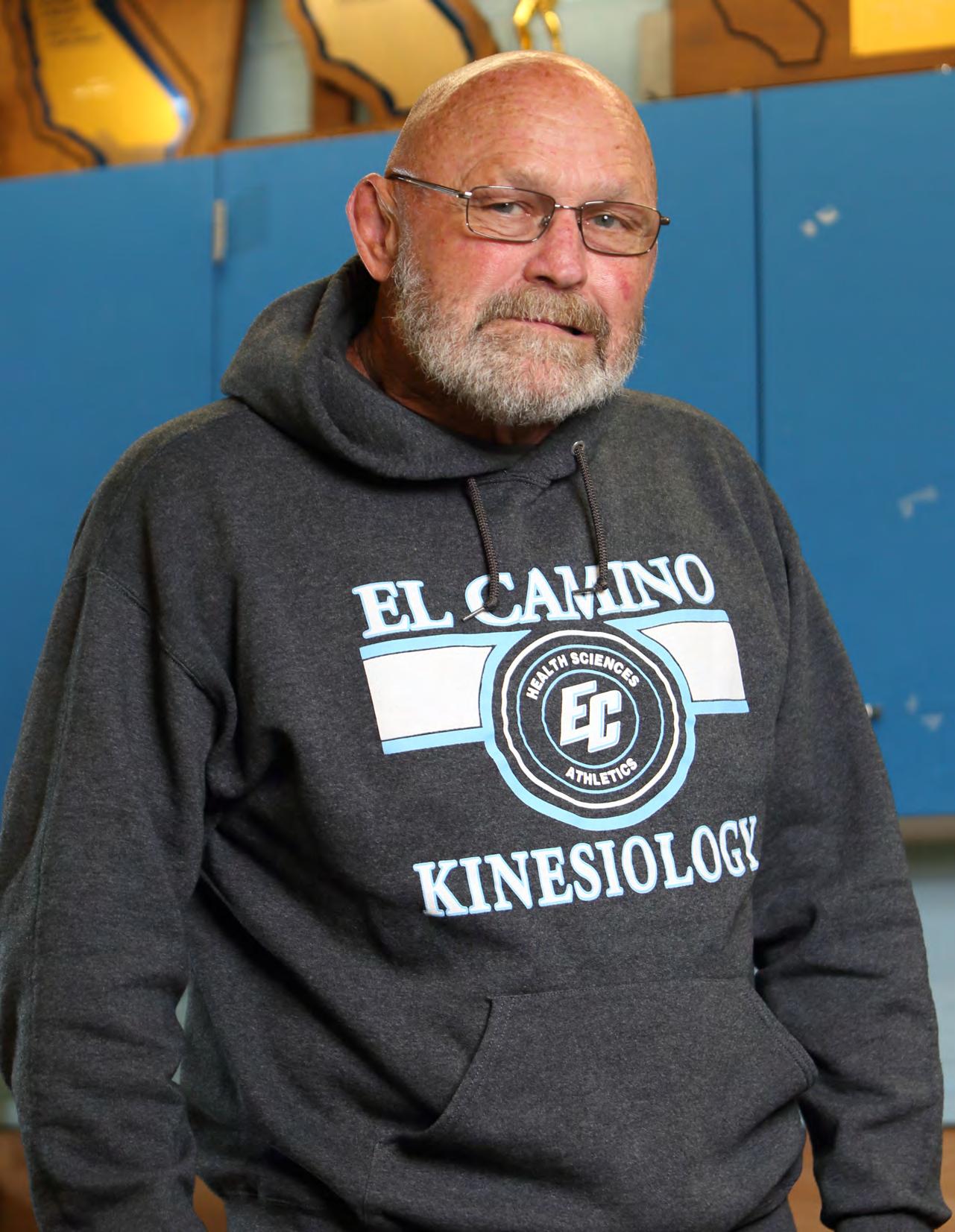
Warrior Life | 111
Camino wrestling coach position.
The athletic director, Al Greenleaf, approved of Conway asking Hazell to come back and coach because of the legacy Hazell had left at El Camino.
Hazell was a trustworthy candidate who could continue the success for the Warriors wrestling team and take strides in the program’s success.
Hazell was ecstatic, still having love for El Camino. For the first two weeks, Hazell would drive from San Diego, where he was still teaching, to El Camino where he would coach after teaching.
Hazell realized his future would be to teach his passion and says it was his “easiest decision of his life.” After two weeks Hazell went full-time to coach wrestling at El Camino, and left the job in San Diego.
Hazell fulfilled his hard work for his players holding the title of wrestling coach for 12 years at El Camino.

After 12 years of coaching at El Camino the wrestling program was dropped because Hazell was not able to coach anymore. He had been thrown to the ground while wrestling and hit his head.
The doctors told Hazell that he had to stop
wrestling or else he would become paralyzed and had to step down as the head coach.
This changed Hazell’s whole life. His life has revolved around being physical and having to wrestle. Hearing this news destroyed him.
Hazell had a talk with the dean and the athletic director and they told him they were going to look for a new coach, but as soon as Hazell stepped down they dropped the program.
“And then they said ‘Oh, we’ll bring it back in a year,’ and they didn’t do it,” Hazell says. He took some time off, but continued to stay in the wrestling world as an official, adding to his abundant resume.
Then the wrestling coach at West High School, Ken Wyatt, who was Hazell’s assistant coach at El Camino while he coached the program, called and said he was leaving the wrestling coach job to coach his daughter in cross country and softball.
He took that job fast, to be back in the coaching scene without having to be physical, and his son attended the high school.
Hazell coached at West for 10 years and had success. His own son and teammates won all Americans, took third in state and had “a couple of
112 | Warrior Life
El Camino College fitness instructor Tom Hazell displays his State Championship trophies in his office. Hazell was on the El Camino wrestling team in 1971-’72 and wrestling head coach from 1979-’91.
other state winners.”
Hazell made his way back to El Camino full time where he was hired as a fitness instructor, teaching Physical Education 10A and 10B.
“Well if I love doing it, I might as well get paid for it,” he says.
Hazell decided to come back to El Camino because “It feels like home to me, all the old connections, and my [daughter],” Hazell says of his daughter, Liz Hazell, who is the head coach for the women’s volleyball team at El Camino and has been for four years.

The family has always been competitive in their respectful sports lives, and drive each other to succeed.
Hazell says wrestling means so much to him because “getting the endorphin pop and giving you that high for a second with how much empowerment is in wrestling.”
It frustrates him to not be able to wrestle and not get the rush through his veins - the reason he’s always been a part of wrestling.
Hazell has always credited his coaches for his success and says his coaches supported him and
put him in a great training program.
Myron Miller, who was the assistant wrestling coach at El Camino during Hazell’s time noted his success based on how coachable Hazell was.
“It was easy for sure because anyone who is coachable and puts in the hard work outside of the real work will be successful, so he was,” Miller says.
Miller is credited with having a great coaching influence on Hazell.
“Hazell would meet me after hours at community colleges,” Miller says. “Because of his head down and work mentality, he constantly was getting better.”
At the end of Hazell’s time in wrestling he was inducted in the National wrestling Hall of Fame, and then the California Hall of Fame in 2015. Hazell felt honored that he was seen as having a huge impact on wrestling.
“Usually the best feeling in wrestling is being able to physically dominate your opponent, but getting the honor from your peers is nice.”
Hazell is not as inclined on being praised and receiving his honors, but will enjoy the accolades and support.
Warrior Life | 113
El Camino College fitness instructor Tom Hazell gives a cross-armed pose in his office. Hazell was head wrestling coach at El Camino for 12 years.
Bob the Dog reports on the best dog parks close to ECC
 Story by Bob with Kim McGill
Photos by Kim McGill
Story by Bob with Kim McGill
Photos by Kim McGill
114 | Warrior Life
umans across SoCal love dogs.
I know this because I’m a dog named Bob living in Watts, and the city of L.A. spends more to protect stray dogs than it does to protect young people. (Really. Save the humans.)

Still, it can be hard to find a safe and fun place to play – free of leashes, traffic and those scary mail carriers armed with pepper spray.
So, for pits, pugs and Pekingese, here are the best bite-free bets for pets. (And you can take your humans too.)
1. Best spot ever invented –Rosie’s Dog Beach
Rosie’s is the only legal dog beach in L.A. County. No fear of ducking and dodging expensive ticketing by cops or lifeguards here. This place is pure magic. The dogs are nice, not aggressive. (The ocean and sun chills everyone out.) You can run off leash all you want, flee from the waves or splash in the sea, dig deep holes – a great way to cool off on hot days – swim or surf or kick sand in the face of your humans. Just don’t poop in the water.
Tips: There’s a cement bike and running path here, but for that part, you have to be on leash. The fresh drinking water is close to the parking lot. With a fairly long walk across the sand to reach the ocean, tell your humans to carry some water. This is one of the few dog parks that has bathrooms for people. There are also outdoor showers where both dogs and people can rinse off the sand and sea.
6 a.m. – 8 p.m. 5000 E. Ocean Blvd., Long Beach, 90803 Plenty of metered parking in a huge lot.
2. Runners’ paradise –Redondo Beach Dog Park
This place is extra huge and wide open. Without any trees to crash into, it’s the favorite spot of racers – dogs who run just for the joy of it, fliers so fast they leave dust trails in the sky, chasers of other dogs and balls and sticks,
Warrior Life | 115
jumpers and smashers and trick masters. In the back, right corner there’s an obstacle course – one of only two parks I’ve ever visited that had one.
Dawn – 9 p.m.
190 Flagler Lane off 190th St., Redondo Beach, 90277
Free parking in a lot and on the street.
3. For gossip and gabbing – Home Run Dog Park
Dogs and humans love this place. Humans bring their folding chairs and spend hours lounging. Everyone introduces their dogs. When stuff gets hectic – as in a dog that keeps trying to mount you no matter how many times you grrrrr - humans actually take responsibility. Either they step in and pull their dog away or the other people there will scold them until they manage the problem. There are beautiful trees that offer shade on a hot day. Wood tables provide places for dogs and humans to sit, and if you’re lucky, to get a snack. I’ve seen several dog parties here with decorations. Time stops and you forget you have real-life responsibilities.
7 a.m. – 8 p.m.
20357 Studebaker Road, Lakewood, 90713
Free parking on the street
4. Best spot to chill – Uptown Dog Park
Longest hours anywhere for a late-night spot. This is a calm, beautiful and carefree little park surrounded by a larger park for your humans, a great place to come if you and your family need a break from a hectic schedule. After heavy rains, one small area might turn into a big puddle. But that can be fun too if you’re into mud baths.
Dawn – 10 p.m.
4600 Long Beach Blvd., Long Beach, 90805
Free parking on the street.
5. Top park for your human – Polliwog Dog Run

It’s often referred to as a dog park, but that’s an exaggeration. It’s just a narrow strip of ground. It’s operated by Manhattan Beach Parks and Recreation, and they call it a “dog run.” It also has all sizes of dogs in the same place.
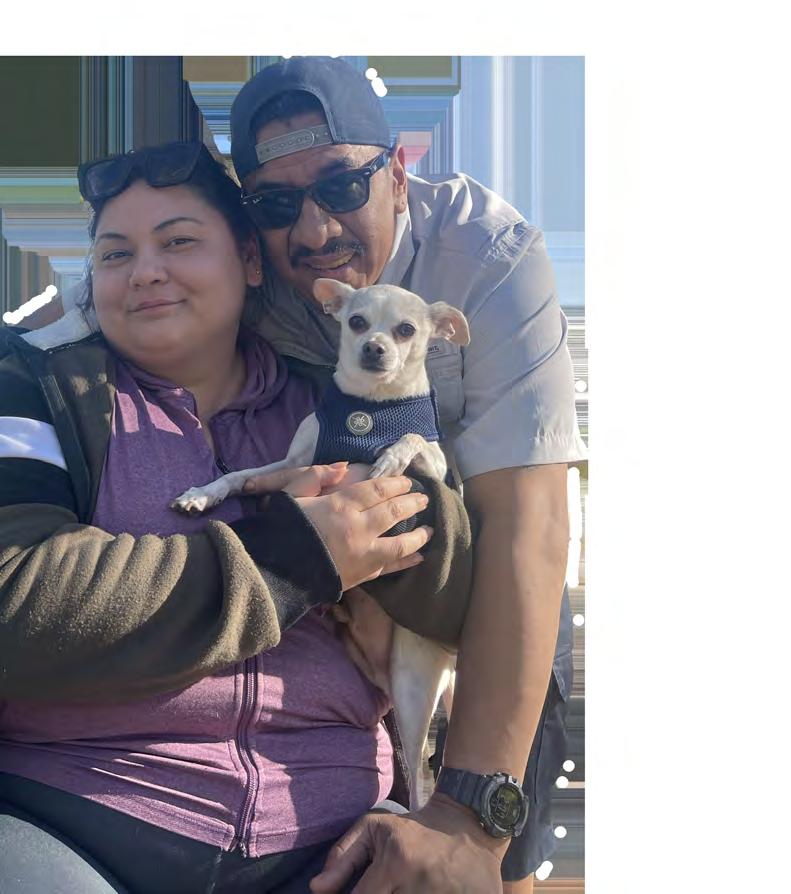
But dogs always put our humans first and Polliwog Park is a great place for people tiny and tall. There are eight acres of grassy hills that I actually ran and tumbled down, a big lake with fountains and ducks, an outdoor theater and a little place they call a Botanical Garden that you can walk through filled with wildflowers, butterflies and squirrels.
6:30 a.m. – Sunset
At the top of the hill on the west side of Polliwog Park Redondo Avenue and Manhattan Beach Boulevard, Manhattan Beach, 90266
116 | Warrior Life
Roo and his family - Jen (left) and Jess - at Uptown Dog Park in Long Beach, Calif. on Jan. 17, 2023. Kim McGill | Warrior Life
Most promising - Ross Snyder Dog Park
Poor dogs, like poor people, get a lot less resources. It’s not fair that some dogs have to travel so far to other cities to get a park.
The east side of South Central L.A. just opened its first dog park operated here by Los Angeles City Parks and Recreation.
This dog park doesn’t benefit from all the funding, staffing and support that the other parks listed in this Top 5 get that are located in wealthier communities. Comparing it doesn’t seem fair. But here I go anyway.

Because I live close to this park, I want it to be great. There is a drinking fountain with fresh water and trash cans with plastic bag dispensers attached. It’s clean. They planted new trees that will eventually grow.
But… the ground surface is astro turf, so that has me thinking – where does all the pee go?
It feels claustrophobic with a maze of fencing you have to walk through if you come from the main entrance to the park on 41st Street. I was dragged inside because I refused to get trapped in that fencing. It’s better to enter from the back of the park off East Martin Luther King Jr. Boulevard. People aren’t careful about closing the gates so you could escape if you’re a runner. On one side is a giant beige wall. I heard one human say it reminded them of a prison yard.
I have only met one other dog here in all the times I have gone, so I think other canines agree with me.
It’s at the back corner of the park behind two soccer fields. I loved running on the soccer fields more and messing up soccer practice. This is a great place to bring your humans if they like to play or watch soccer.
The recreation center also has youth sports leagues, an after-school program and a summer day camp but dogs aren’t allowed, so that’s disappointing.
Ross Snyder Recreation Center
1501 E. 41st St., L.A., 90011
Very limited free parking in a small lot. Parking on the street is also free but hard to find.
Dog Park Essentials
Ground surface that’s pawsitively comfortable, easy to clean and dries out quickly, such as sand, packed dirt or low-cut grass. Avoid wood chips and astro turf.
Separate sections for big dogs and little dogs. Why do people expect a 16-pound dog with little legs to survive with a crowd of 80-pound pits, overly-affectionate Golden Doodles and rambunctious huskies? Those dogs run like they’re on meth.
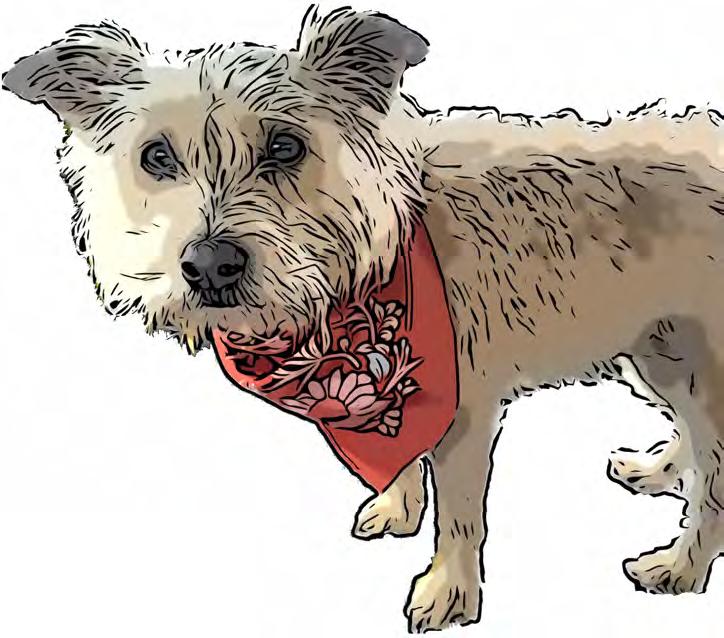
Double fencing at entrances with secure latching on both sides to protect dogs from bolting out into the street or unfenced sections of a park.
A fresh and clean source of water.
Maintenance and respect. Parks that aren’t free from s#*t should be avoided.
Waste carries diseases, worms and parasites that your dog can catch.
Posted rules are a good sign. Trash cans and plastic bags should be available in several locations. Signs should remind people to pick up after their dogs. We would do it but we don’t have opposable thumbs.
We are very clean and discreet animals when it comes to excrement. It’s bad enough we have to go in public.
Warrior Life | 117
Different countries, different me
How moving to another country affected my personality and my social life
Story and photo by Matheus Trefilio
My family made a big decision in April 2016, when we decided to leave Brazil for better job opportunities in the United States.

Even though I have only been living in the United States for seven years, it’s been enough time for me to change from the person I was in Brazil to the person I am now in America.
When I was younger I could not live without my friends. I always tried to make new friends, no matter if it was in school, or on the basketball team. I was enthusiastic and connected with a lot of different kids.
It was just my way of living life and I enjoyed it. I never wanted to stay at home, and always tried to make plans to have fun elsewhere, whether in malls, parks or my friend’s houses.
All of that changed when I stepped foot in this country. It is not because I didn’t want to move, as it was actually a dream of mine to be here for high school and college. I even prepared myself for it, taking English classes for years before the move.
I came in the last month of middle school. I was super nervous on my drive to the school, but that was because I was excited.
School is different here than in Brazil. There we stayed in one classroom, with the same 30 students, and the teachers were the ones who moved from class to class.
I met many people, but only stayed 50 minutes a day with them. The other students knew each other since their elementary school days, so it was hard for me to get into the groups, as I was still developing my English and could not communicate well.
My personality changed. I became shy and introverted, keeping things to myself. I stopped going out, except for team meetings for basketball and water polo.
The only people that I felt comfortable talking to were my
parents and my brother, which was different for me, as in Brazil I had many friends that I could talk to on a more personal level. The one positive that I take from this is that it made me more connected to my family, as I had to rely on them to be there for me, and for me to be there for them.
Sports were the one thing that kept me from completely locking myself out. The few friends that I made here in the beginning were my teammates and I had a lot of them, as I played football, basketball, and water polo in high school. Now I play water polo at El Camino College.
I hoped to have a fresh start after graduating from Peninsula High School and chose El Camino as a bridge to get used to college life, and having an easier adaptation at the four year college.
That did not happen though, as COVID-19 made everyone’s plans change. I will be transferring after spring 2023.
The Zoom life did not help me make new friends, as the only people that I got to know in the beginning from El Camino were my water polo teammates.
I love to meet new people and be able to connect to them. I do believe that those connections will help me not only on a personal level, but also on a professional level, as having a greater network of people could lead me to greater job opportunities, as I am studying journalism, a major in which connections are of extreme importance.
I do not regret moving to a different country. I do miss the people in Brazil. With the pandemic over, I am starting to get to know more people, and as my English is getting better each day, I am able to connect to those people easier than before, making stronger relationships.
118 | Warrior Life
Matheus Trefilio (far right) in 2015 with (L-R) brother Heitor Trefilio, father Everton Trefilio and mother Alessandra Gallo in Jundiai, Sao Paulo, Brazil.
Photo was taken six months before the move from Brazil to the U.S. (Photo courtesy of Trefilio family)
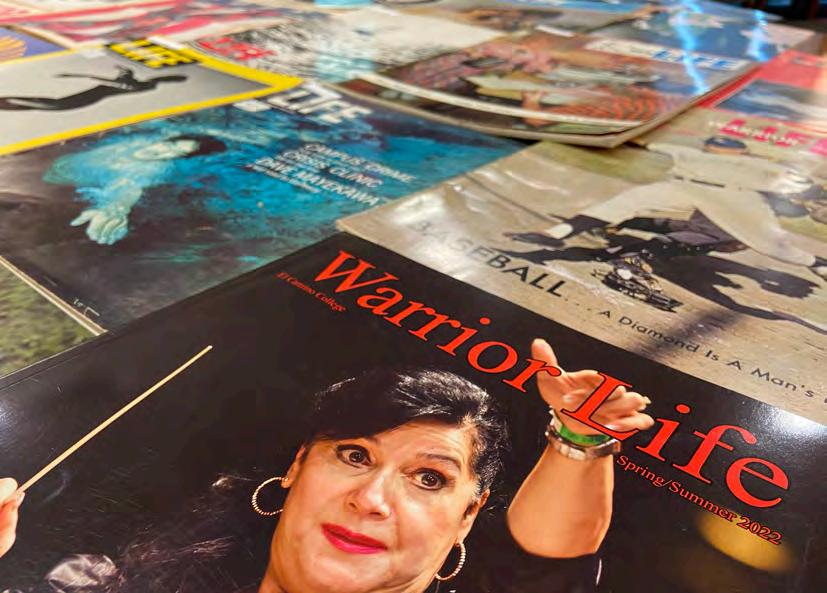
Register now in classes including JOUR 1, 6, 8, 9, 11, 12, 14 to guarantee a space! Email sfrith@elcamino.edu. Learn skills in newspaper and magazine production, design, photography and multimedia, including news, sports, opinion, social media writing and editing Fall PEN JOURNALIS 24 24 23 23 Spring Warrior Life | 119
OPEN JOURNALISM CLASSES








 (Top) El Camino College Assistant Director of Veterans Services Brenda Threatt acknowleges a fellow worker at ECC on an afternoon in Novemver 2022. She has a special California Department of Motor Vehicles license plate for having created a 9/11 commemorative license plate in 2001, that has generated $15 million in funds for victims and families of terrorist attacks. (Gary Kohatsu | Warrior Life)
(Top) El Camino College Assistant Director of Veterans Services Brenda Threatt acknowleges a fellow worker at ECC on an afternoon in Novemver 2022. She has a special California Department of Motor Vehicles license plate for having created a 9/11 commemorative license plate in 2001, that has generated $15 million in funds for victims and families of terrorist attacks. (Gary Kohatsu | Warrior Life)

 Story and photos by Kim McGill
Story and photos by Kim McGill


















 More than 100 people came out to “Run for Cookie” in Griffith Park on Oct. 16, 2022 to celebrate what would have been Juan Hernandez’s 24th birthday on Oct. 15. Kim McGill | Warrior Life
More than 100 people came out to “Run for Cookie” in Griffith Park on Oct. 16, 2022 to celebrate what would have been Juan Hernandez’s 24th birthday on Oct. 15. Kim McGill | Warrior Life









 (Above) (L-R) Guitarist Marcus Clayton, drummer Christopher Page and vocalist/bassist David Diaz perform as tudors at The Sardine in San Pedro early in 2023. The performance marked tudors’ first live gig since the 2020 COVID-19 lockdown of businesses.
(Above) (L-R) Guitarist Marcus Clayton, drummer Christopher Page and vocalist/bassist David Diaz perform as tudors at The Sardine in San Pedro early in 2023. The performance marked tudors’ first live gig since the 2020 COVID-19 lockdown of businesses.

 Kim McGill | Warrior Life
Kim McGill | Warrior Life






 Cafe owners Julius Obembe and Lucy Liampetchakul sometimes work with their 19-year-old son Dylan Obembe at Sausalido Cafe in Torrance.
Cafe owners Julius Obembe and Lucy Liampetchakul sometimes work with their 19-year-old son Dylan Obembe at Sausalido Cafe in Torrance.








 Story and photos by Alexis Ramon Ponce
Story and photos by Alexis Ramon Ponce






















 Story and Photos by: Ash Hallas
Story and Photos by: Ash Hallas






































 Andrew Cahner models for life drawing students at El Camino College in Torrance, Calif. on April 27, 2023. The skeleton on the left is a drawing of Cahner posing in class during the fall 2022 semester. Studying anatomy, including drawing the skeletal form, is a key component of classes at ECC. Kim McGill | Warrior Life
El Camino students struggle to draw from a photo on May 16, 2023, capturing only minor details. Kim McGill | Warrior Life
Andrew Cahner models for life drawing students at El Camino College in Torrance, Calif. on April 27, 2023. The skeleton on the left is a drawing of Cahner posing in class during the fall 2022 semester. Studying anatomy, including drawing the skeletal form, is a key component of classes at ECC. Kim McGill | Warrior Life
El Camino students struggle to draw from a photo on May 16, 2023, capturing only minor details. Kim McGill | Warrior Life





 Student supplies are laid out during a life drawing class at El Camino College on March 21, 2023. Kim McGill | Warrior Life
Student supplies are laid out during a life drawing class at El Camino College on March 21, 2023. Kim McGill | Warrior Life
















 Story by Bob with Kim McGill
Photos by Kim McGill
Story by Bob with Kim McGill
Photos by Kim McGill




































